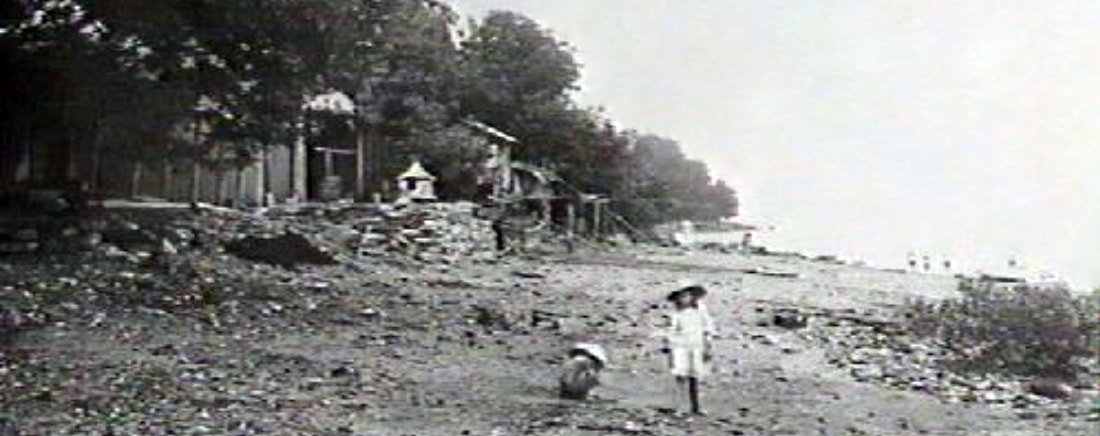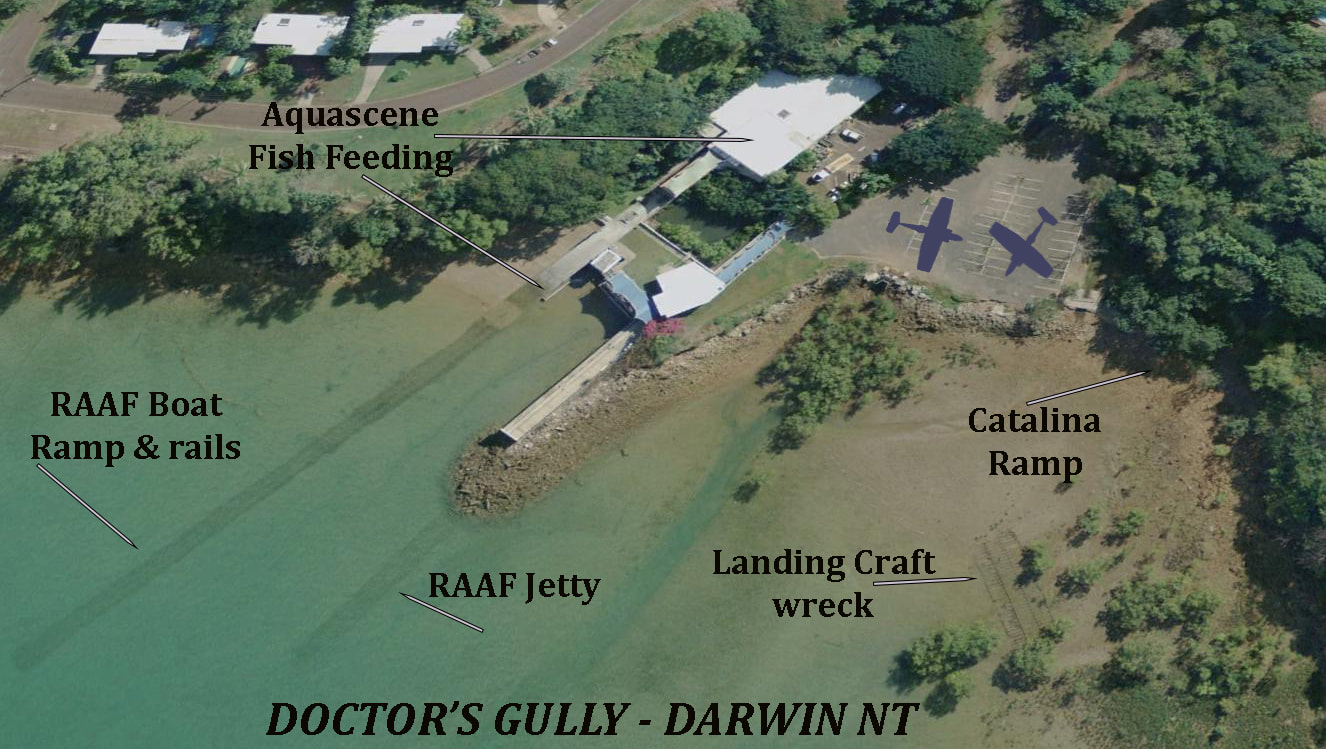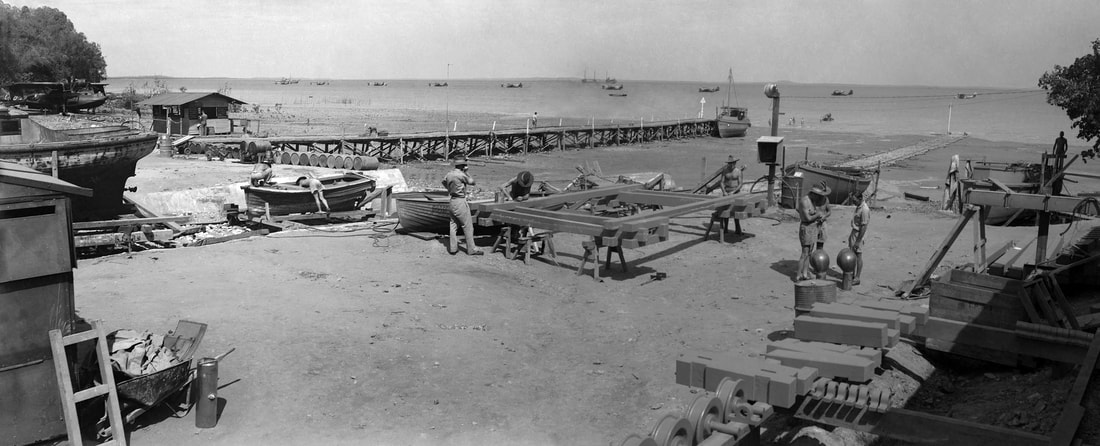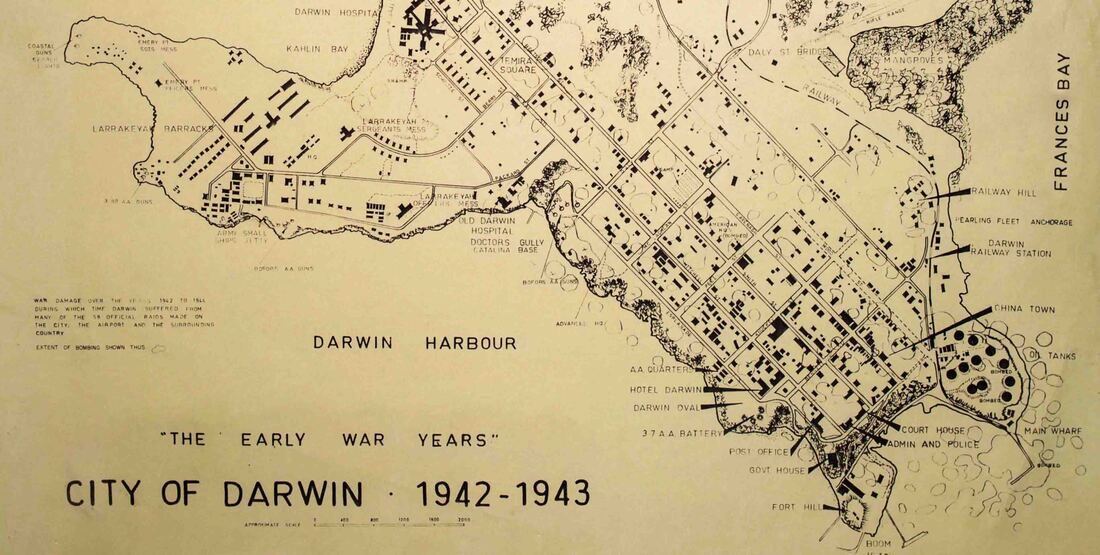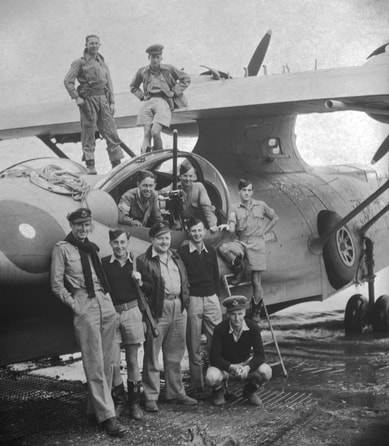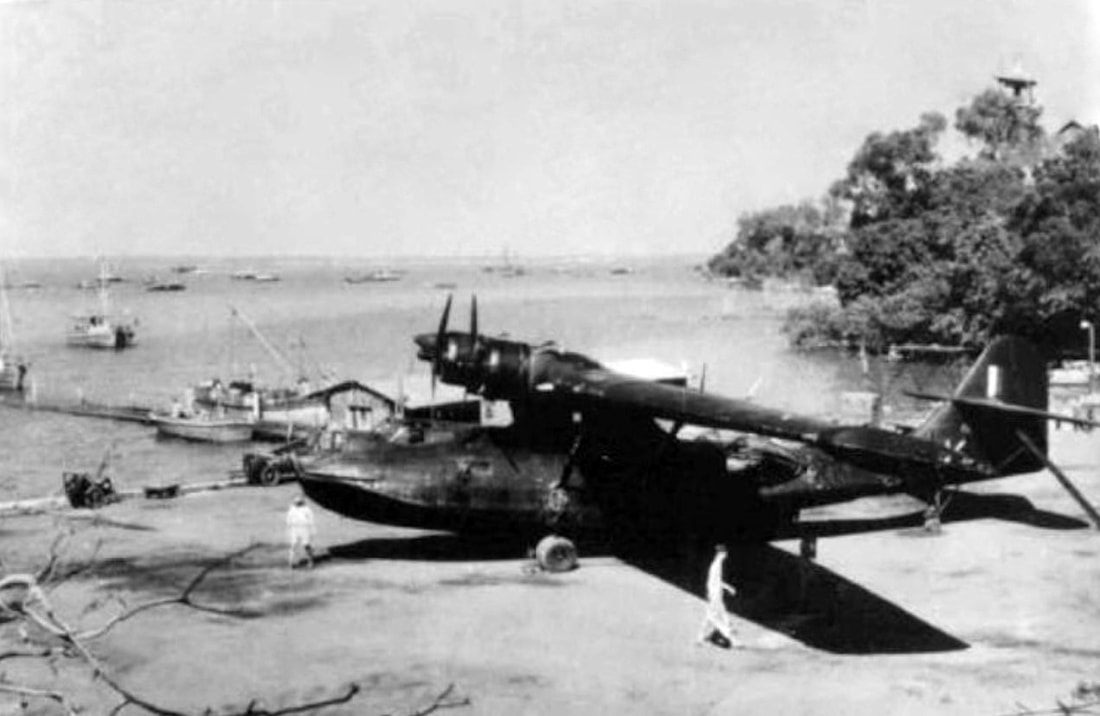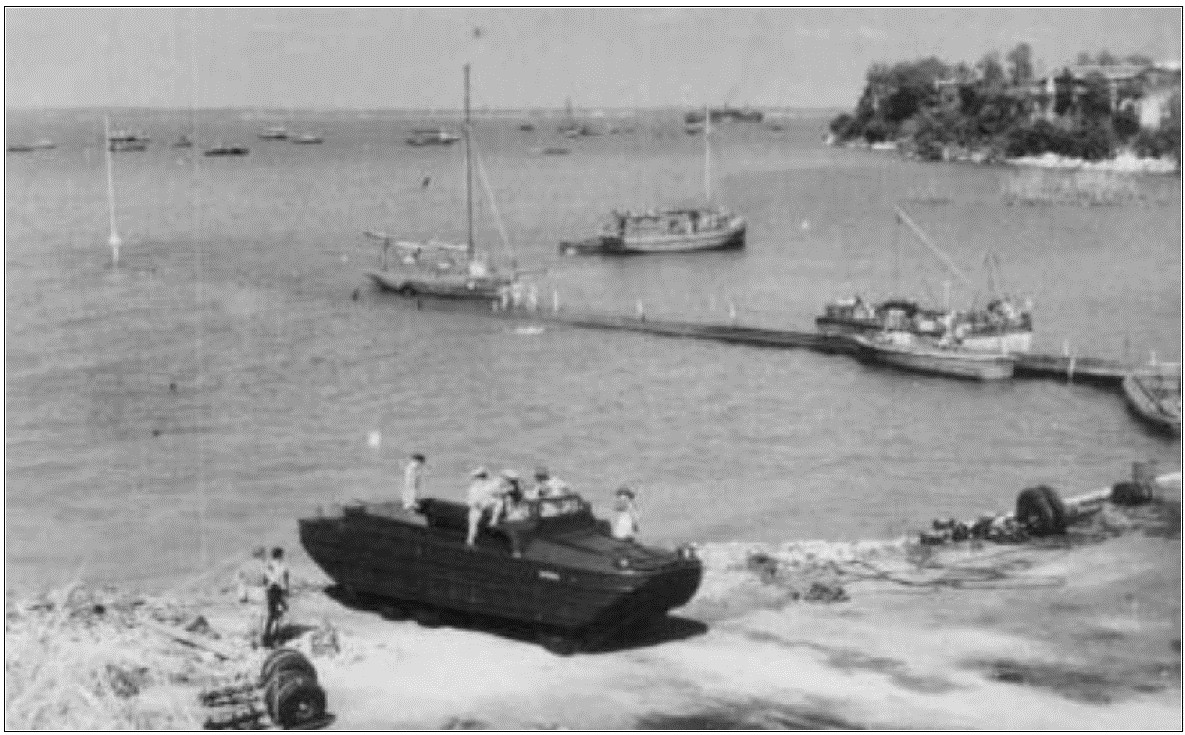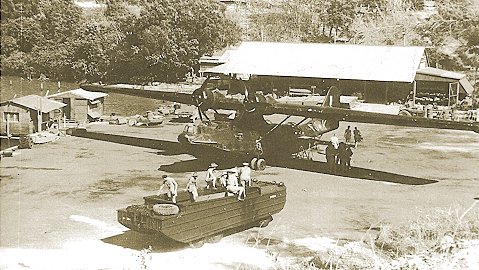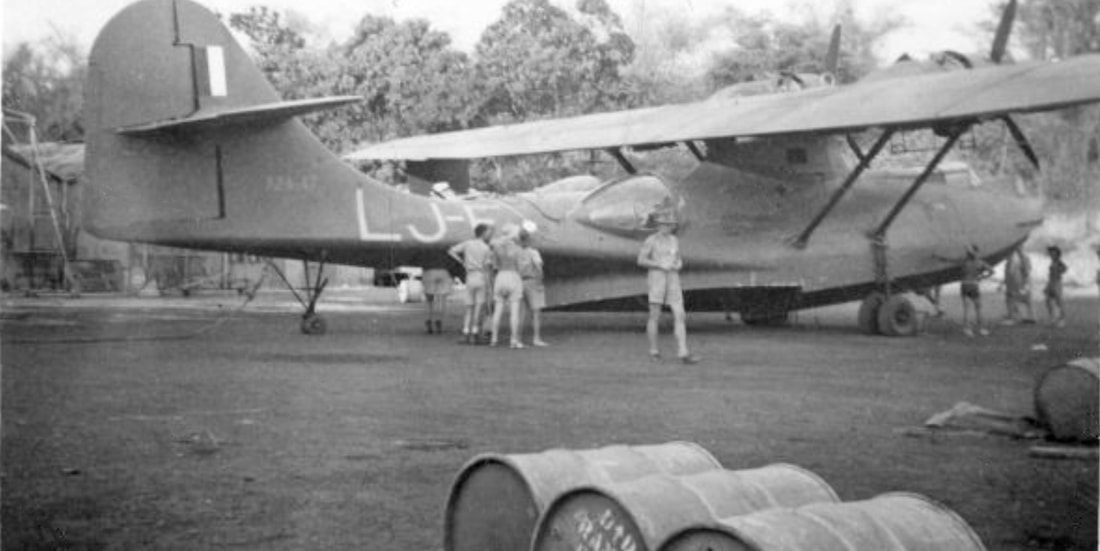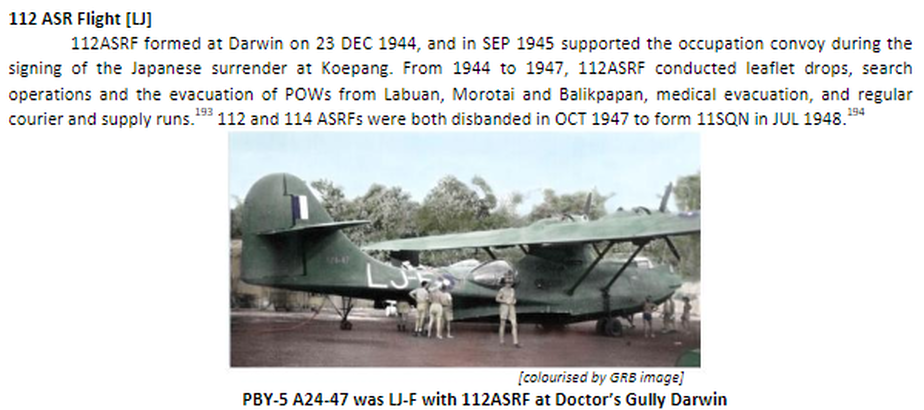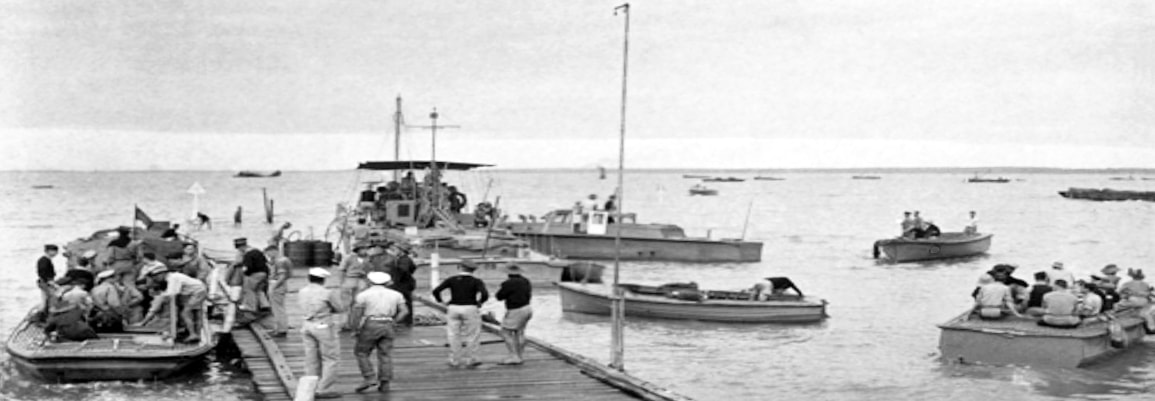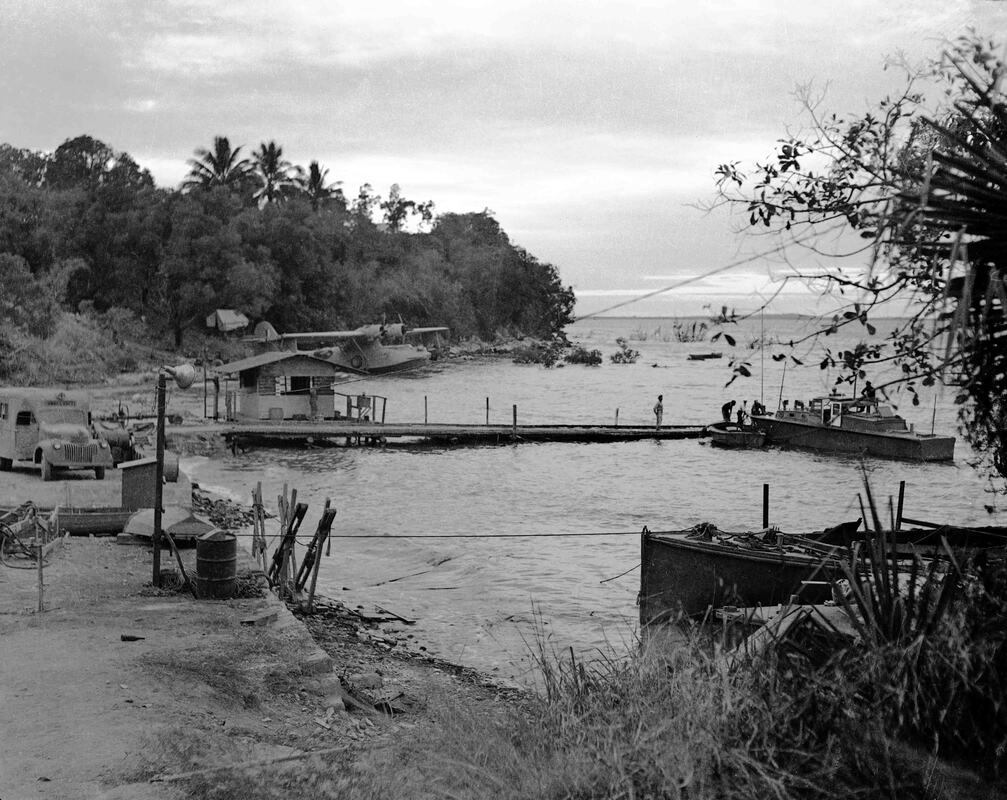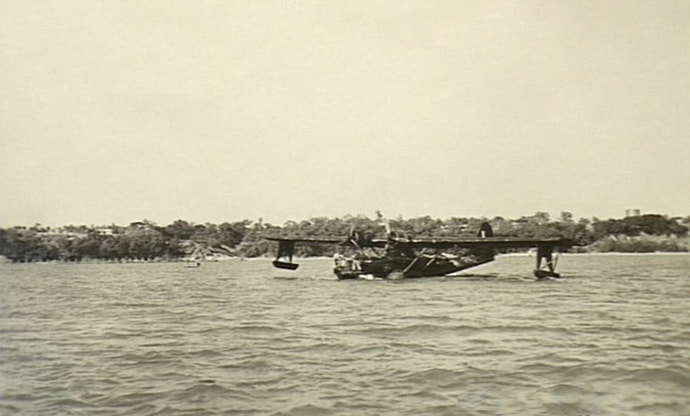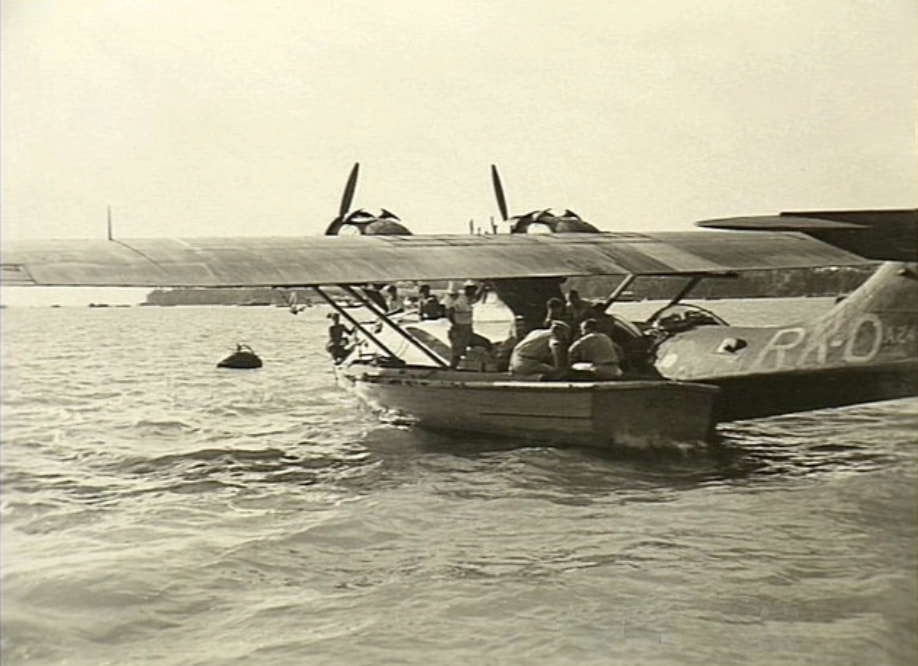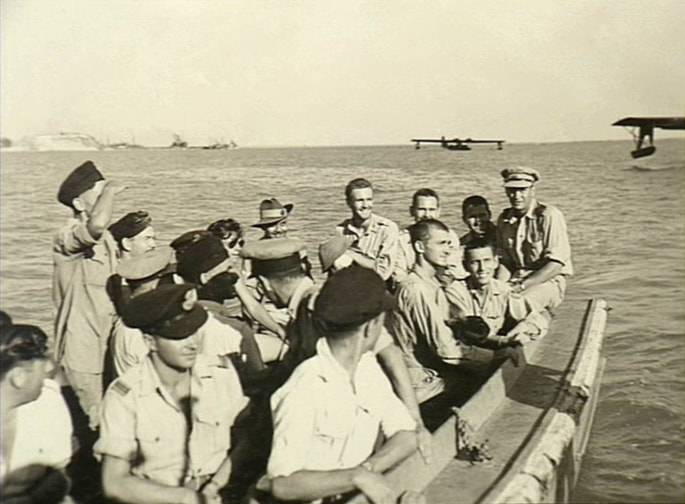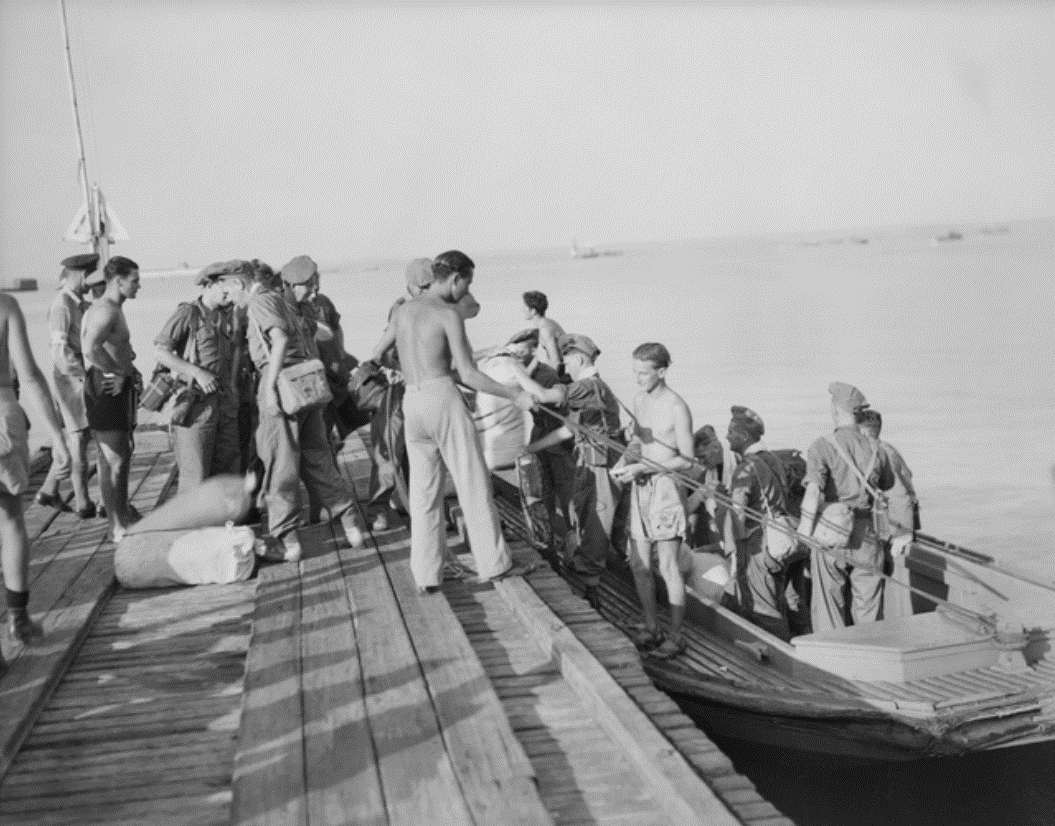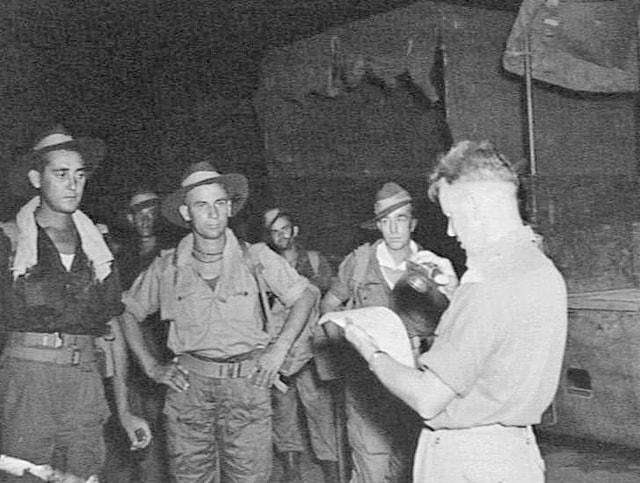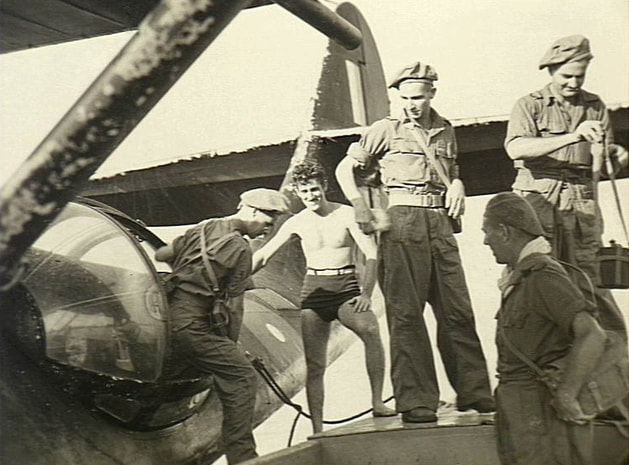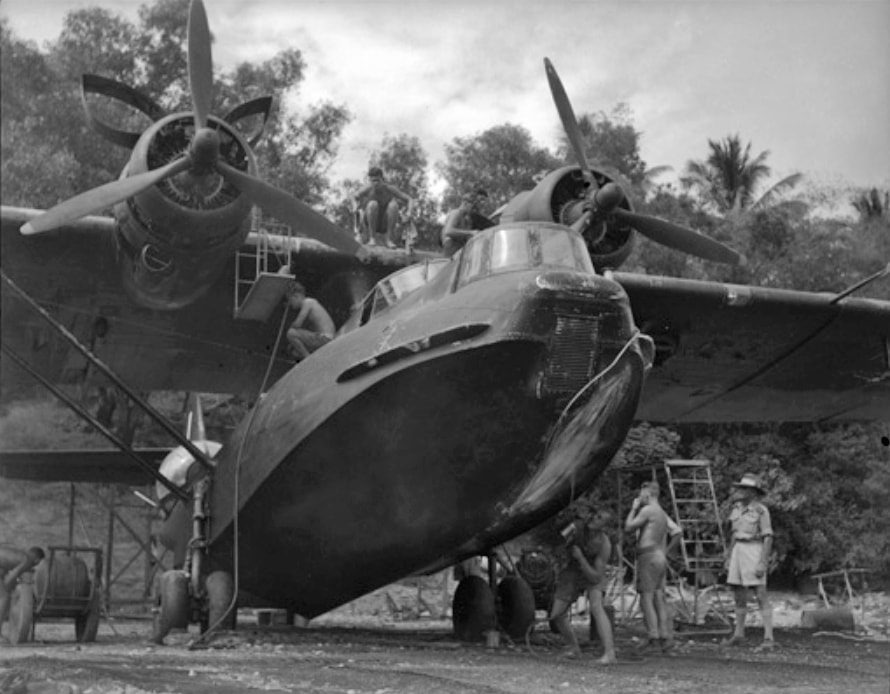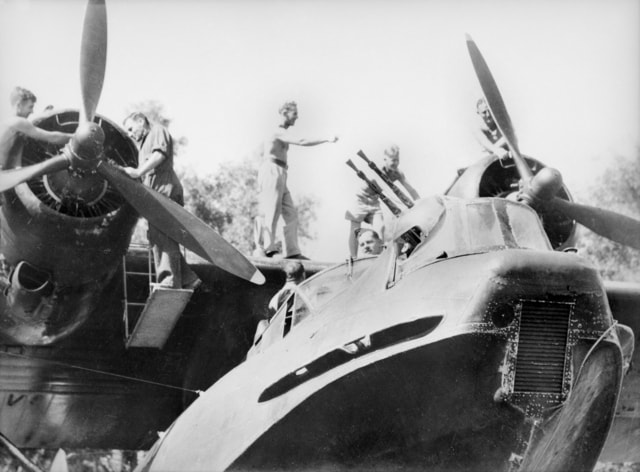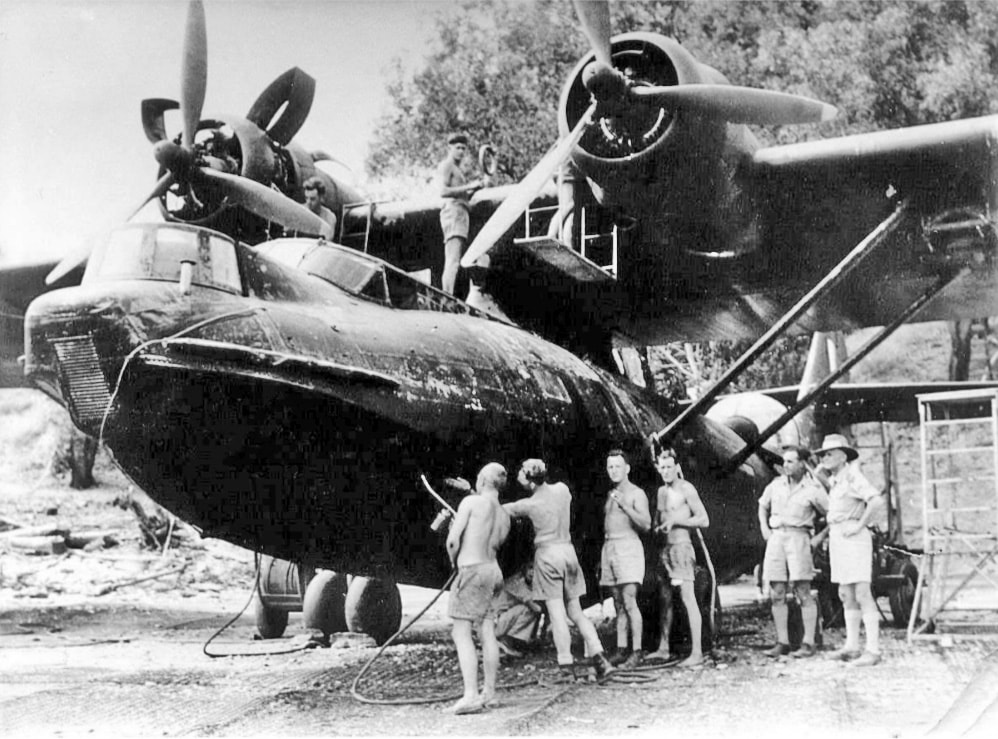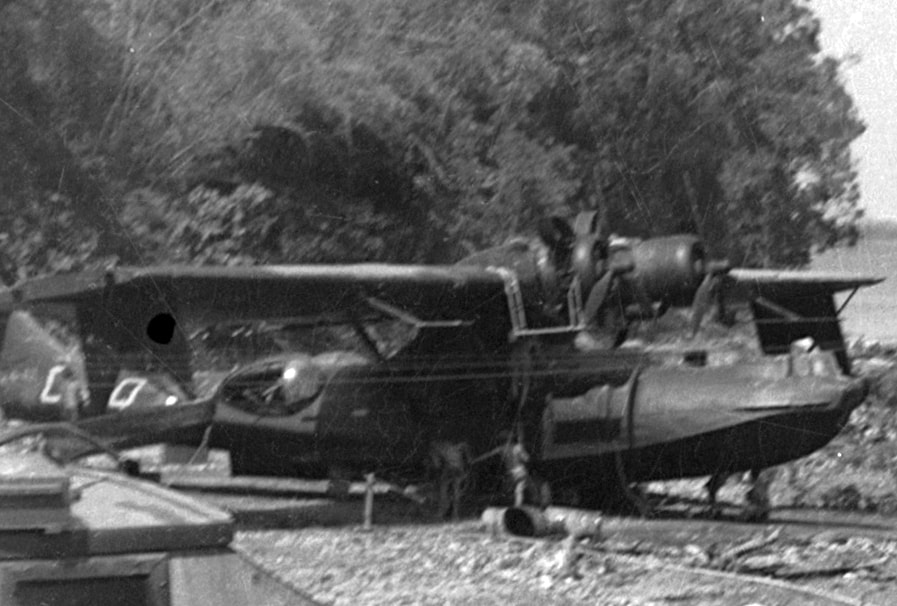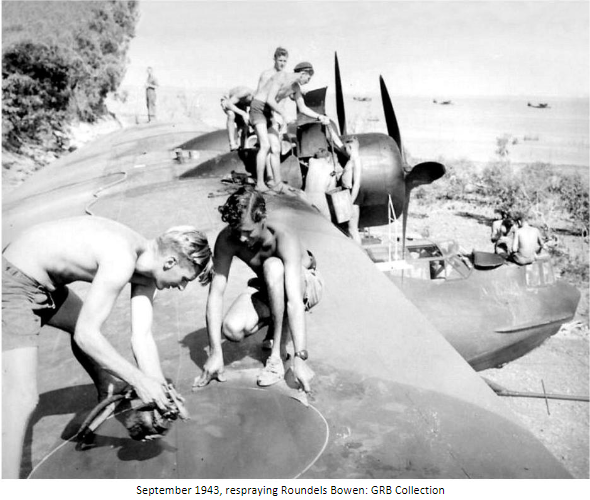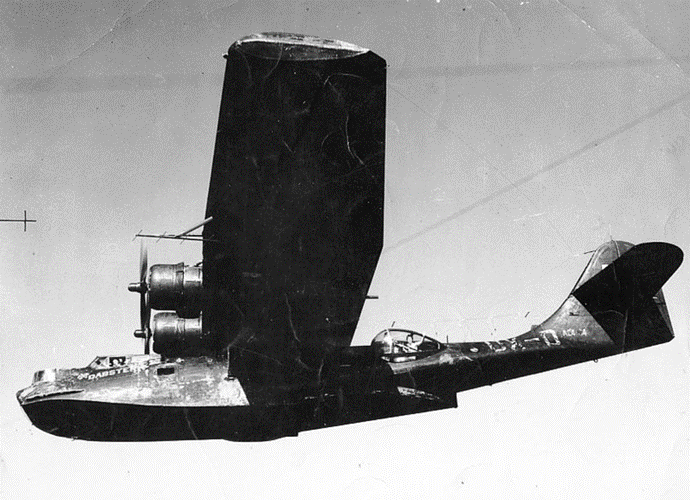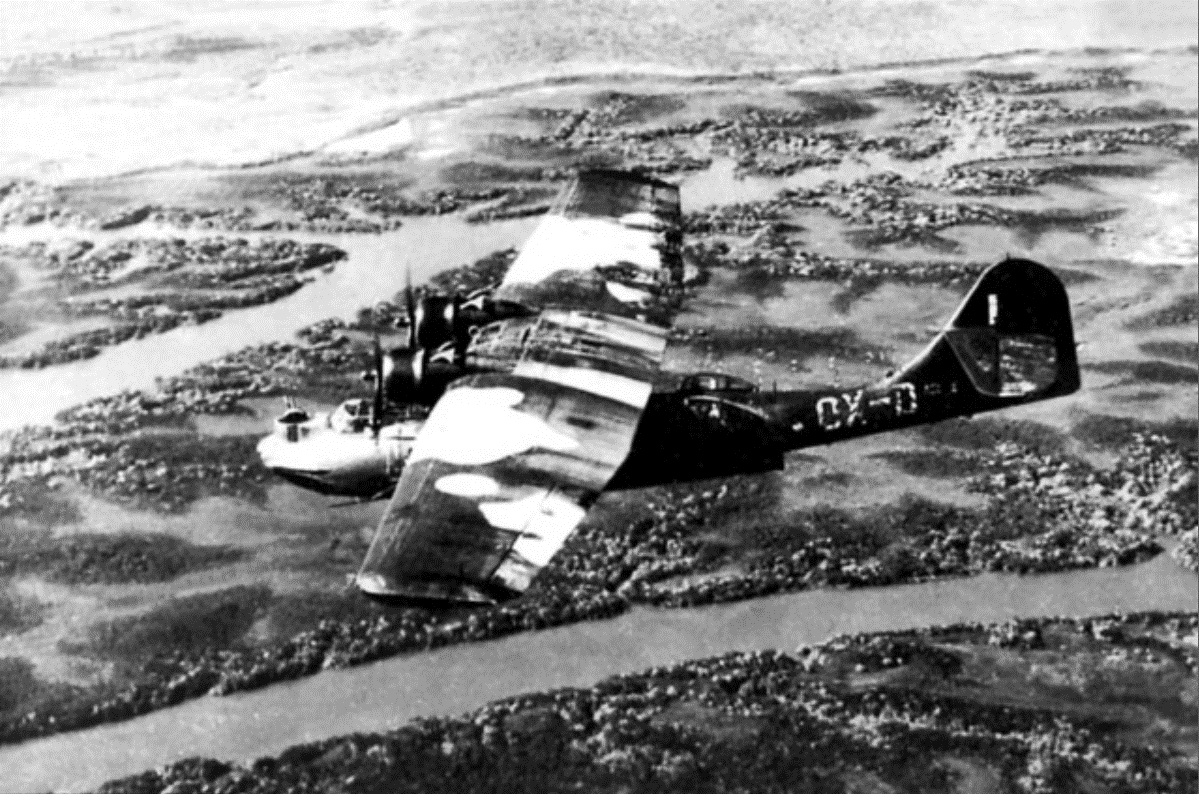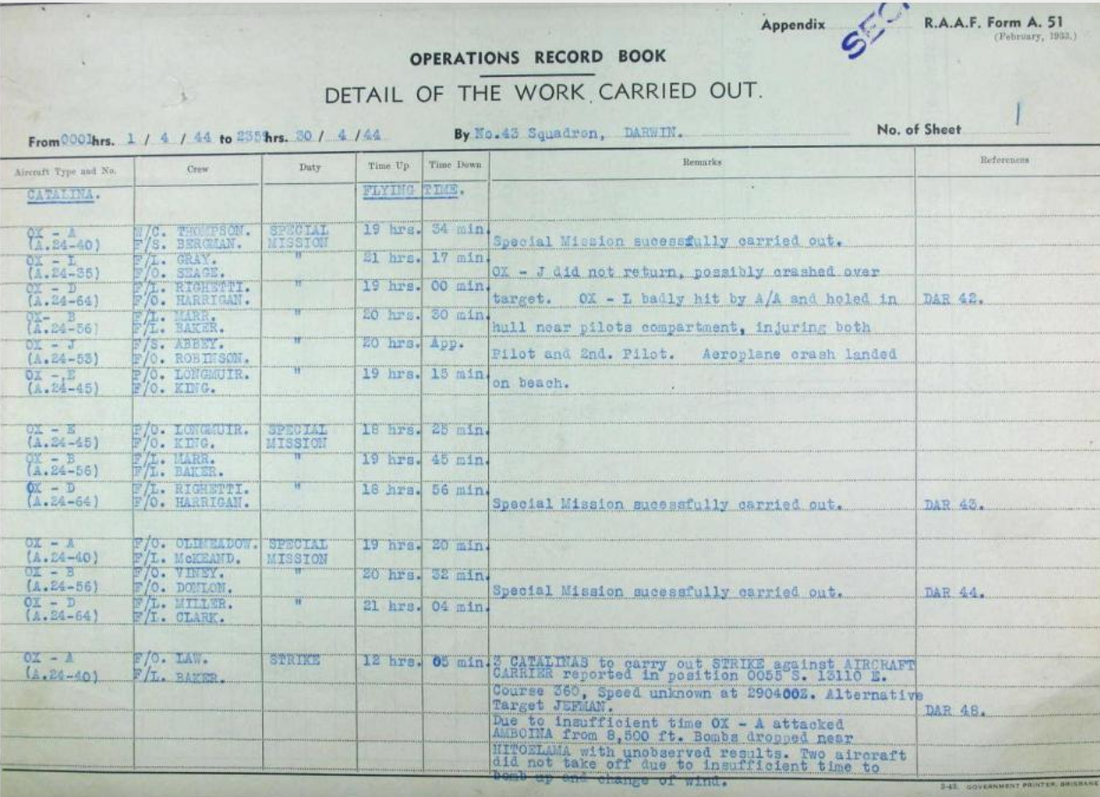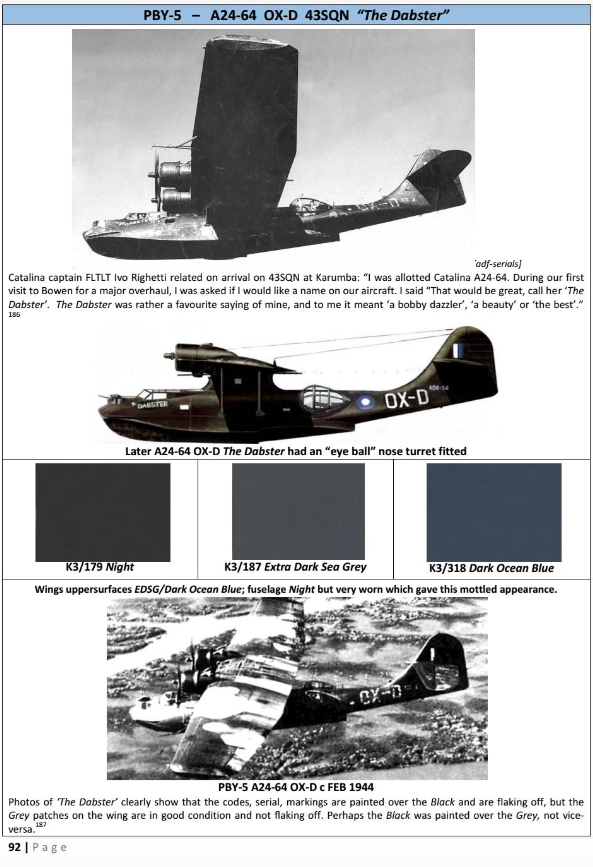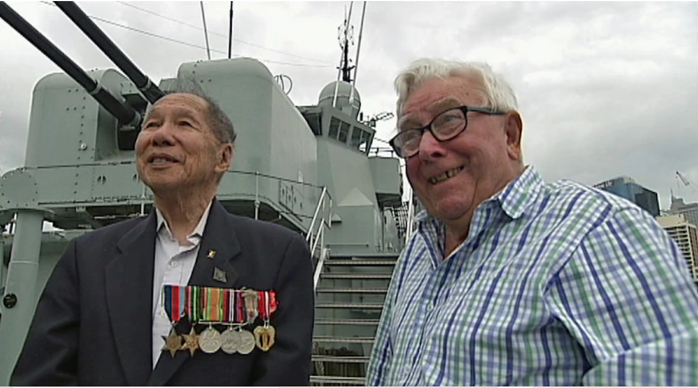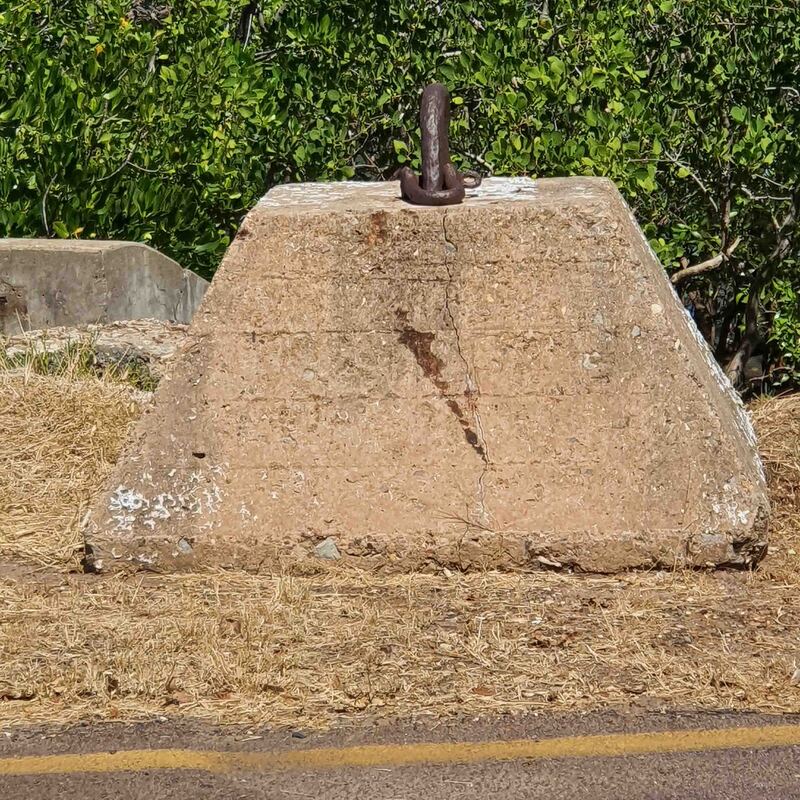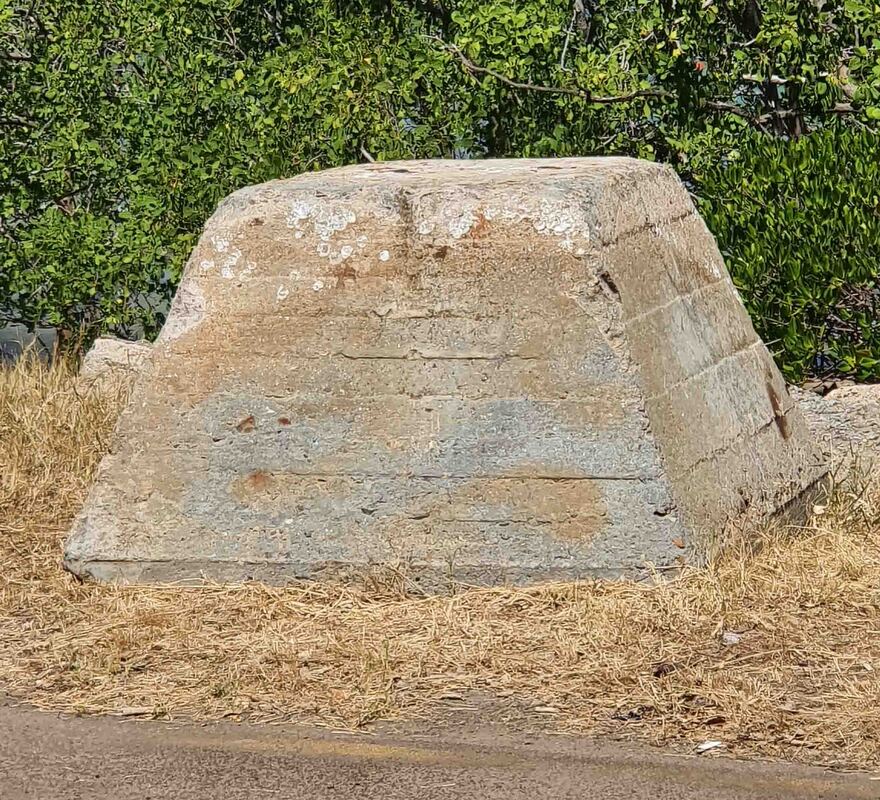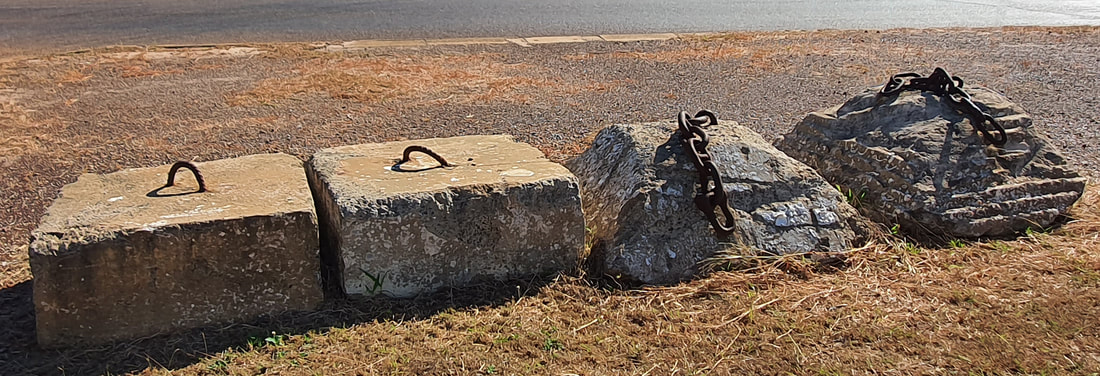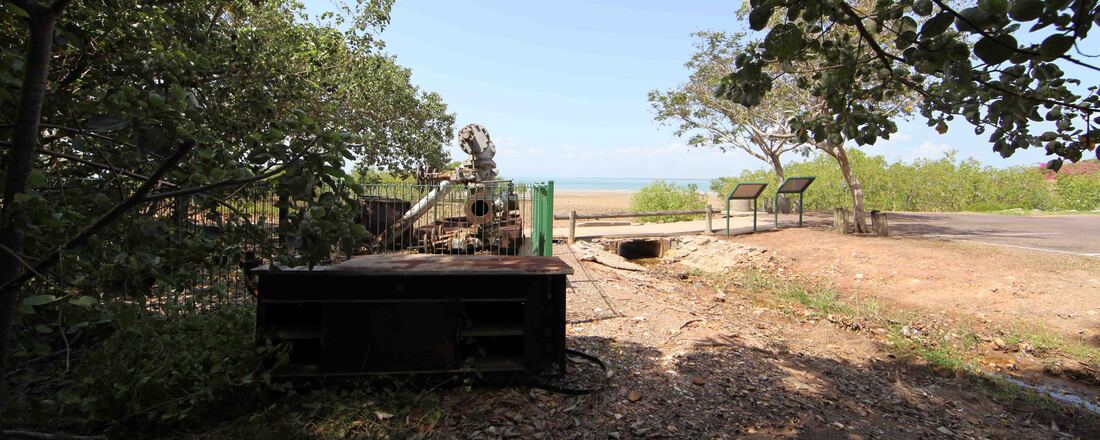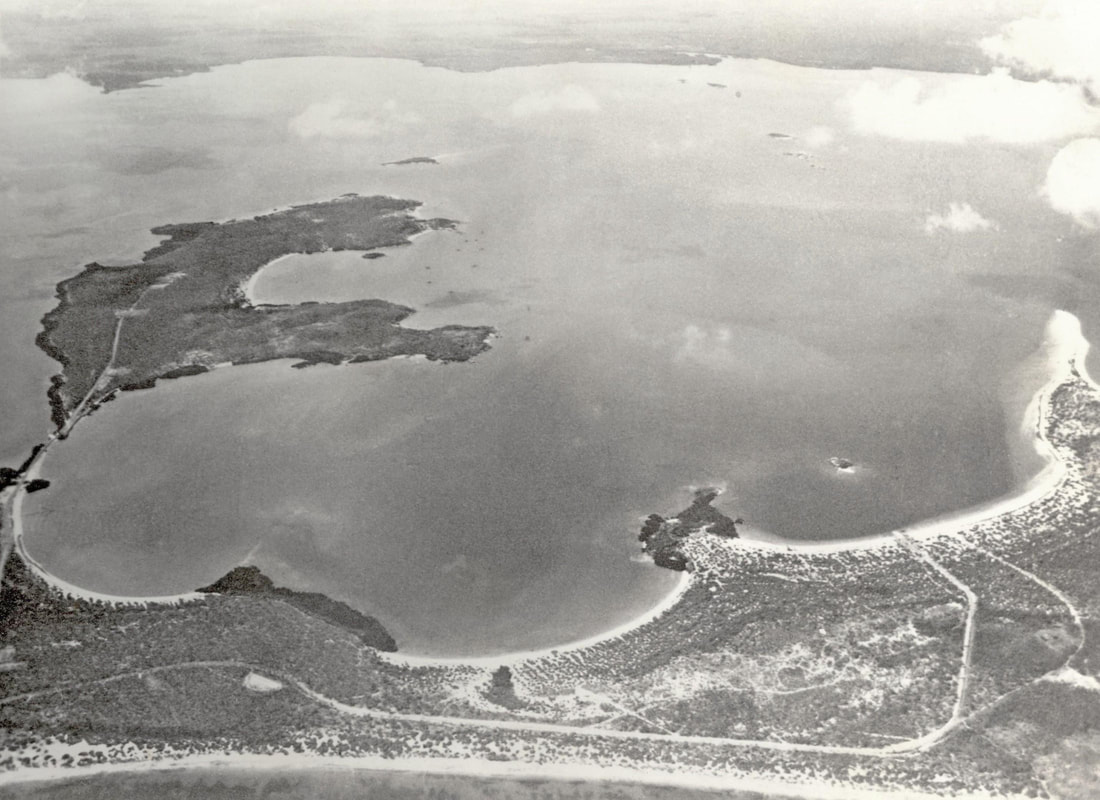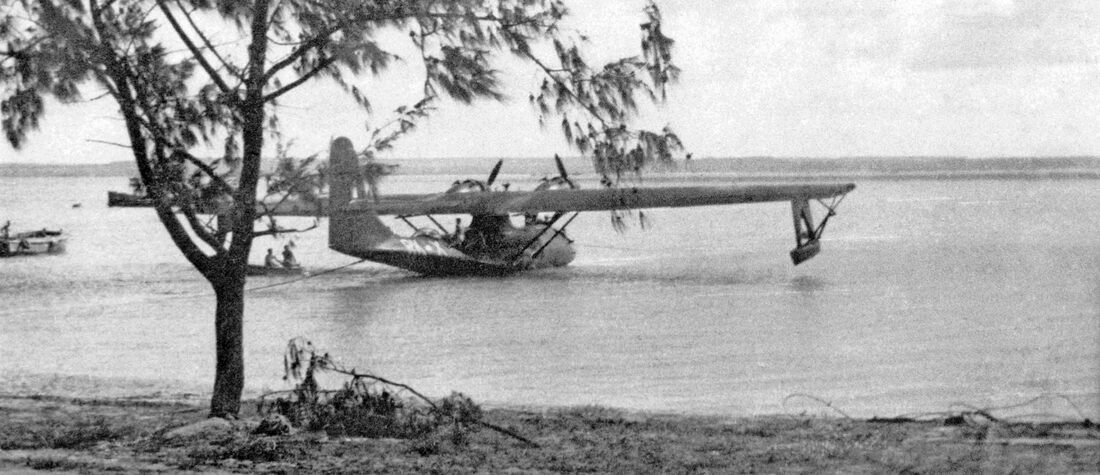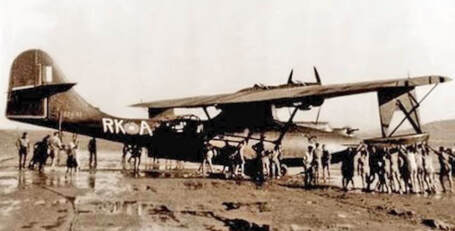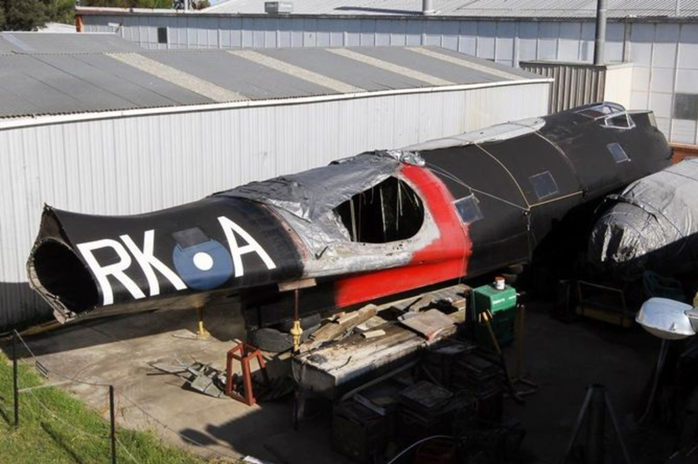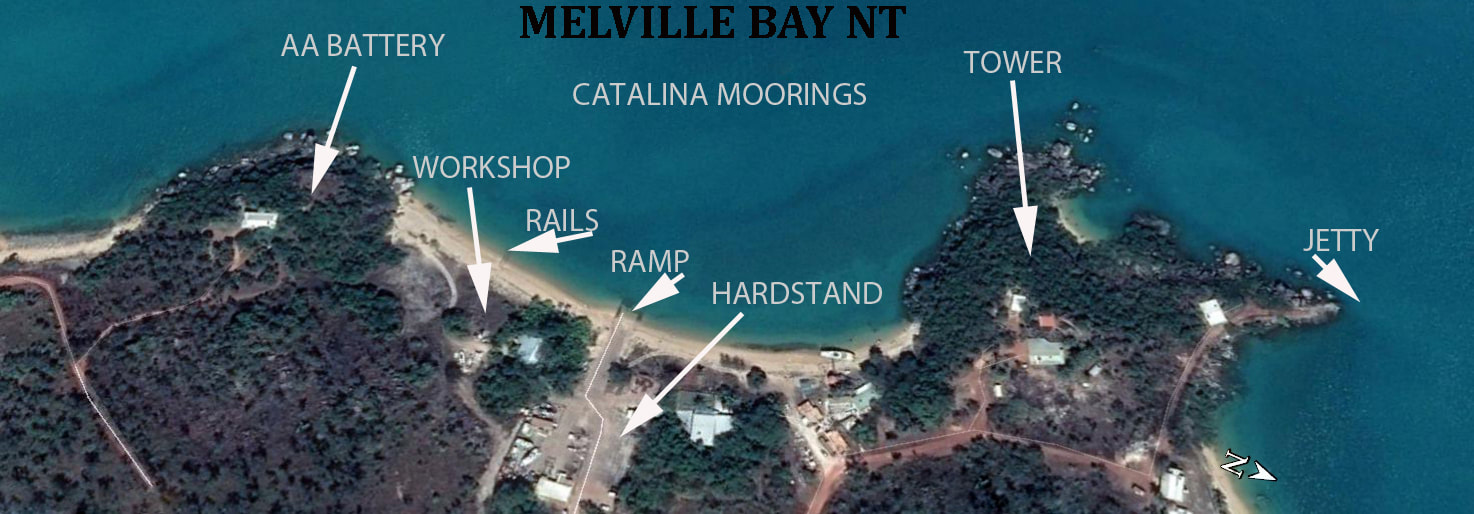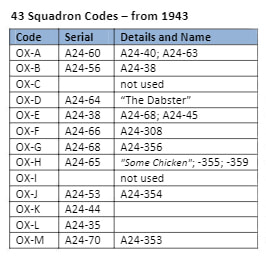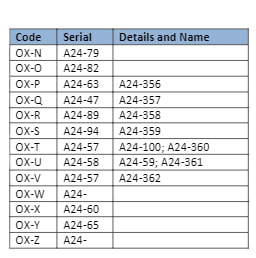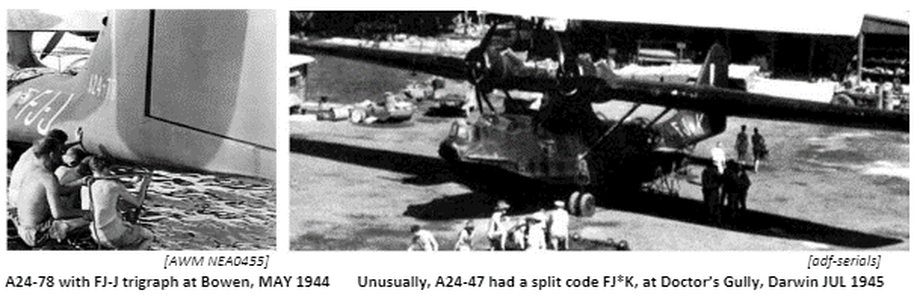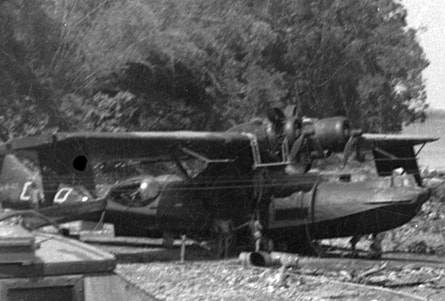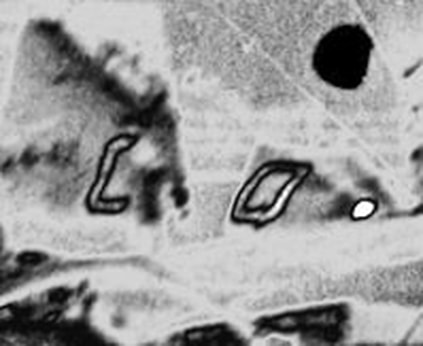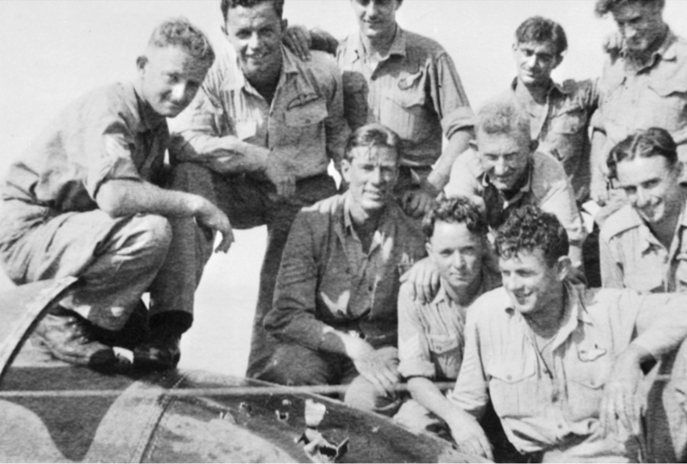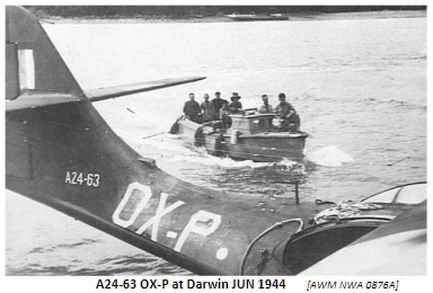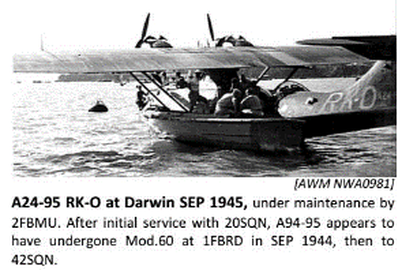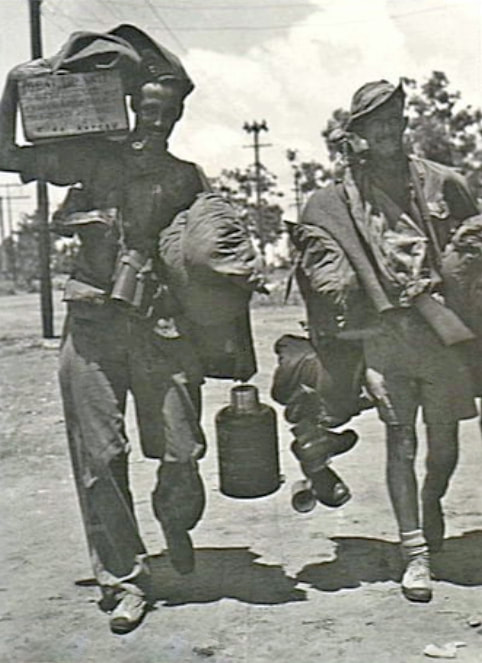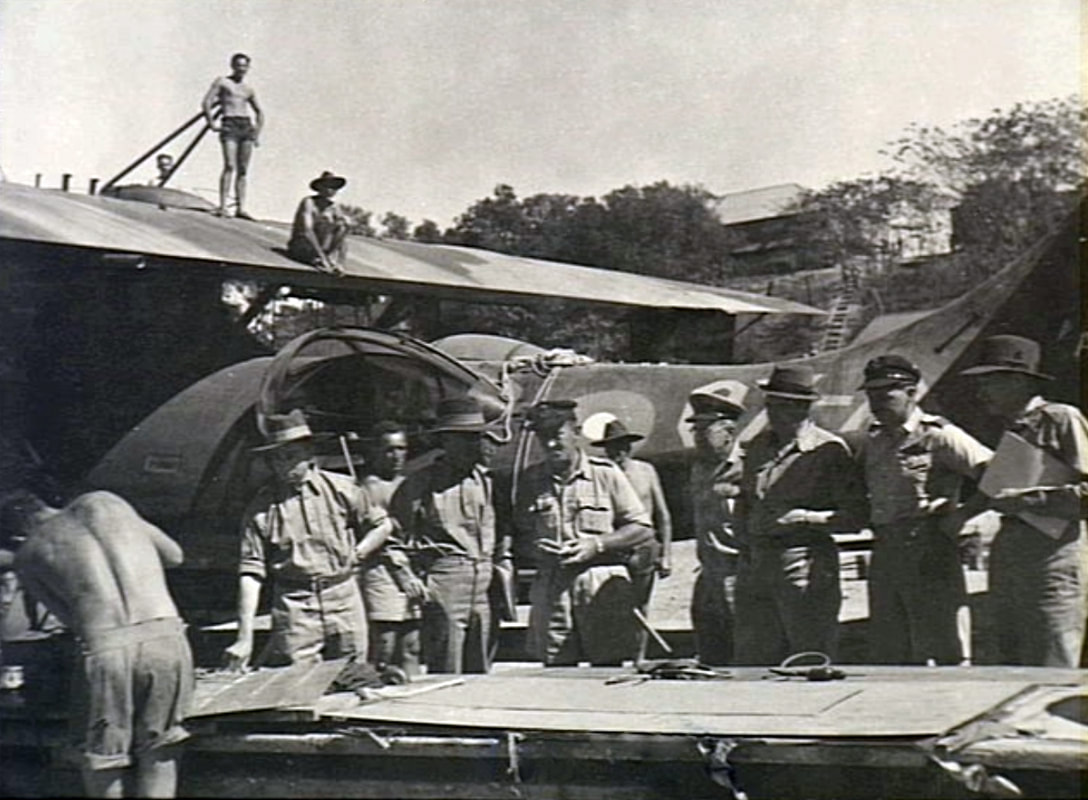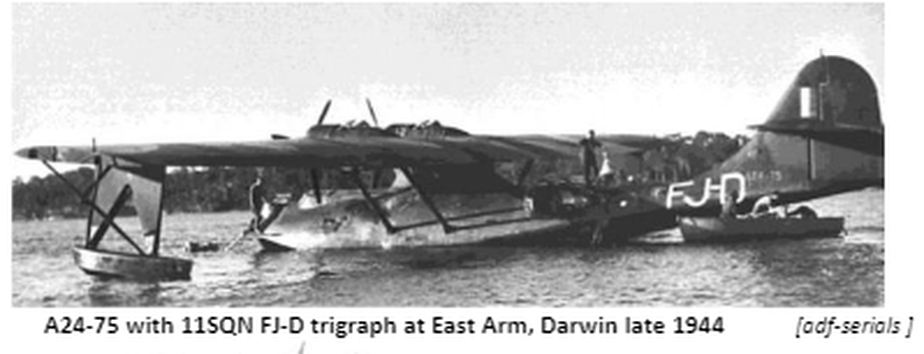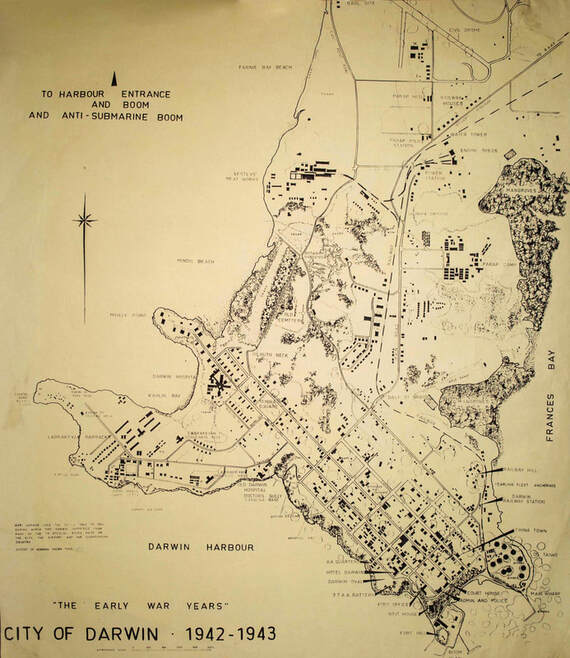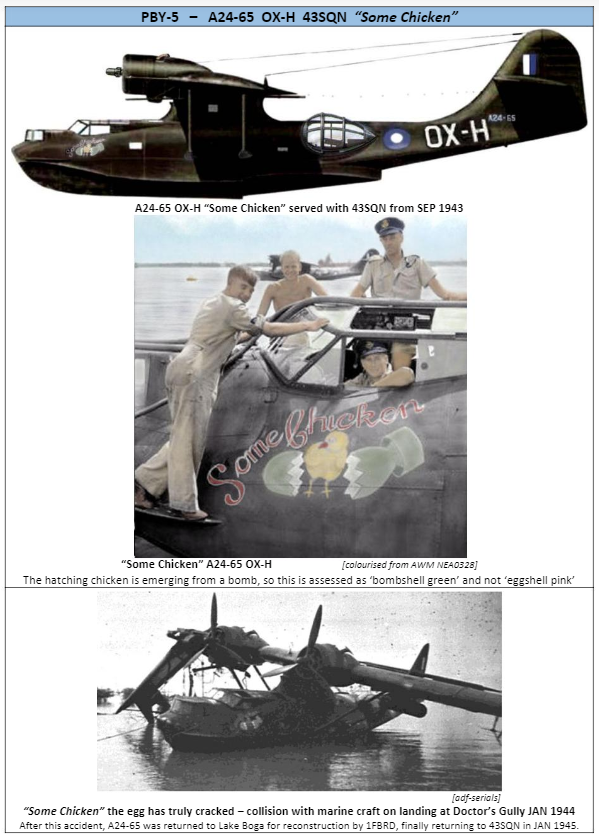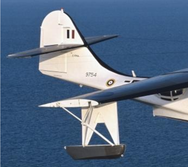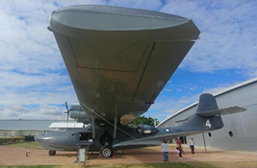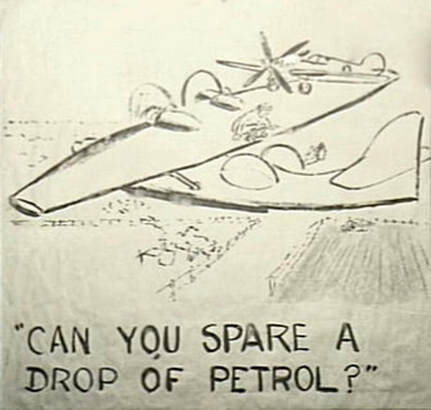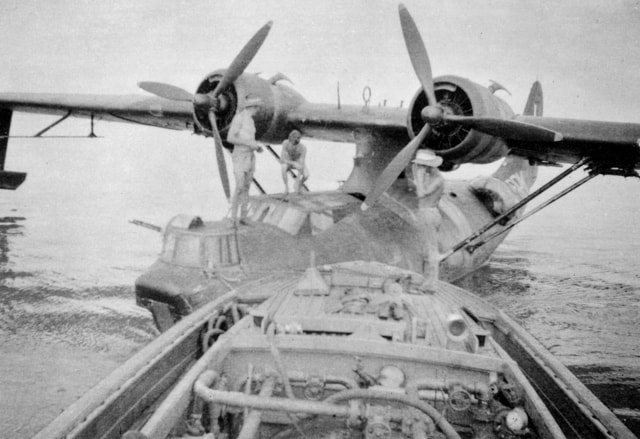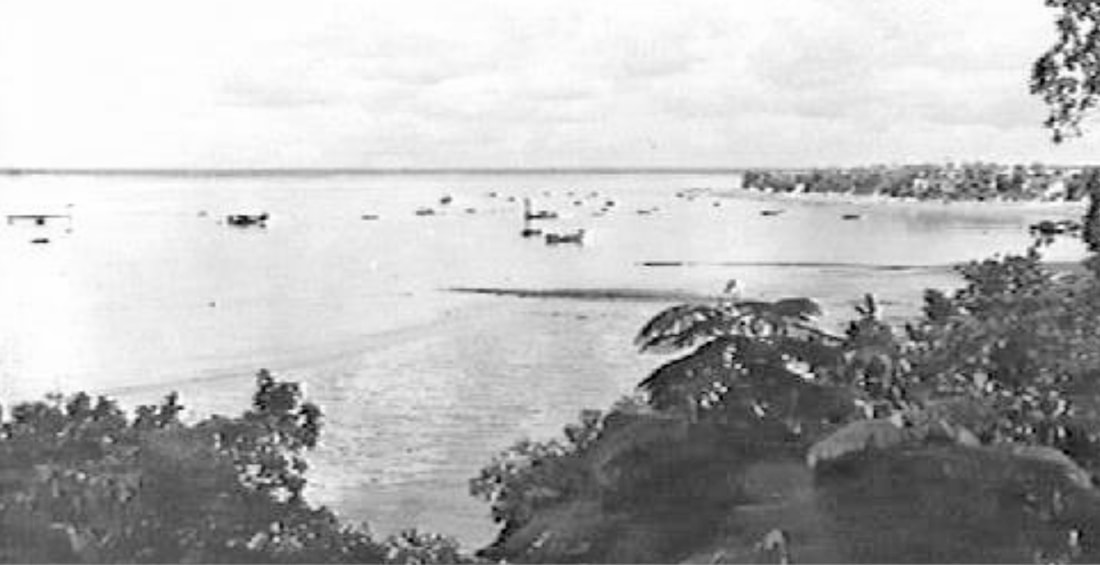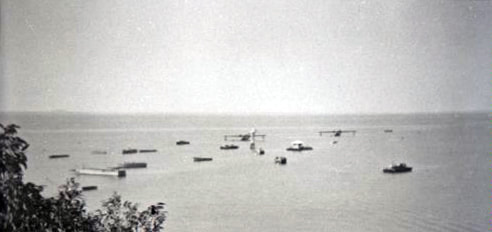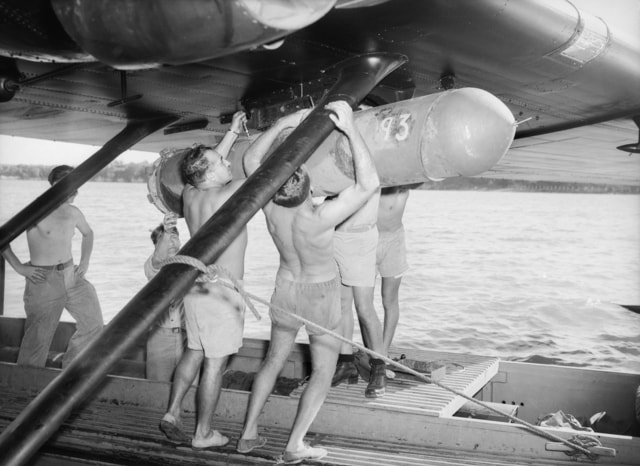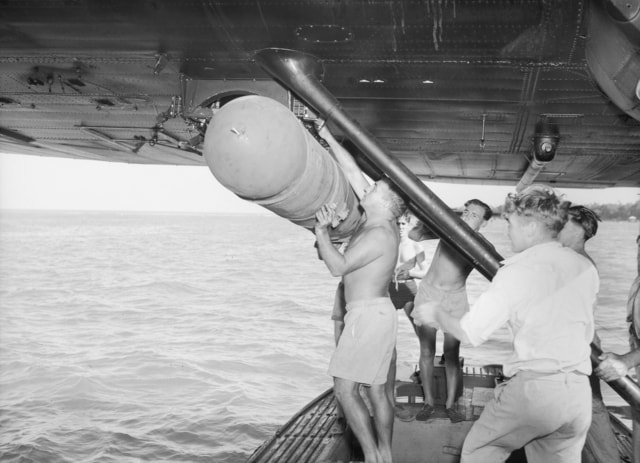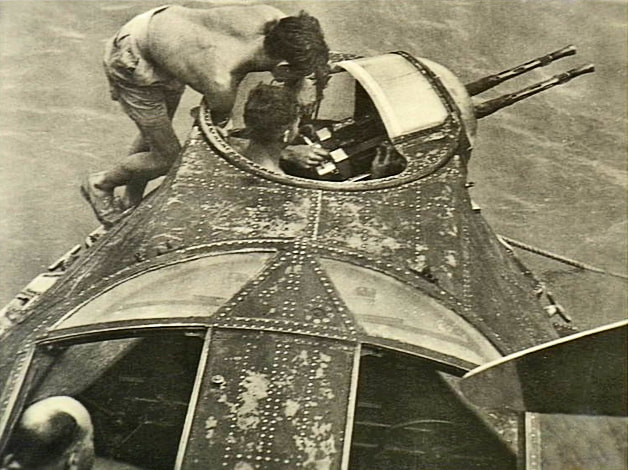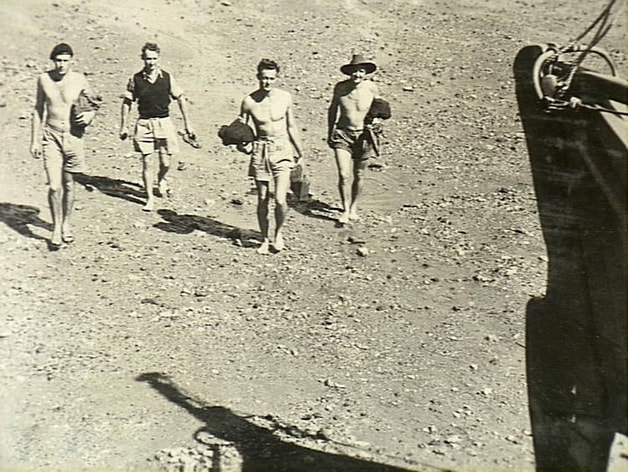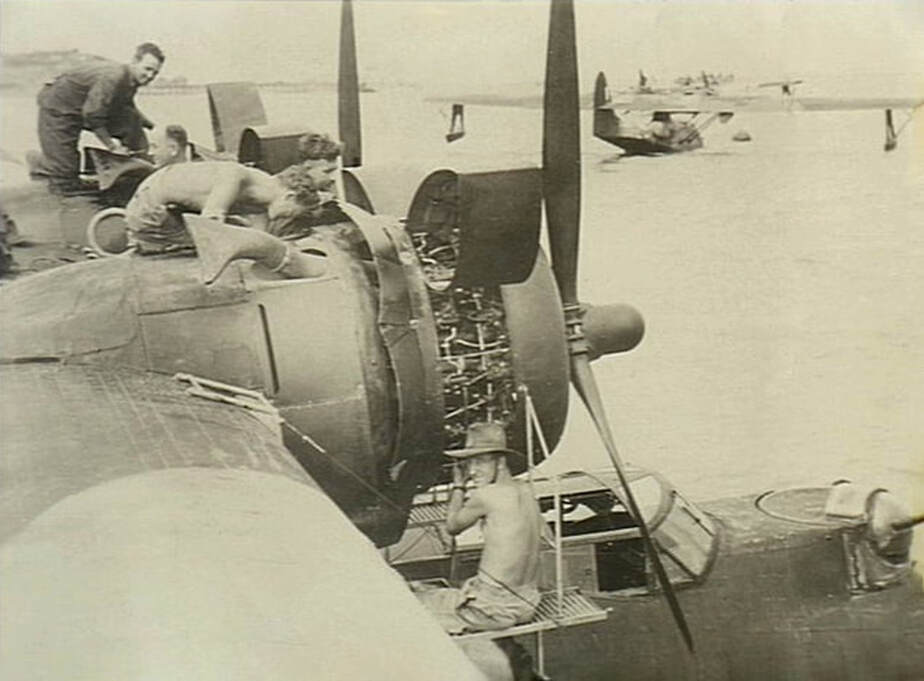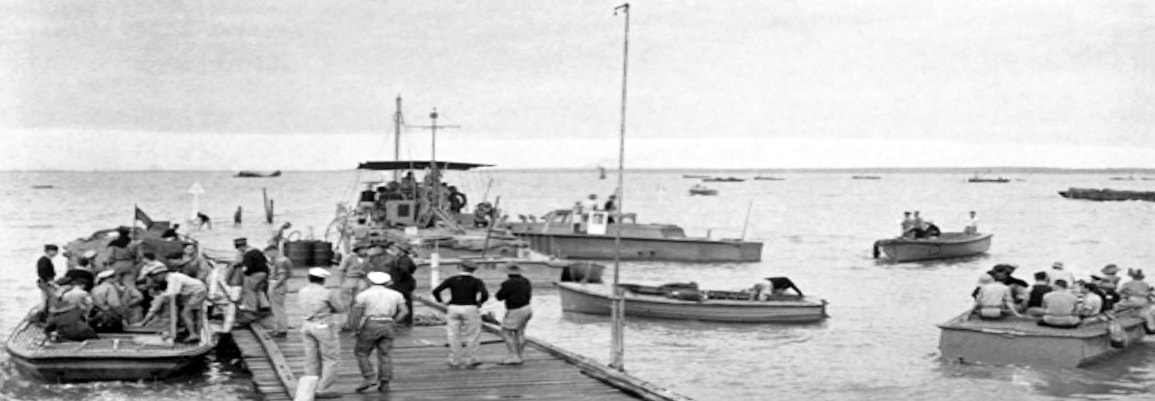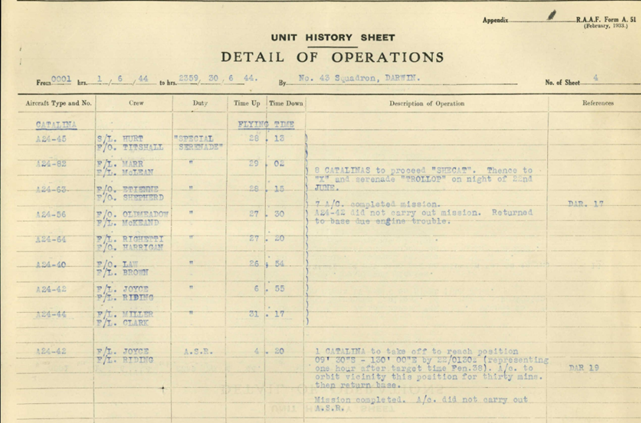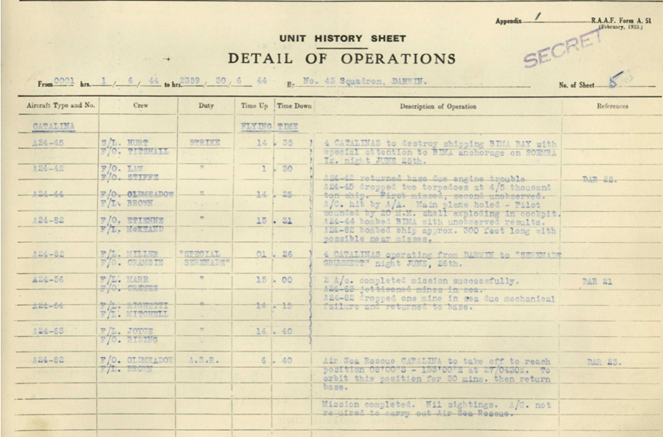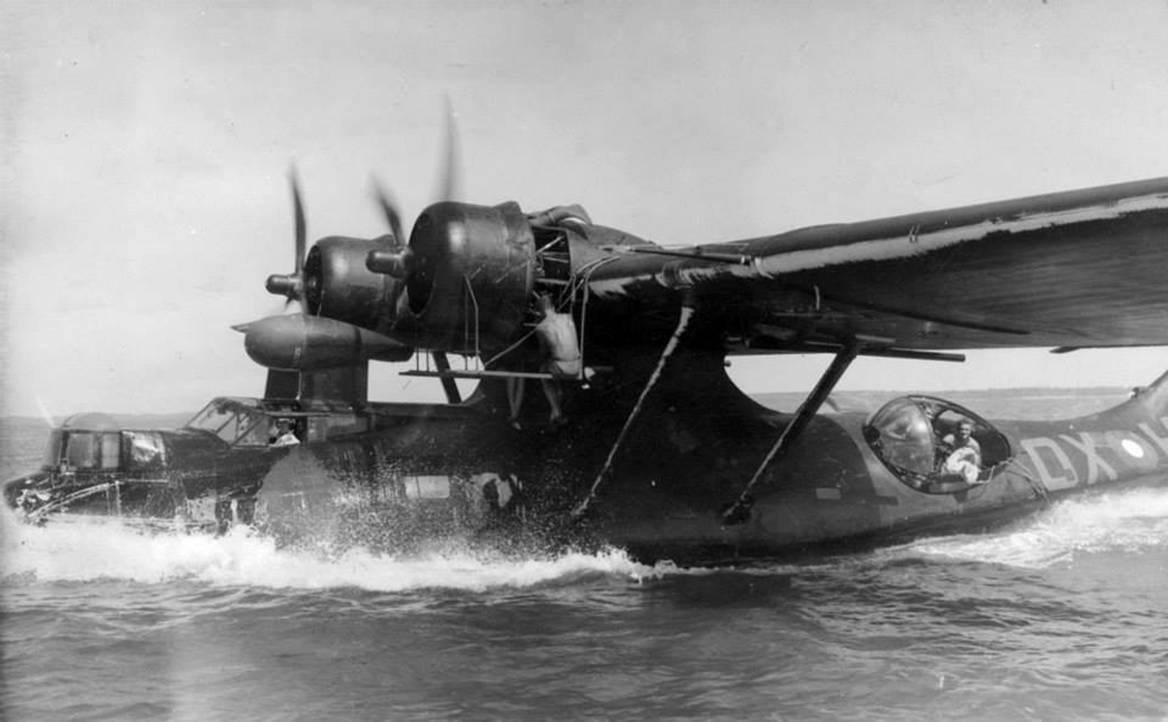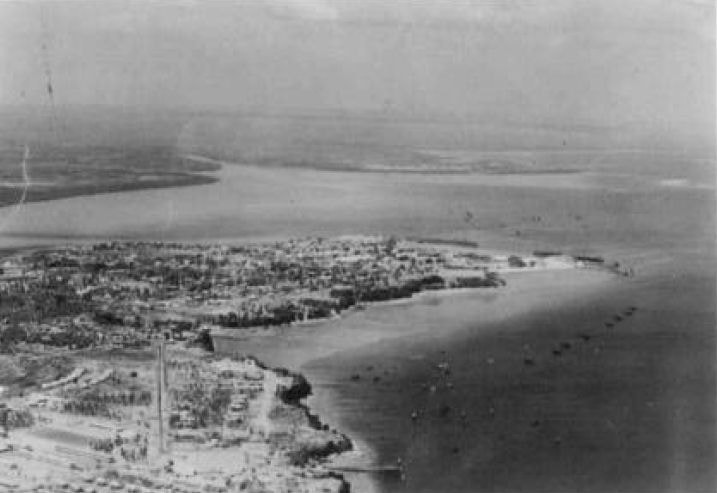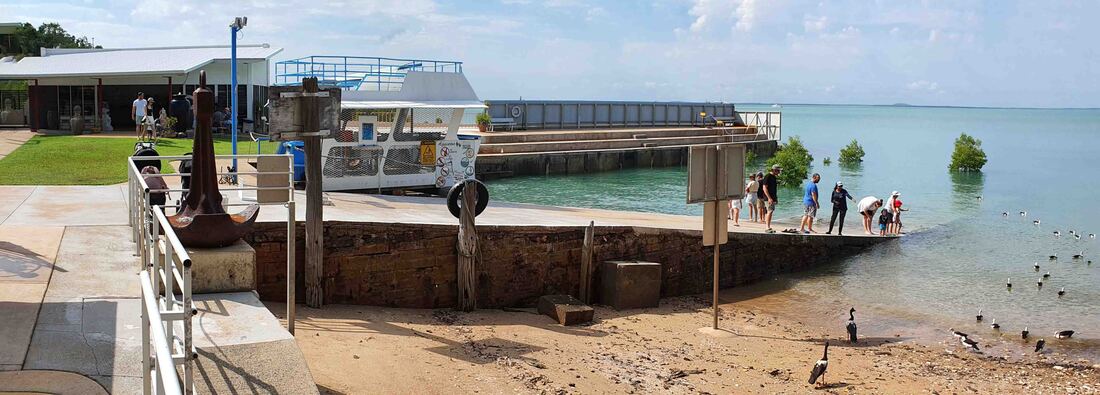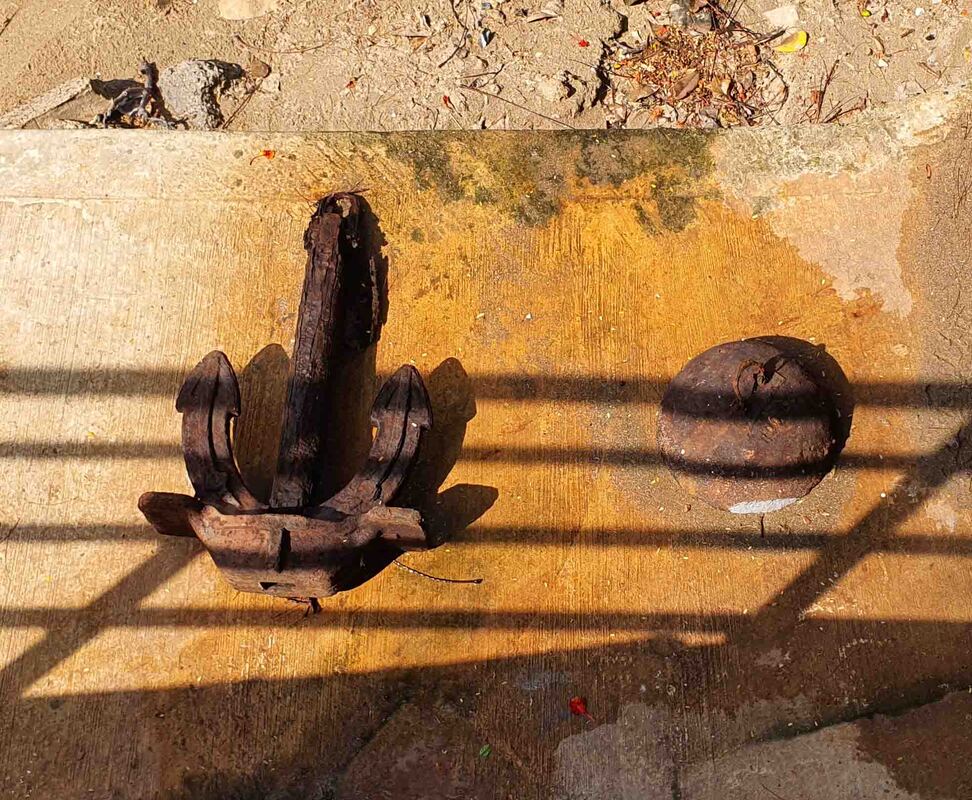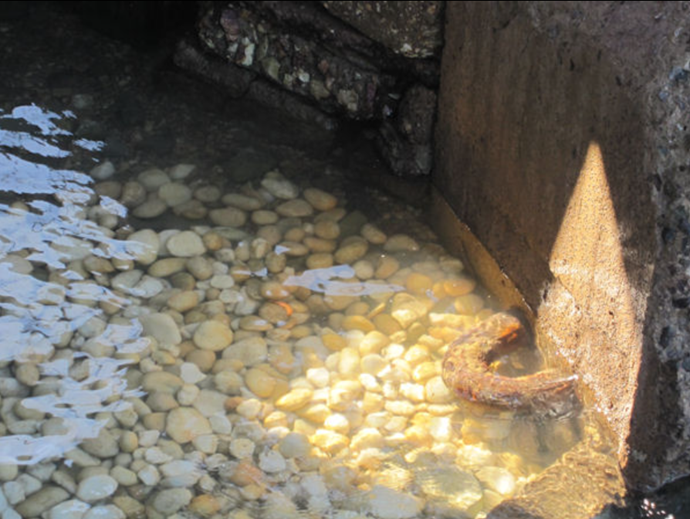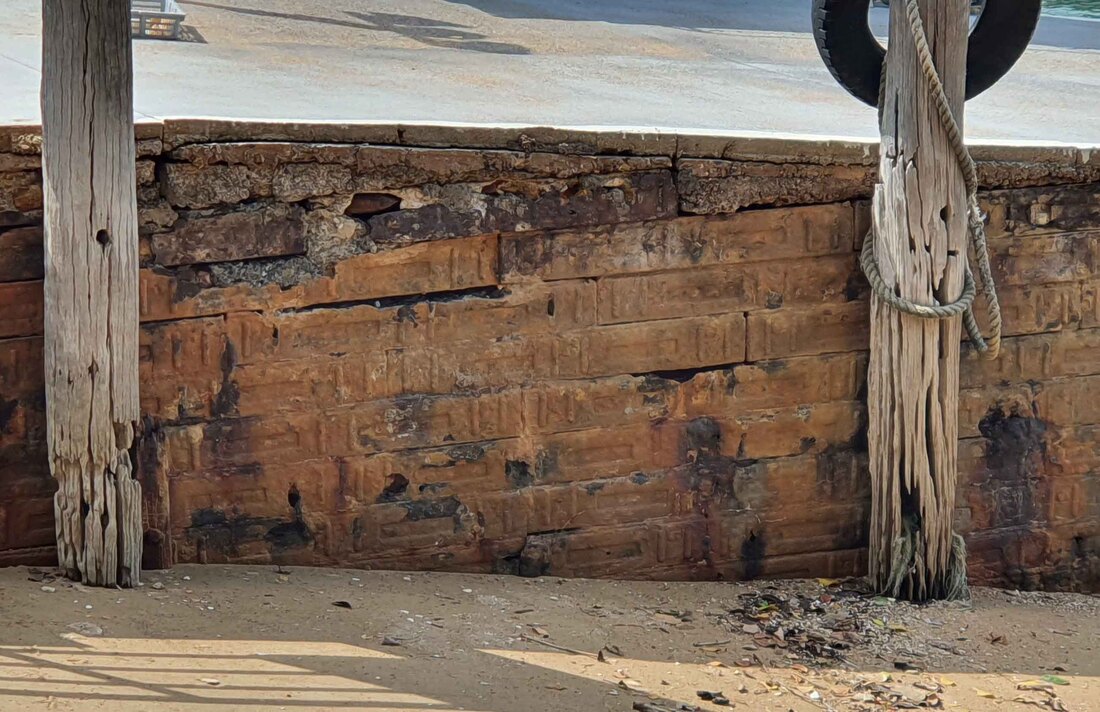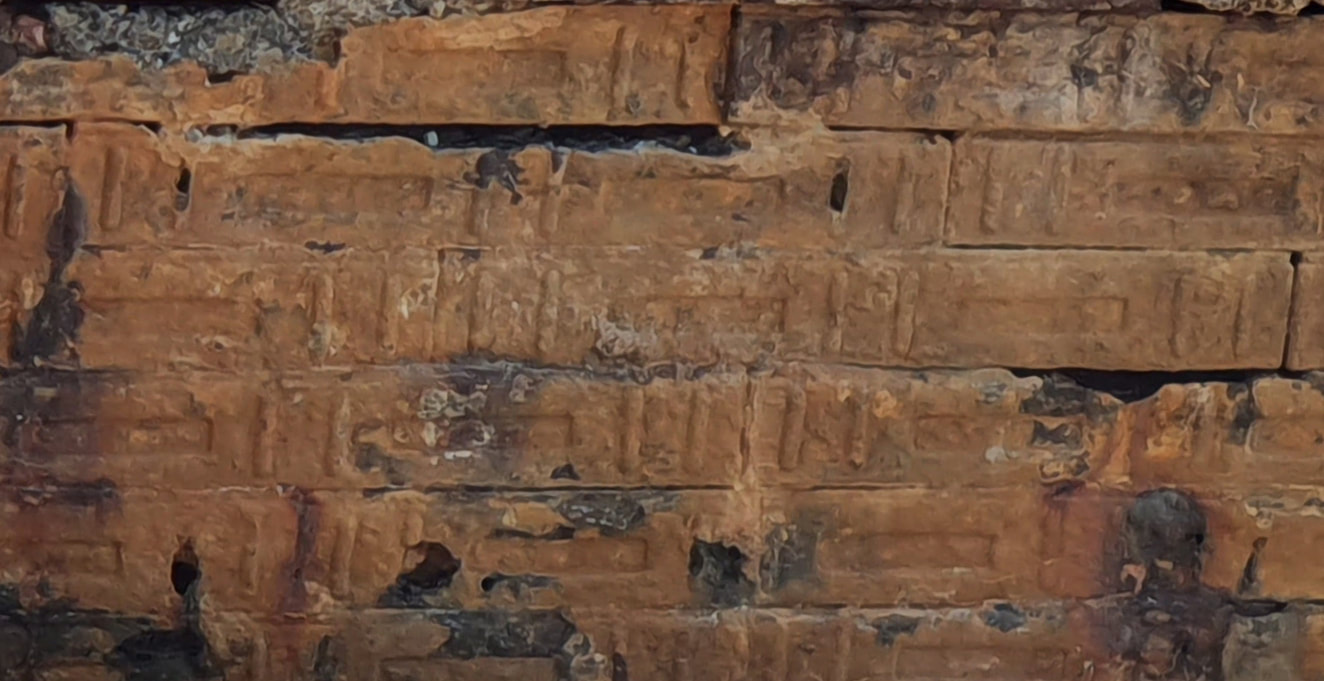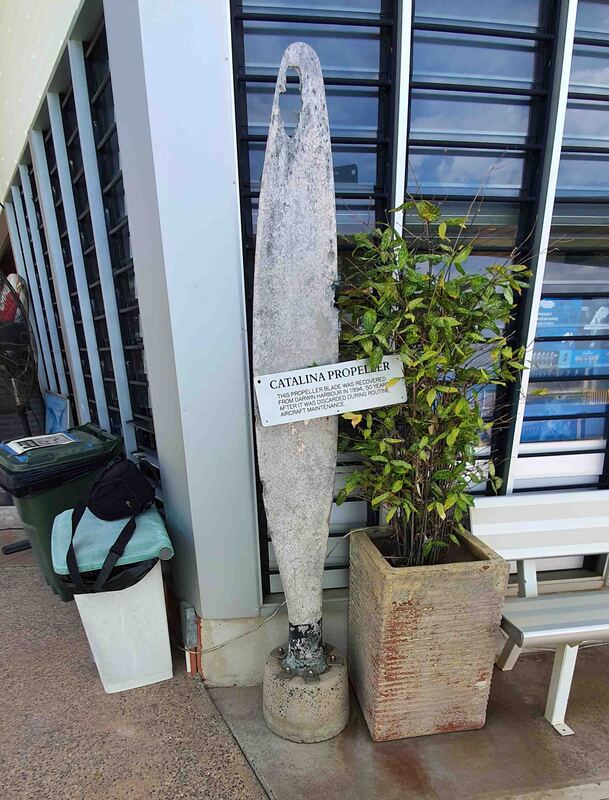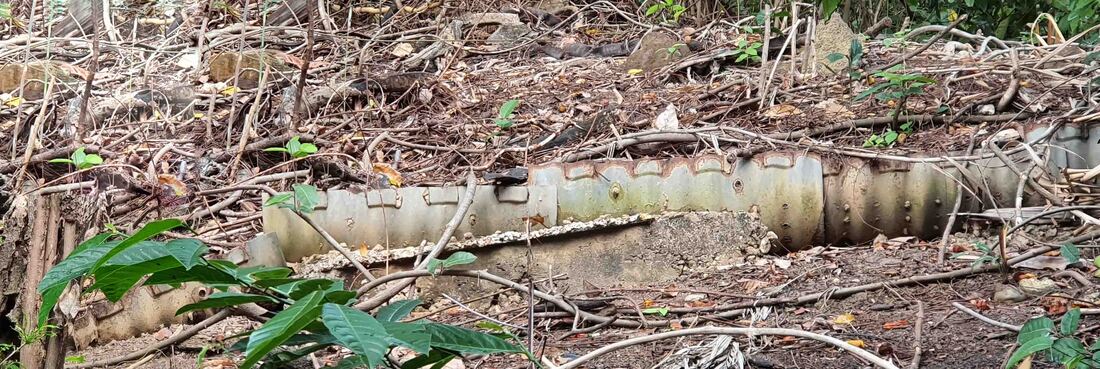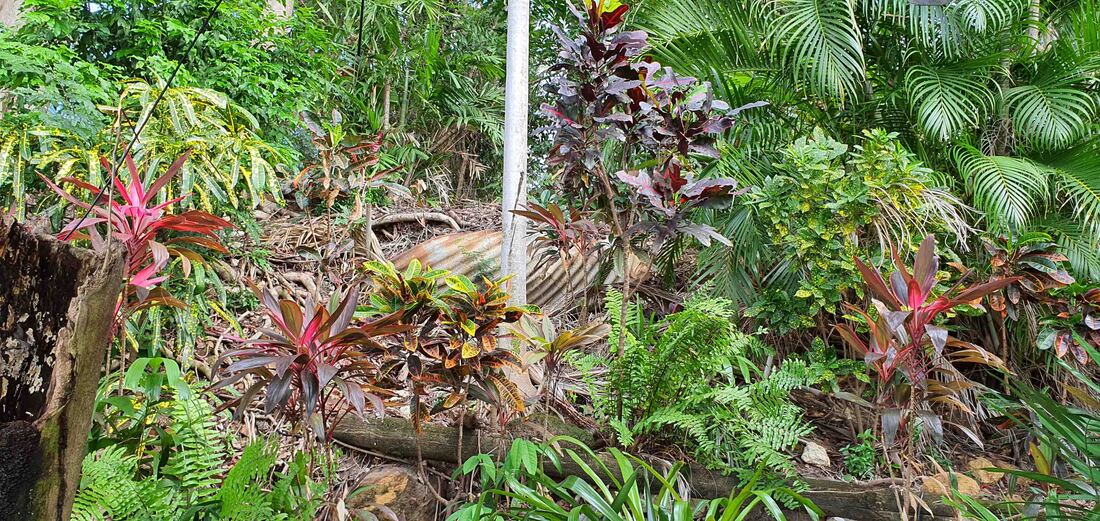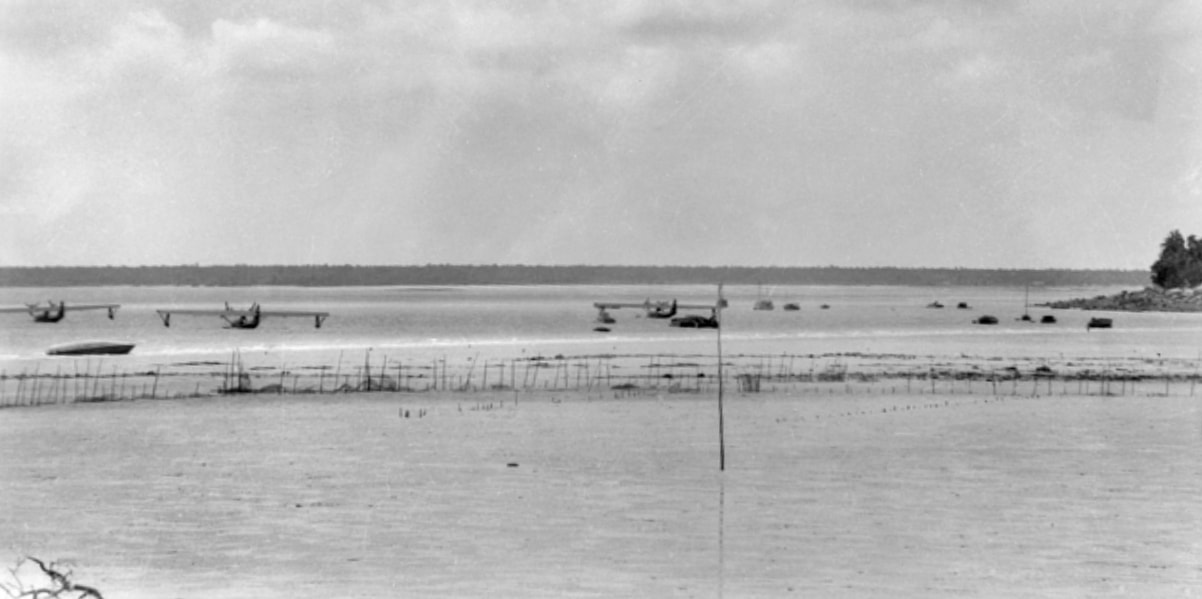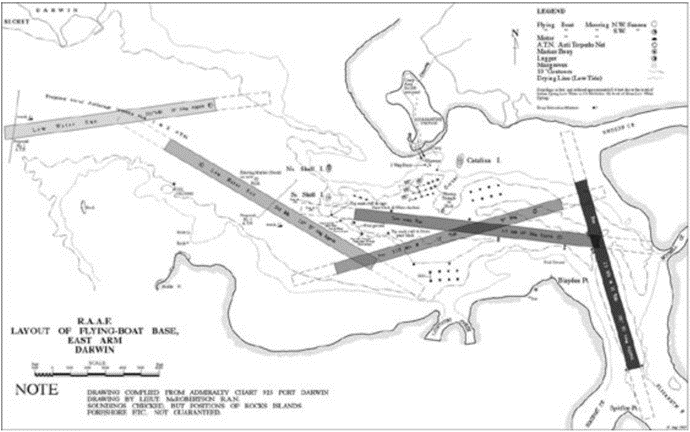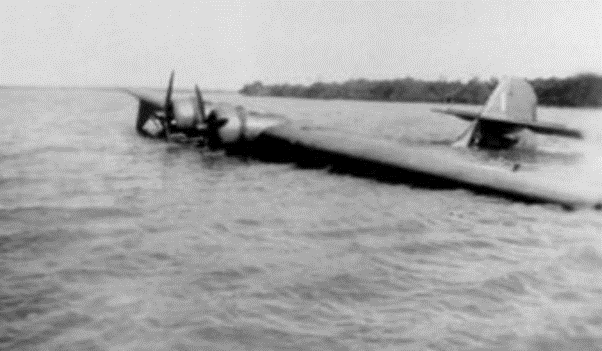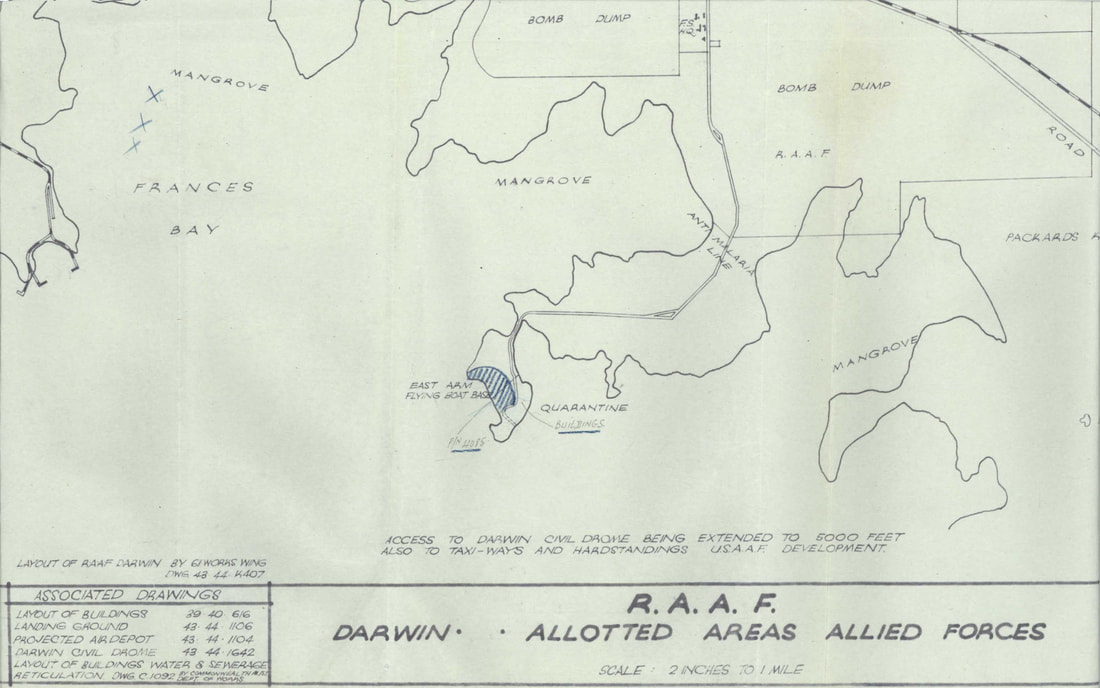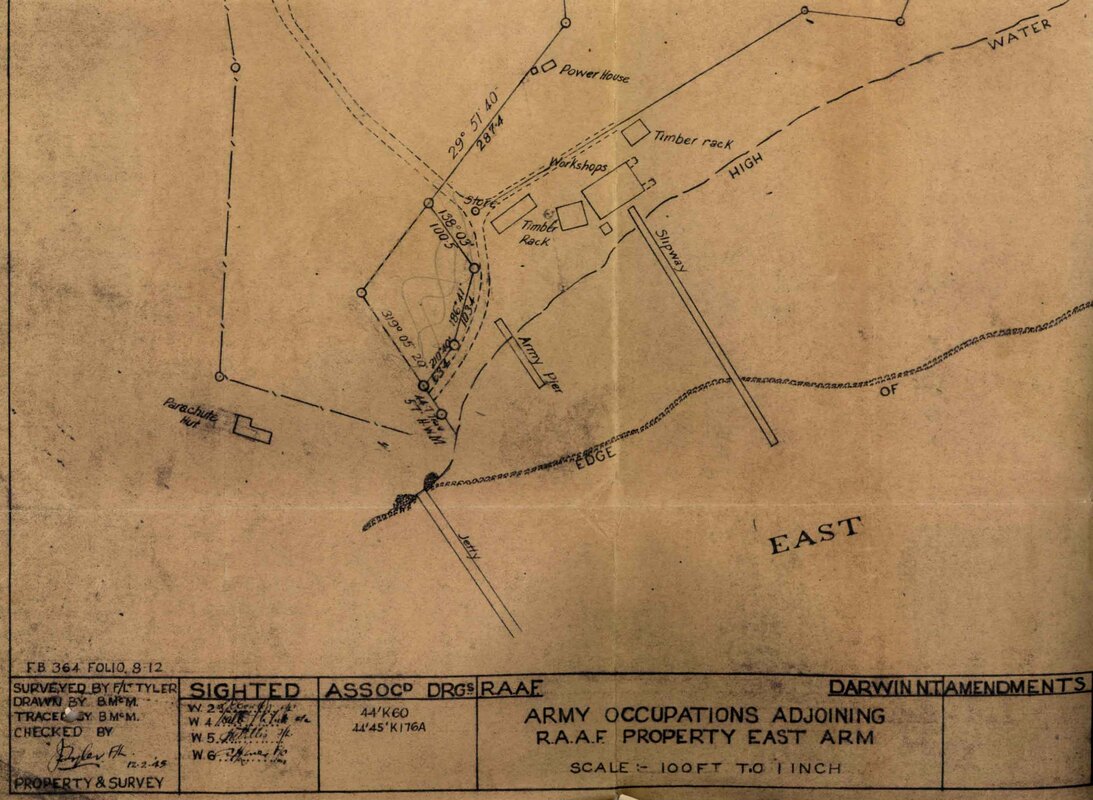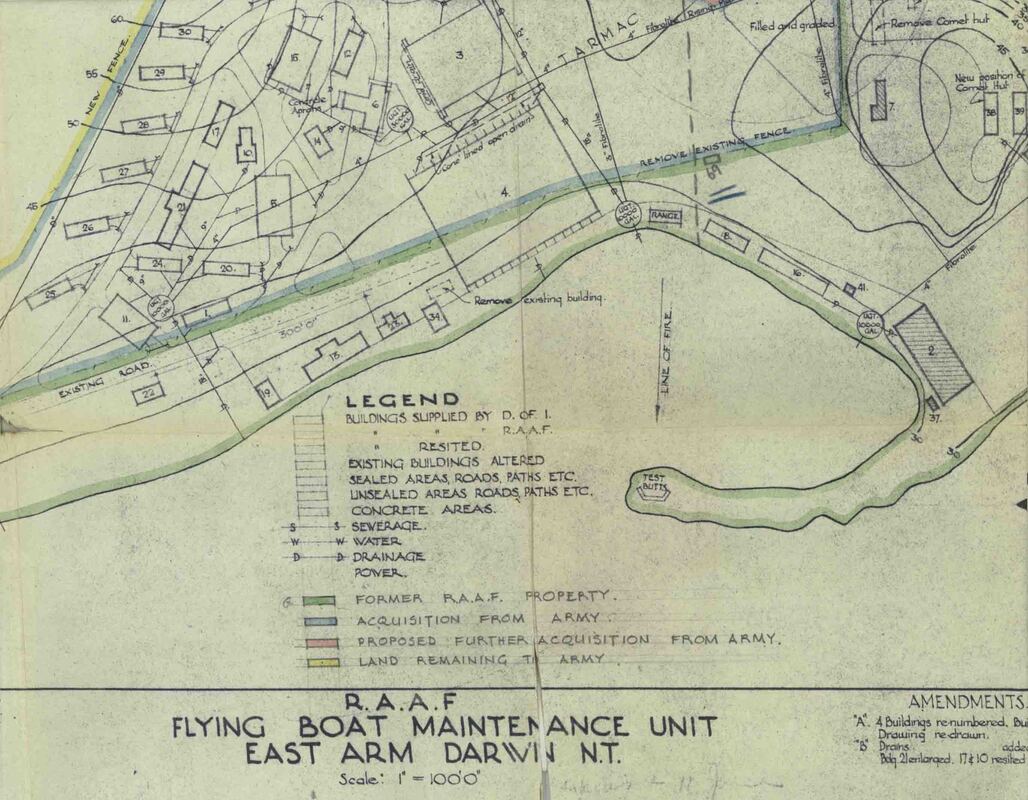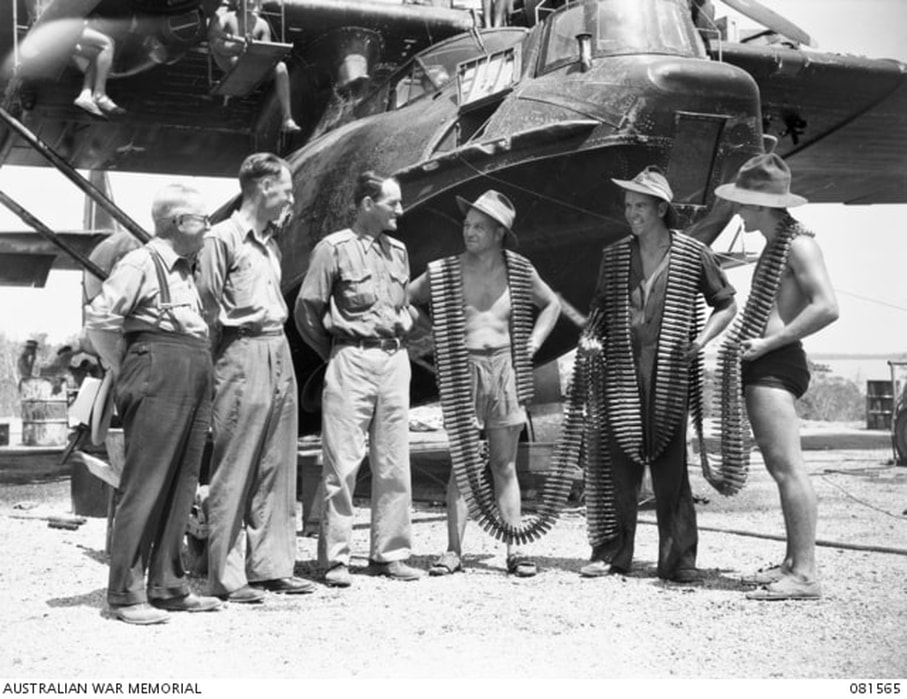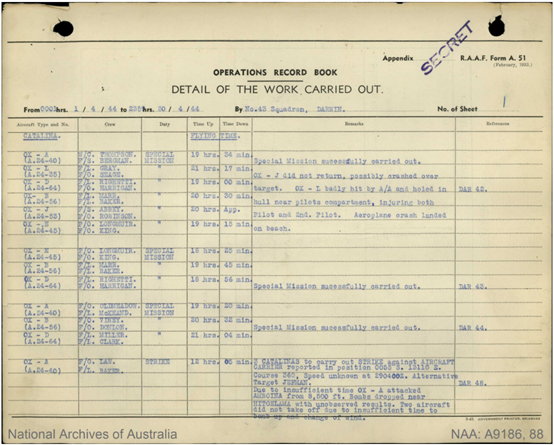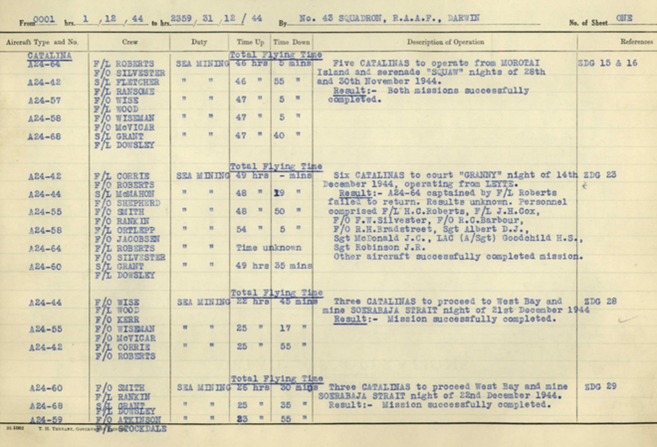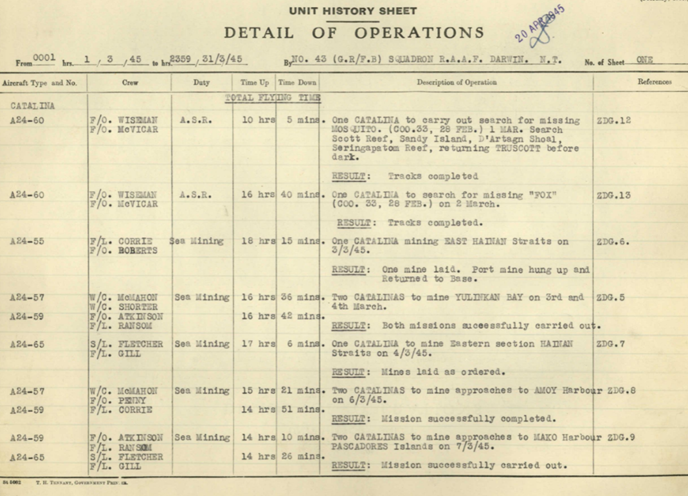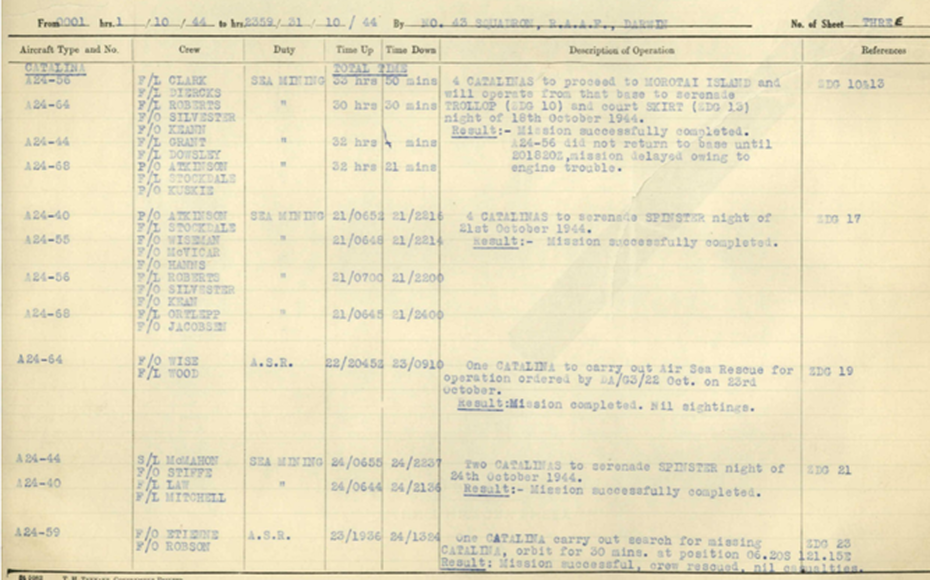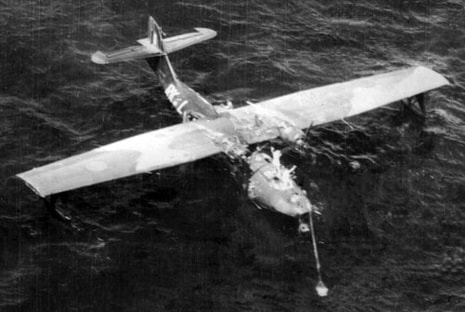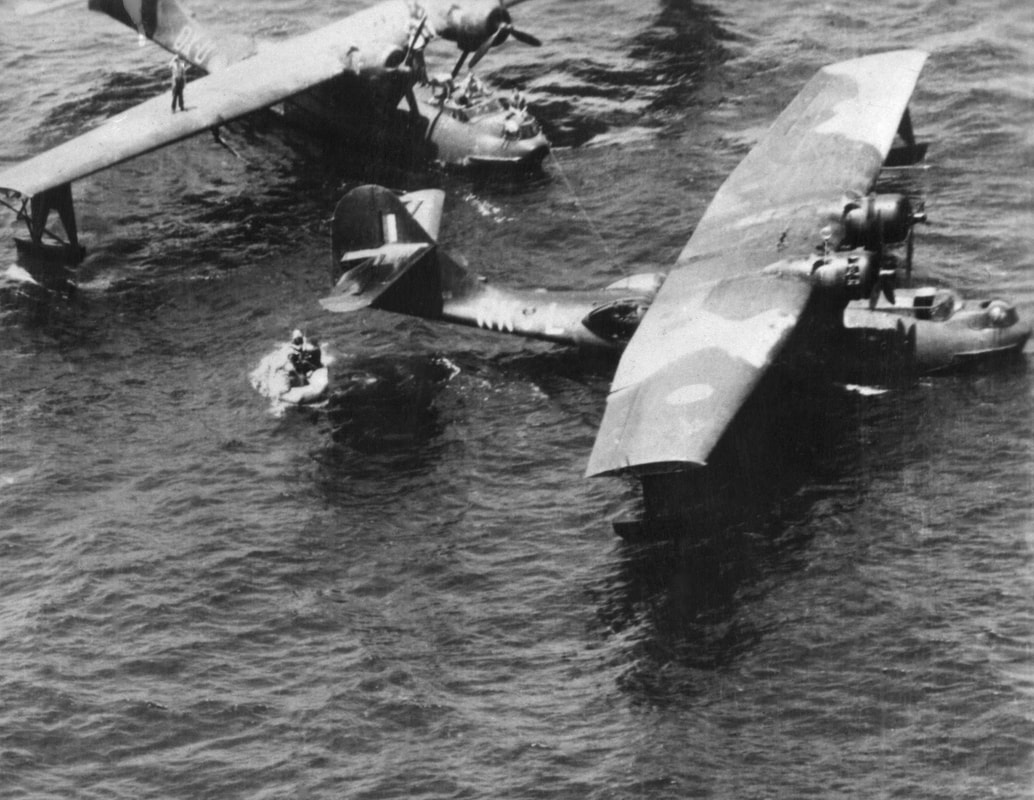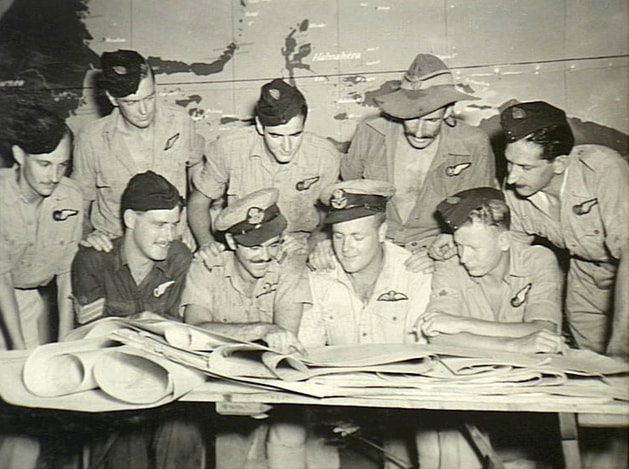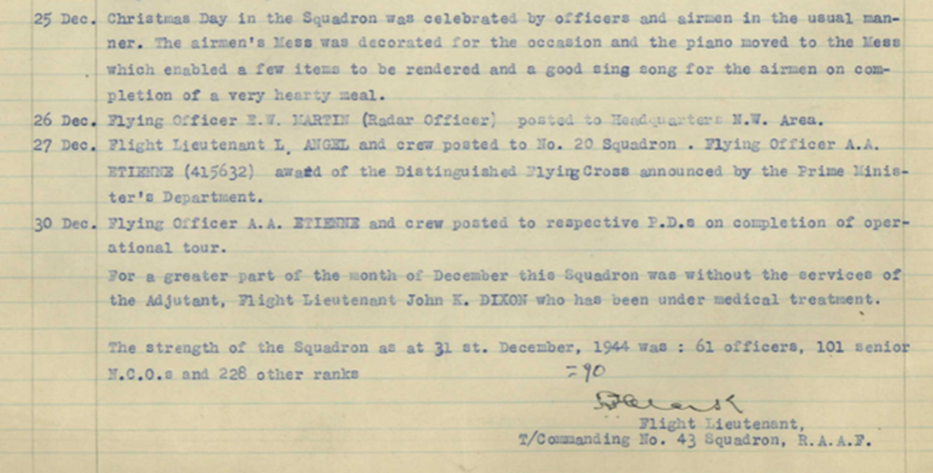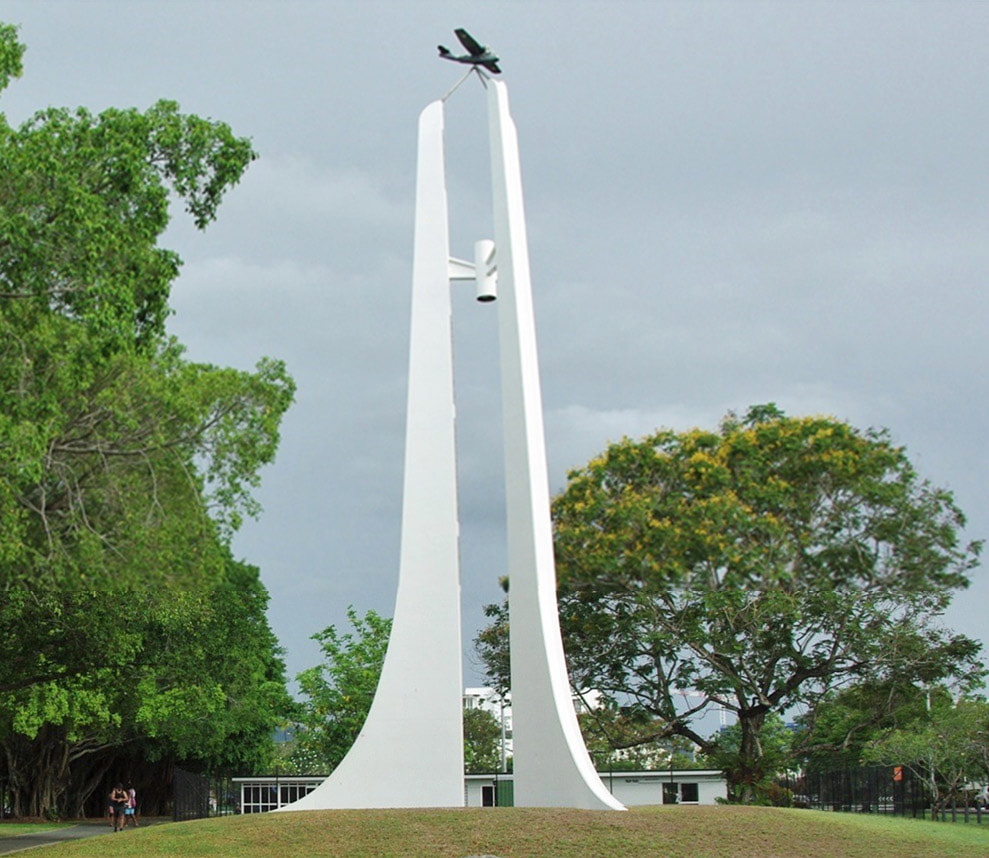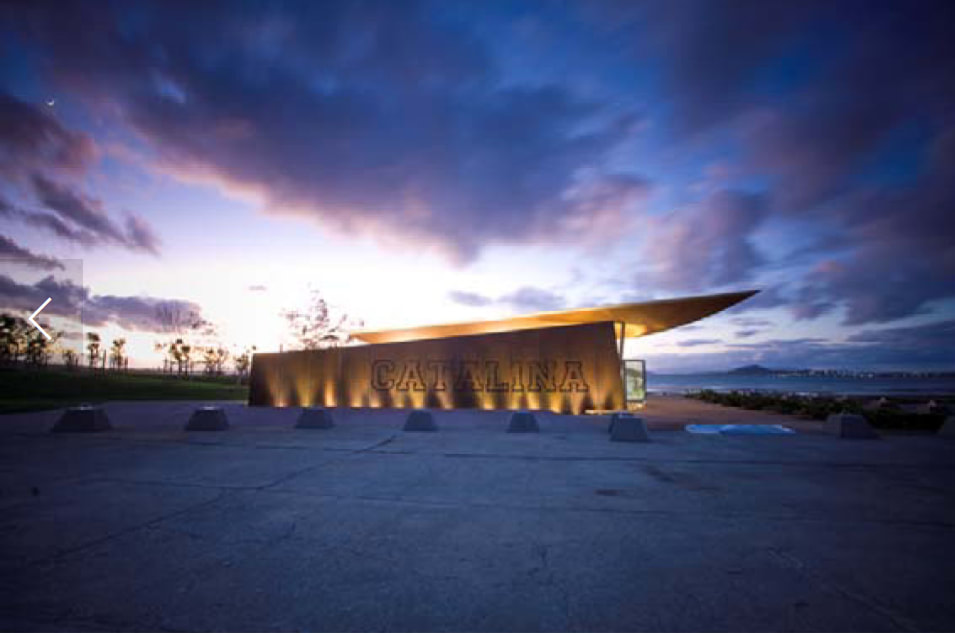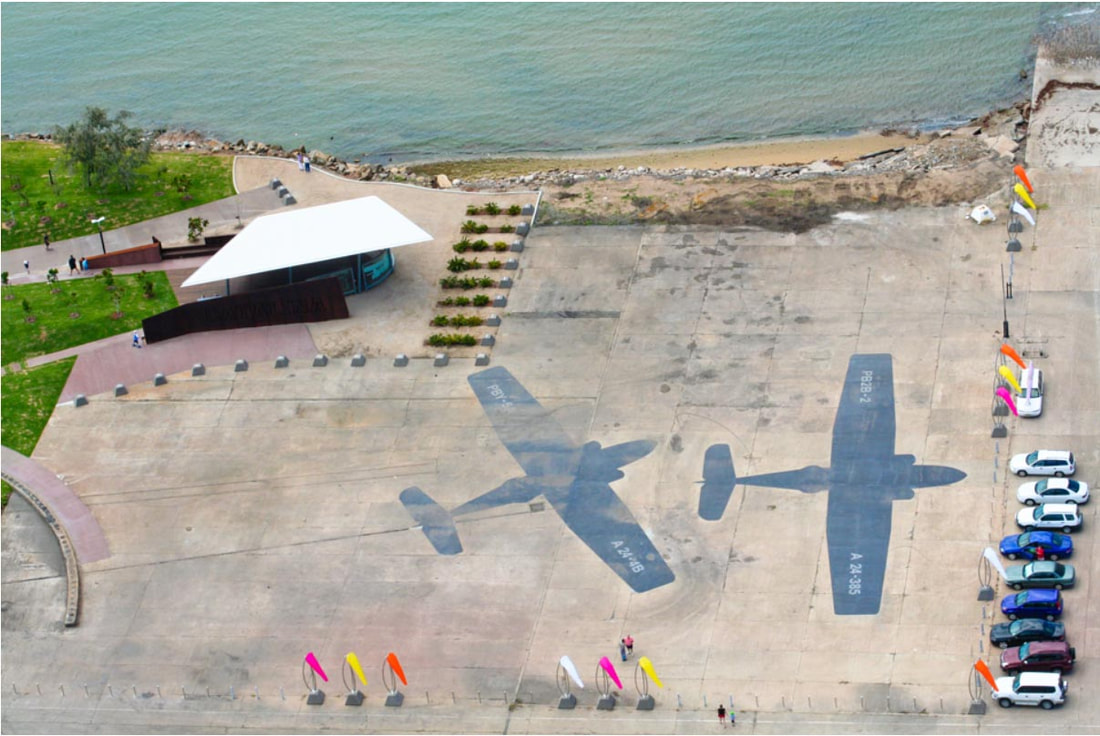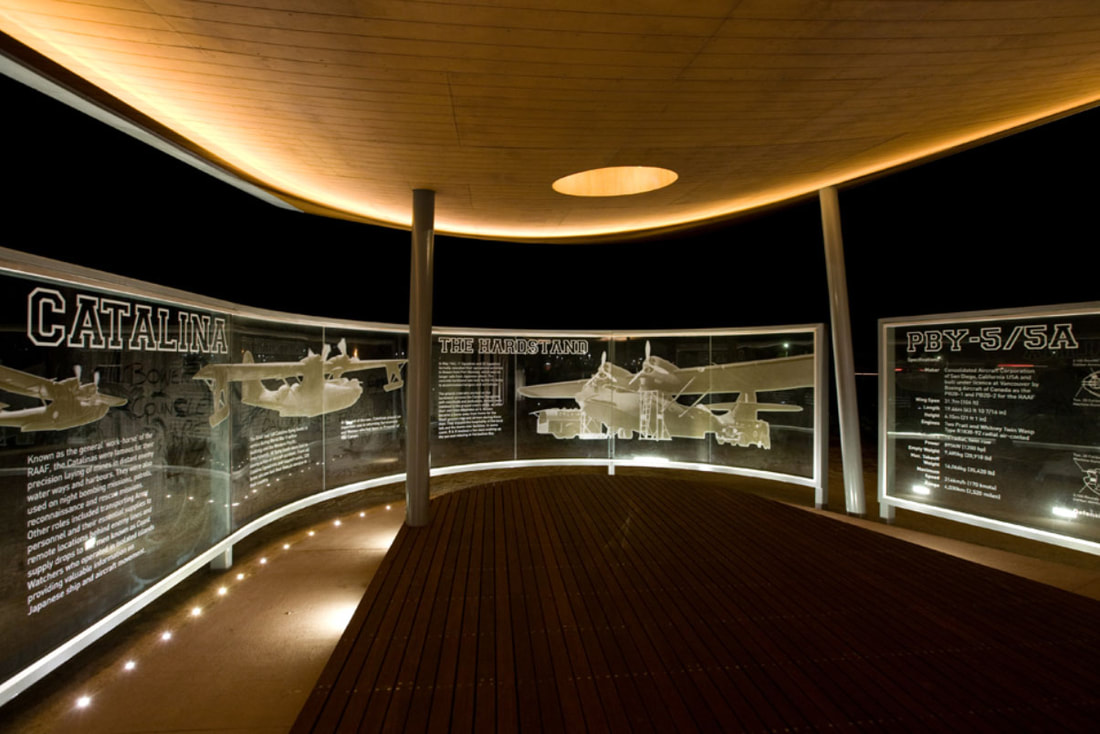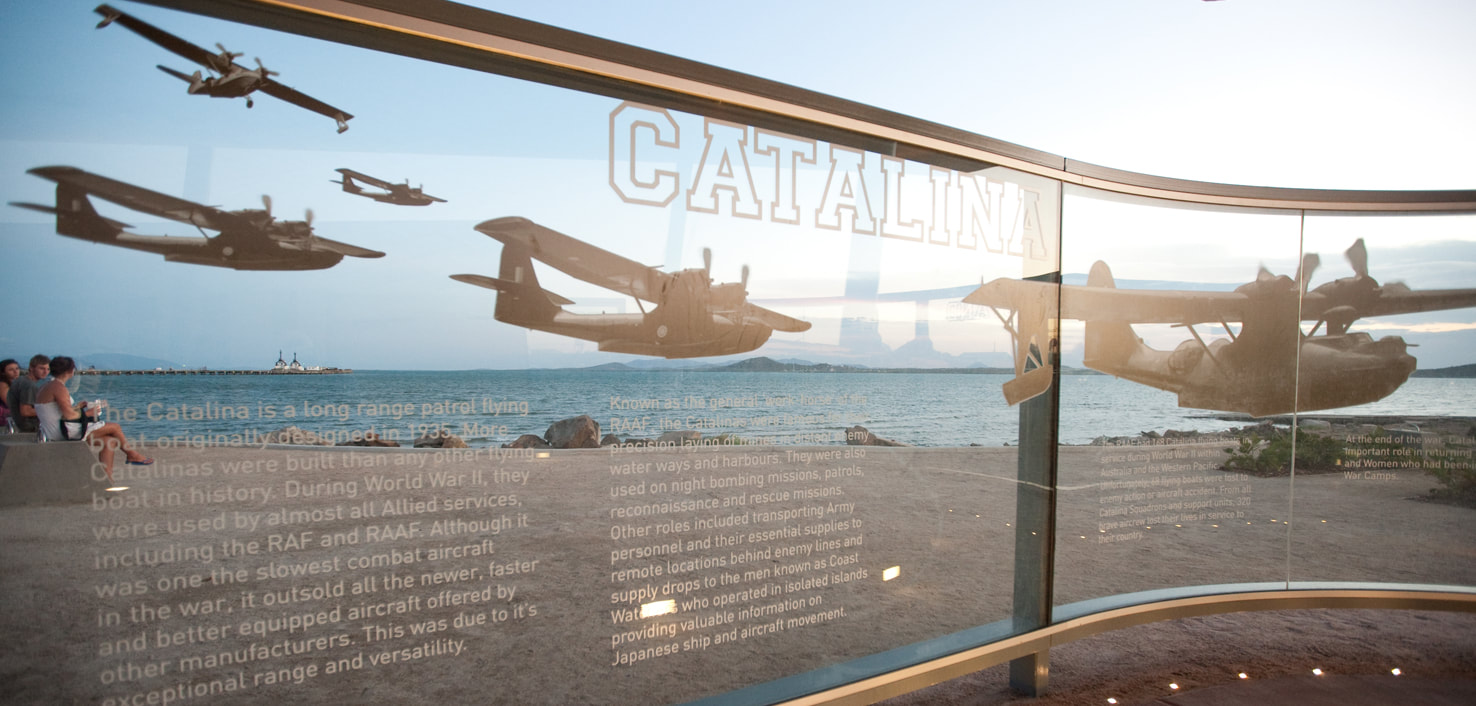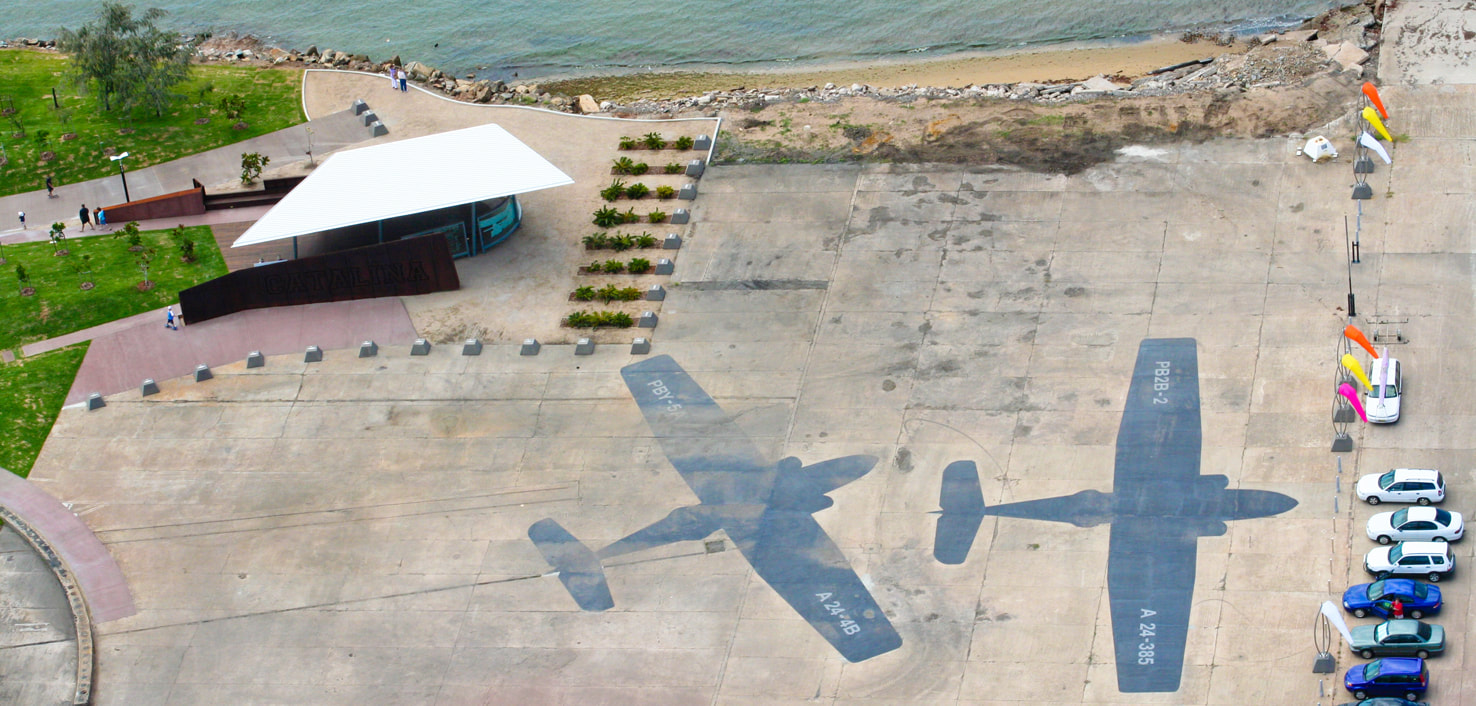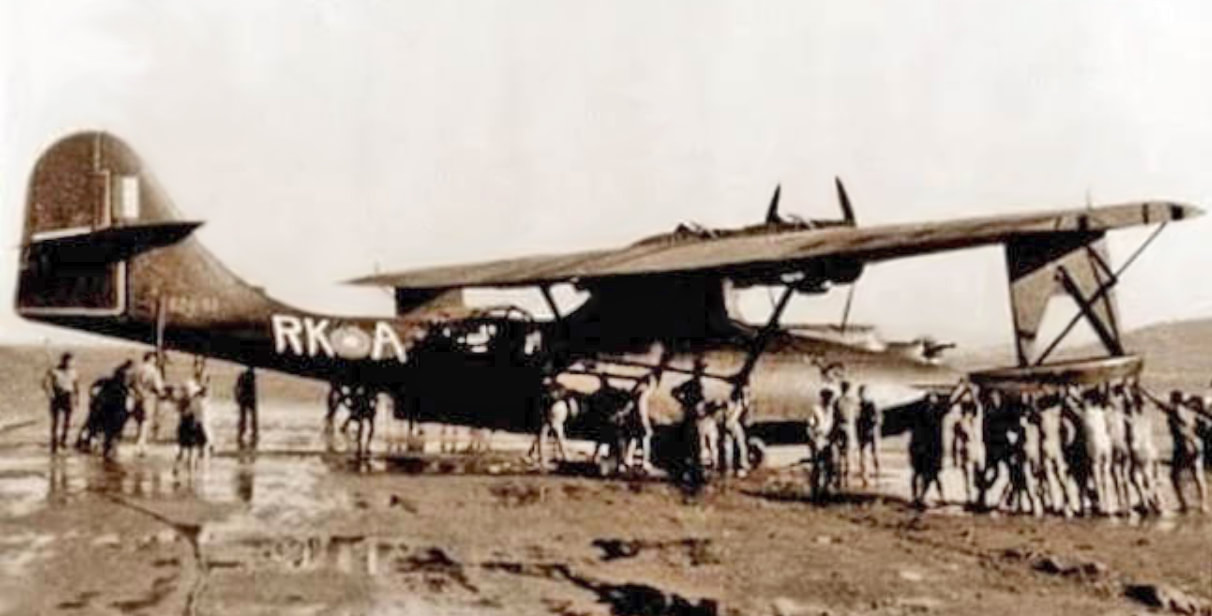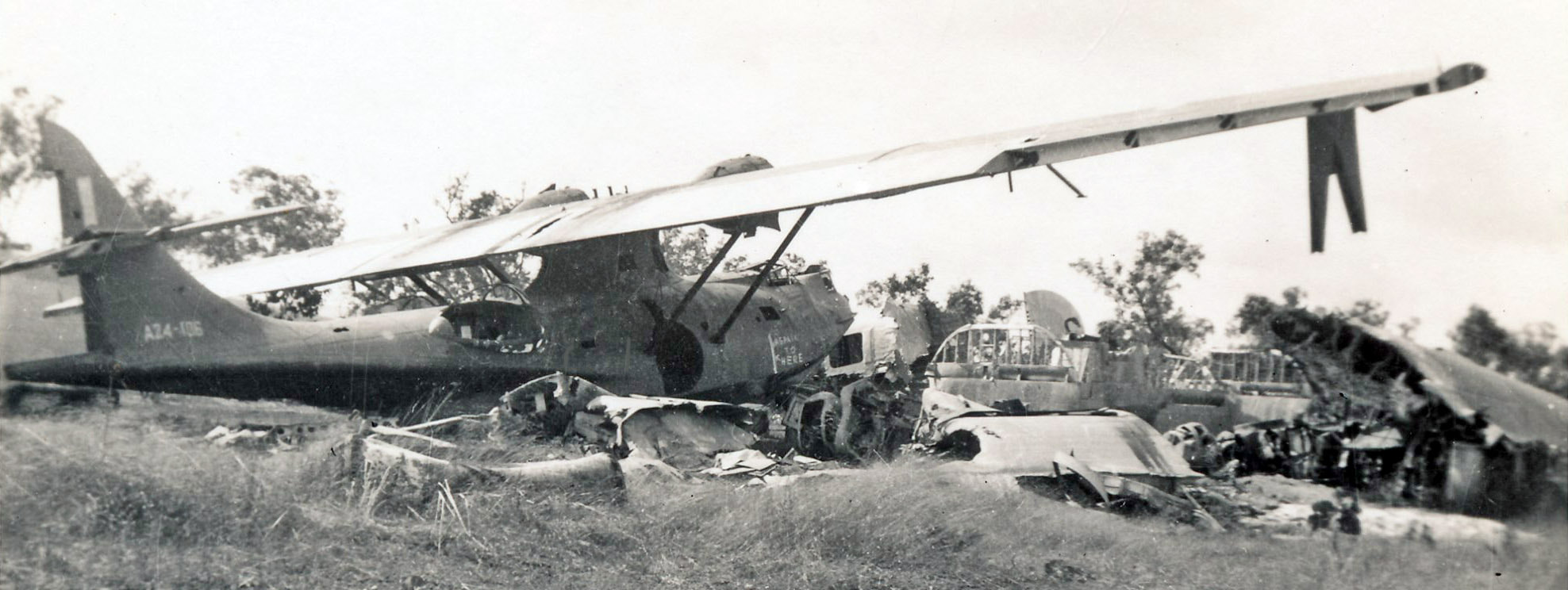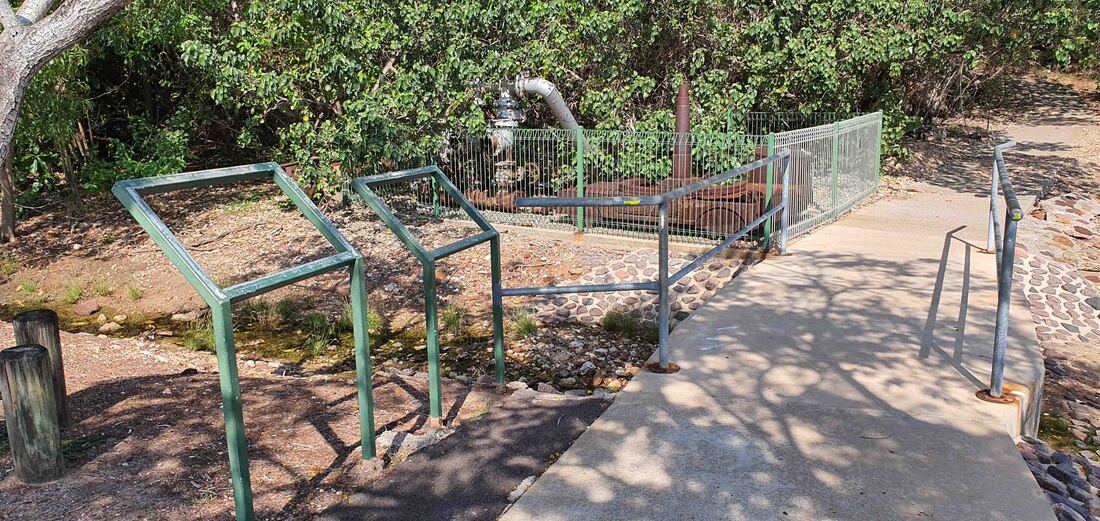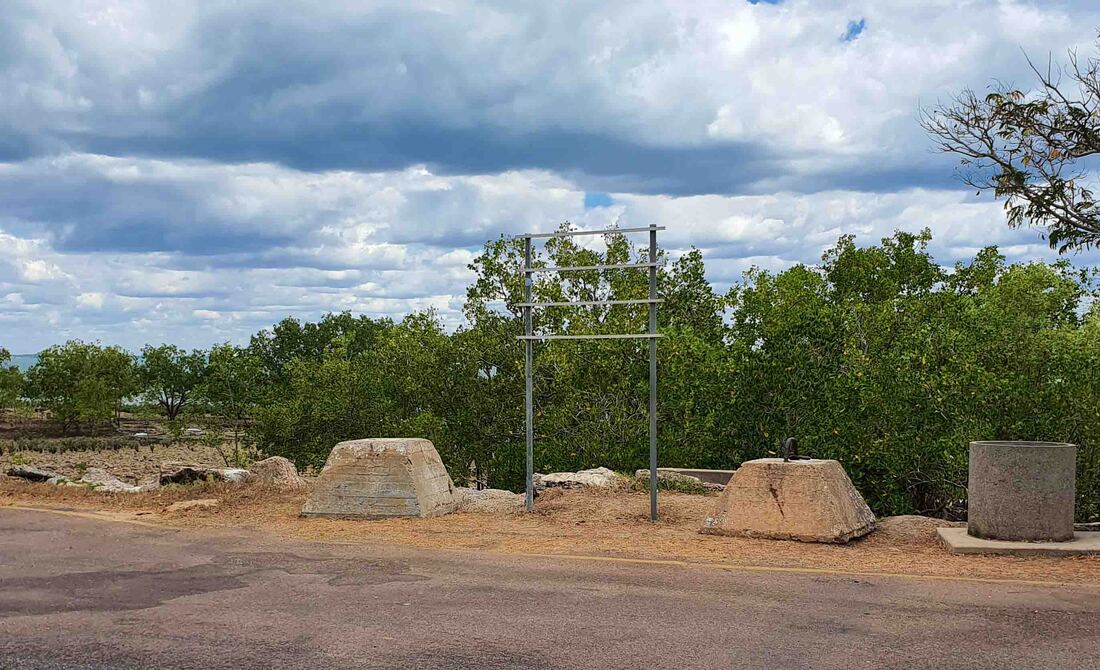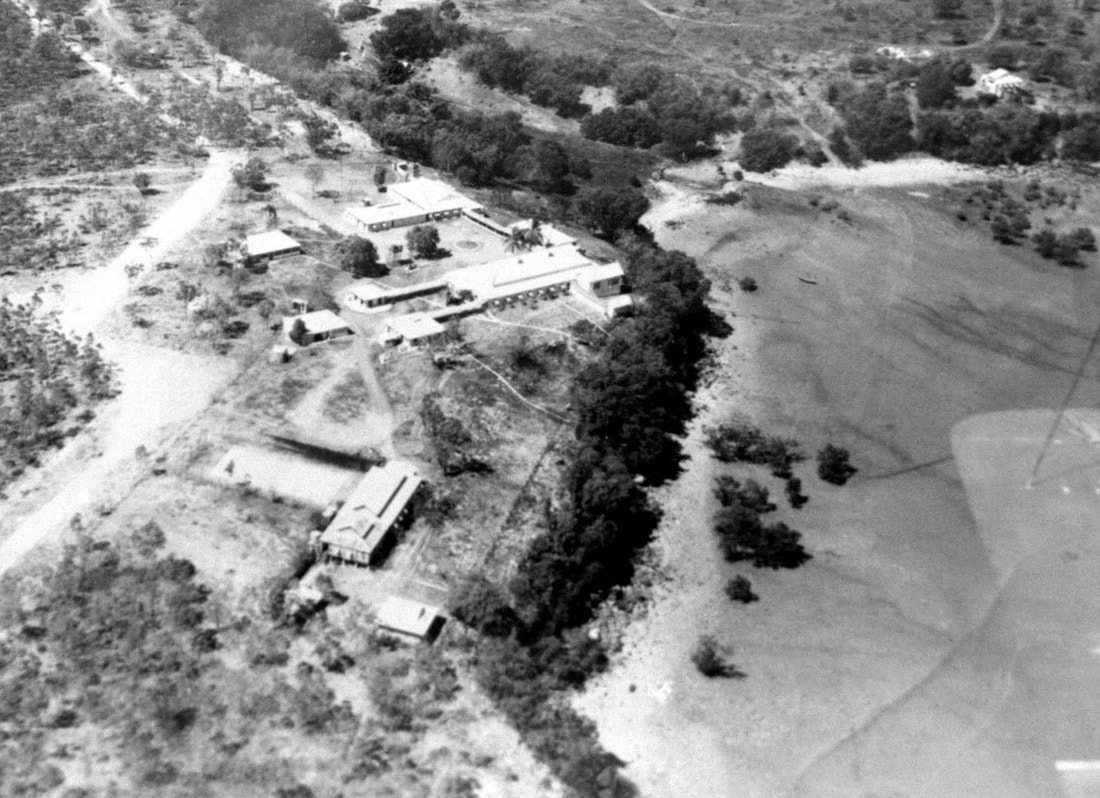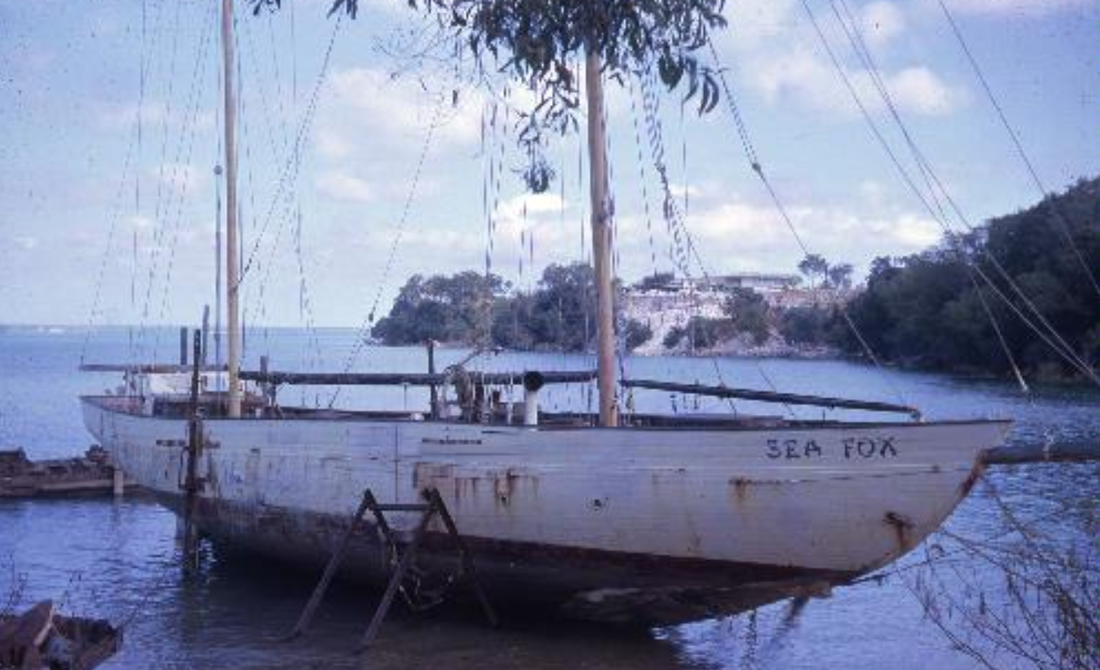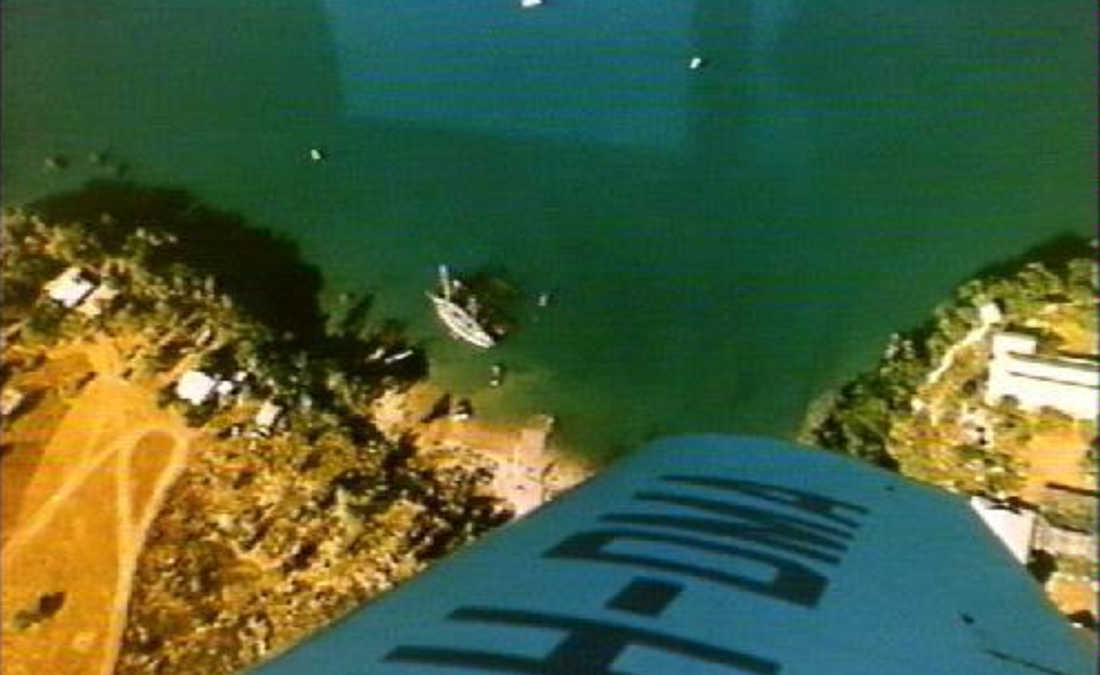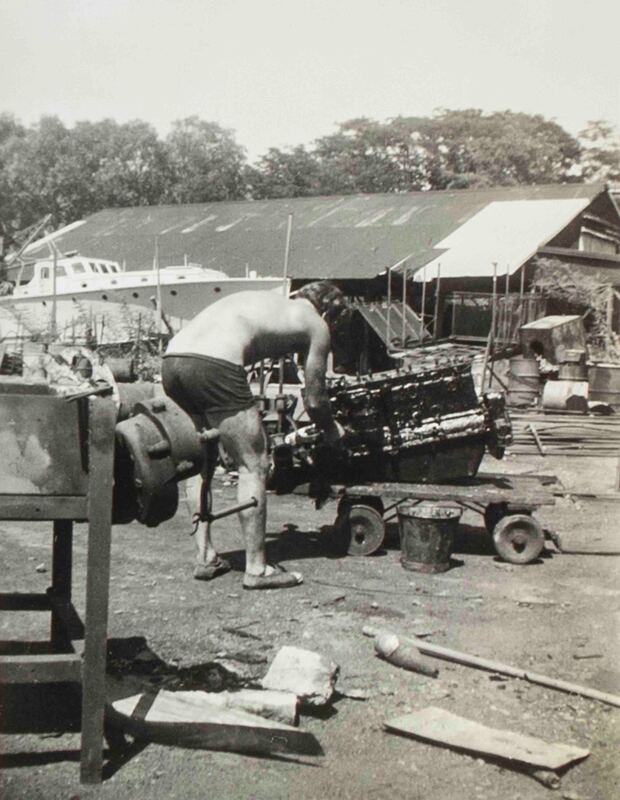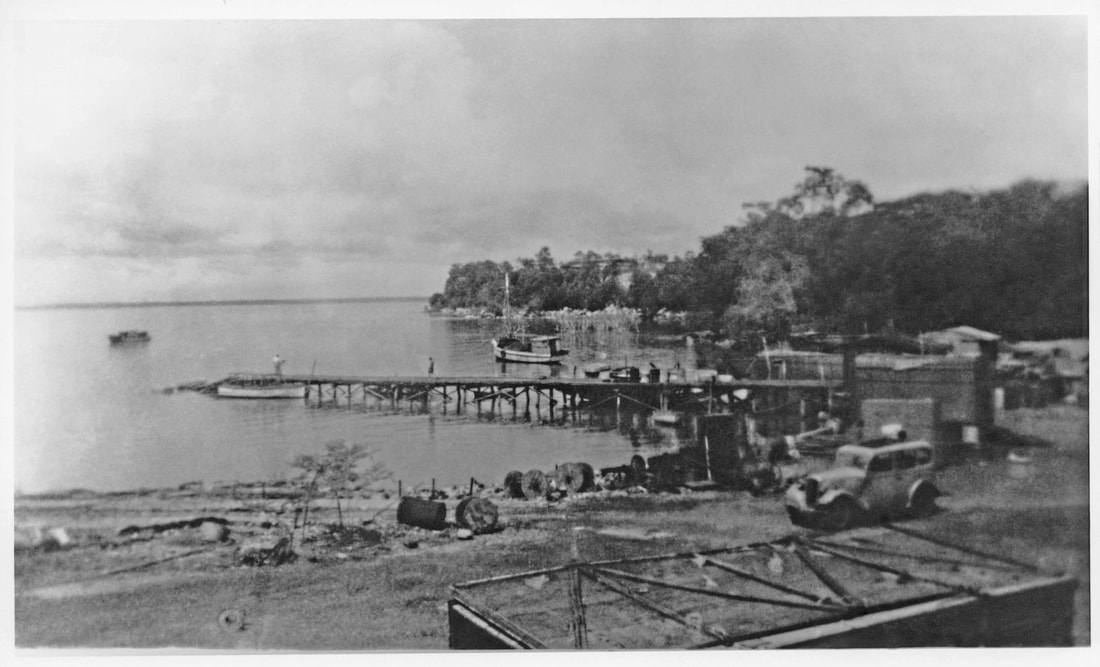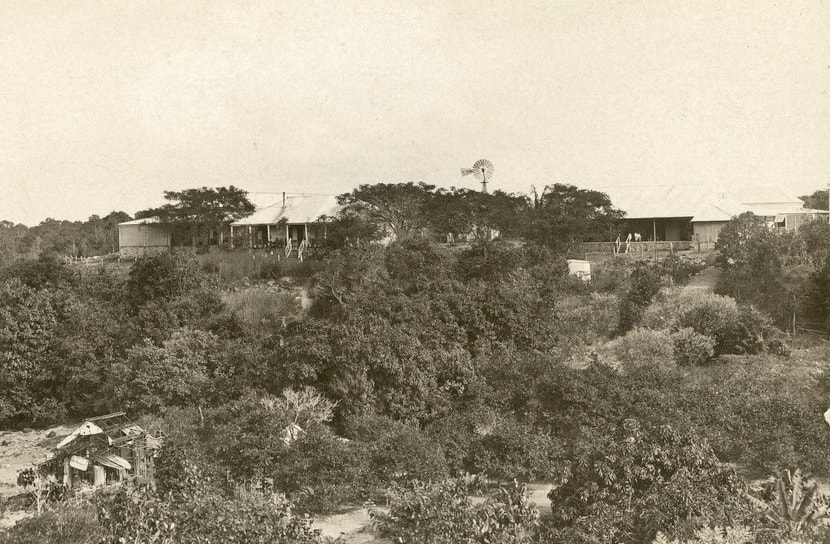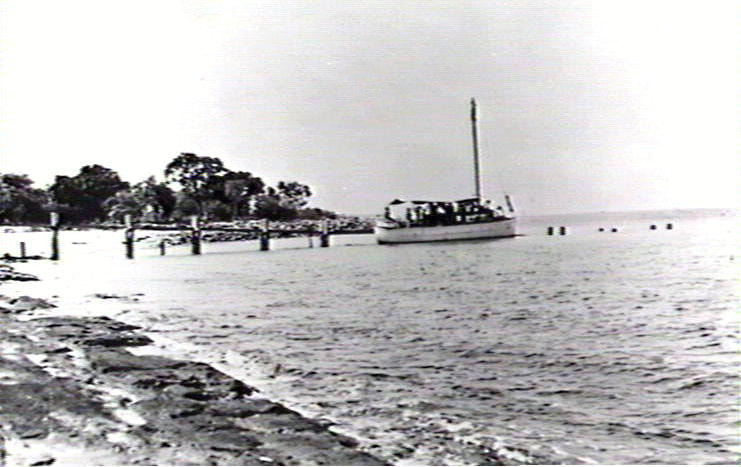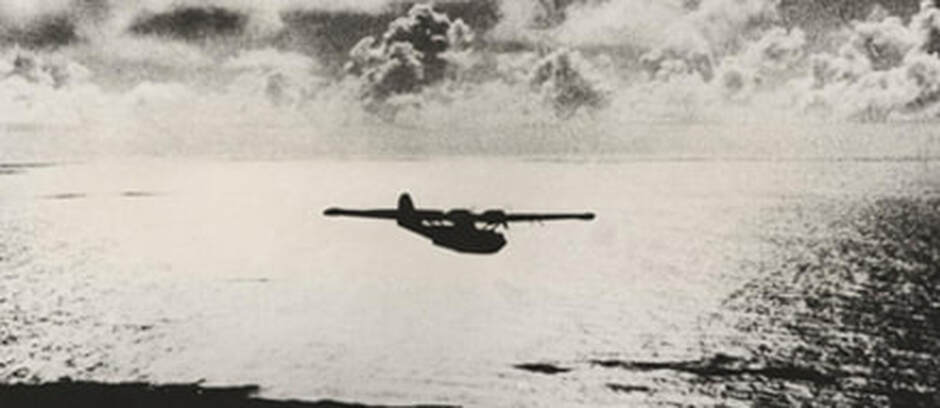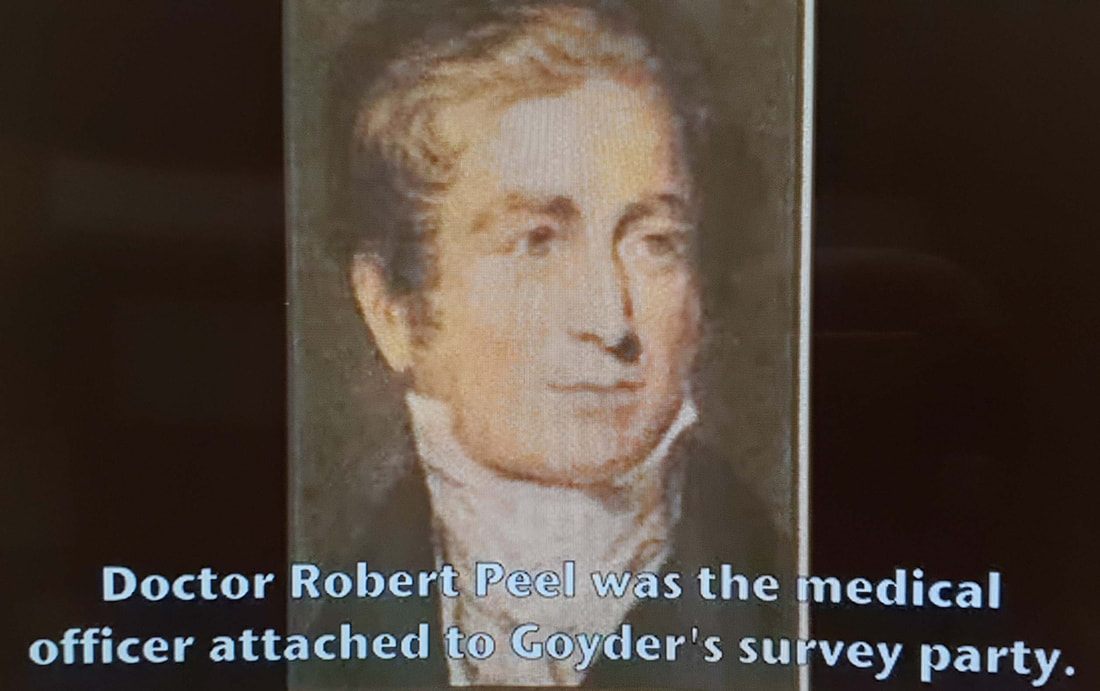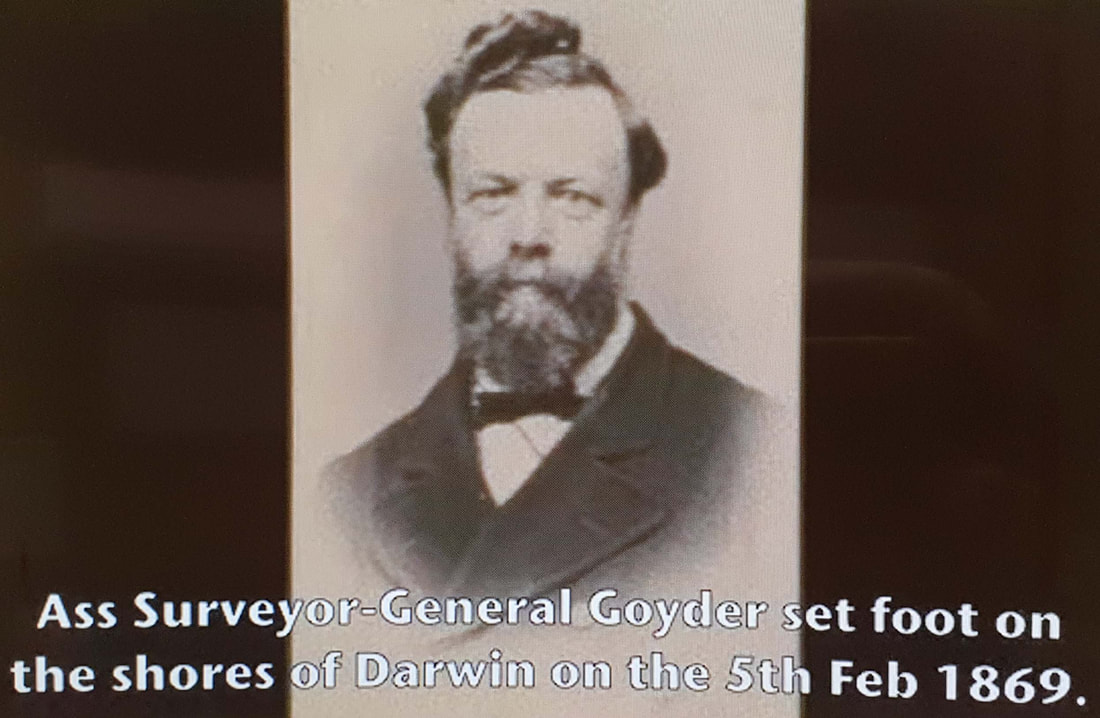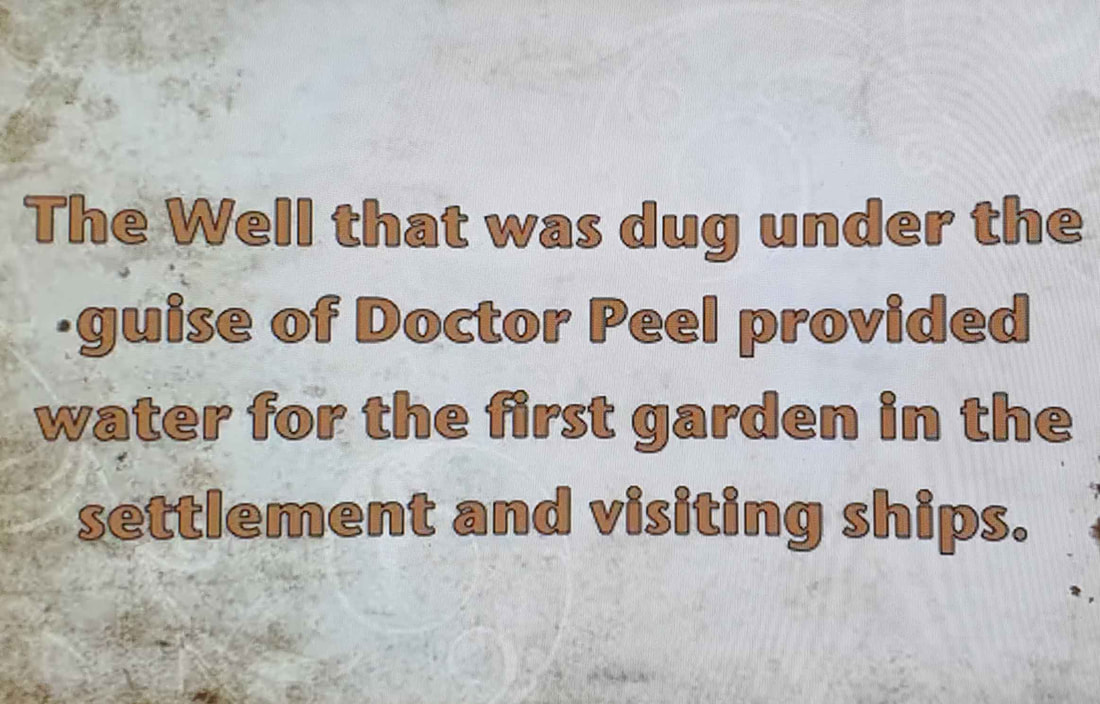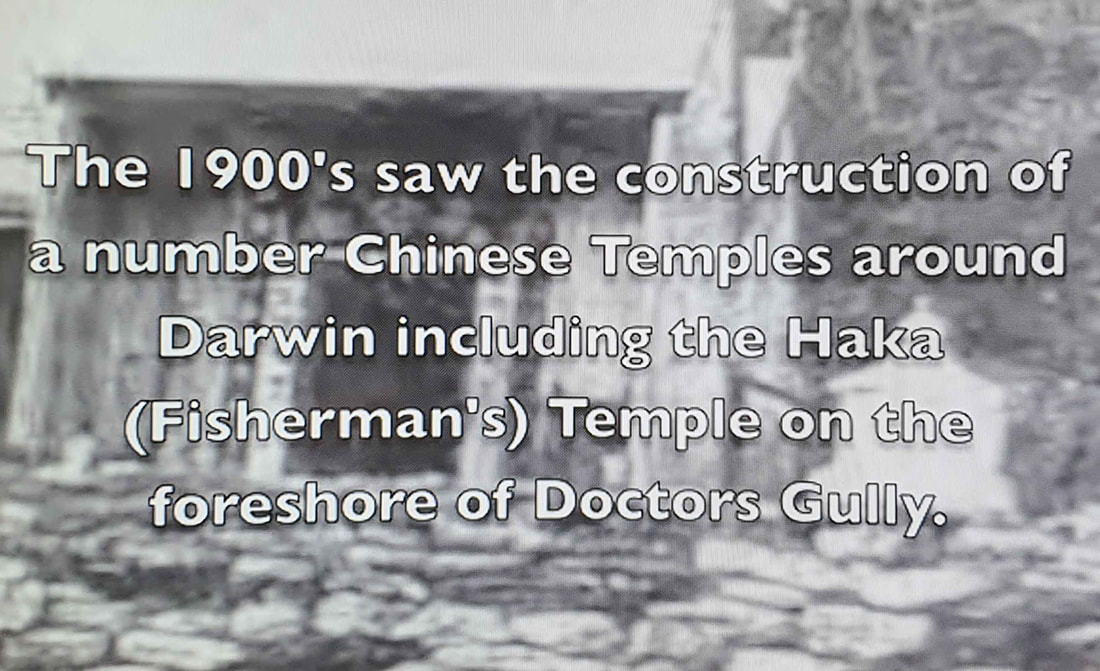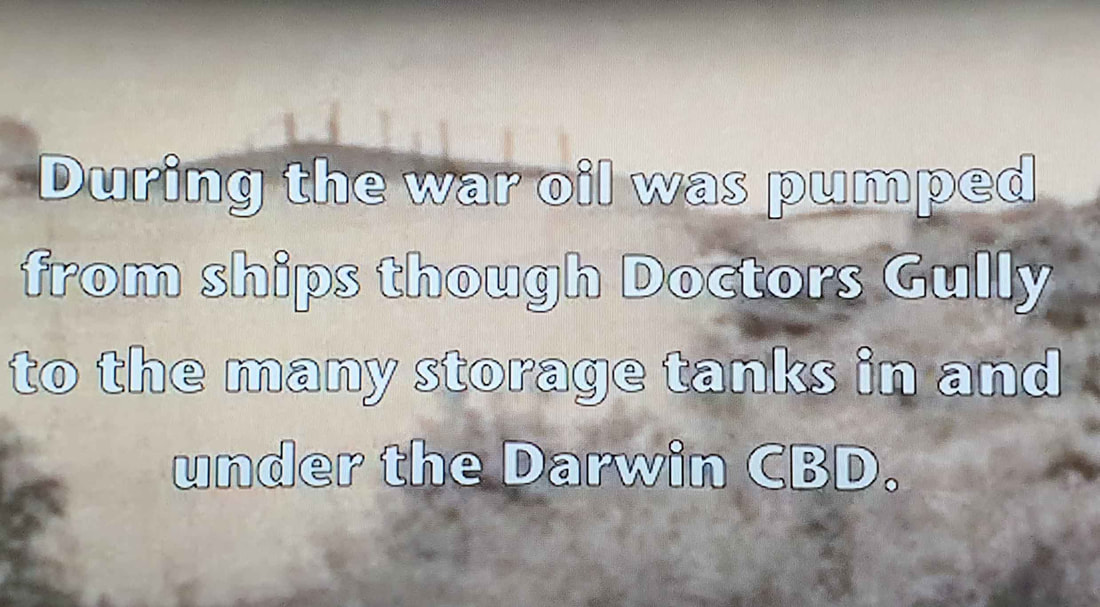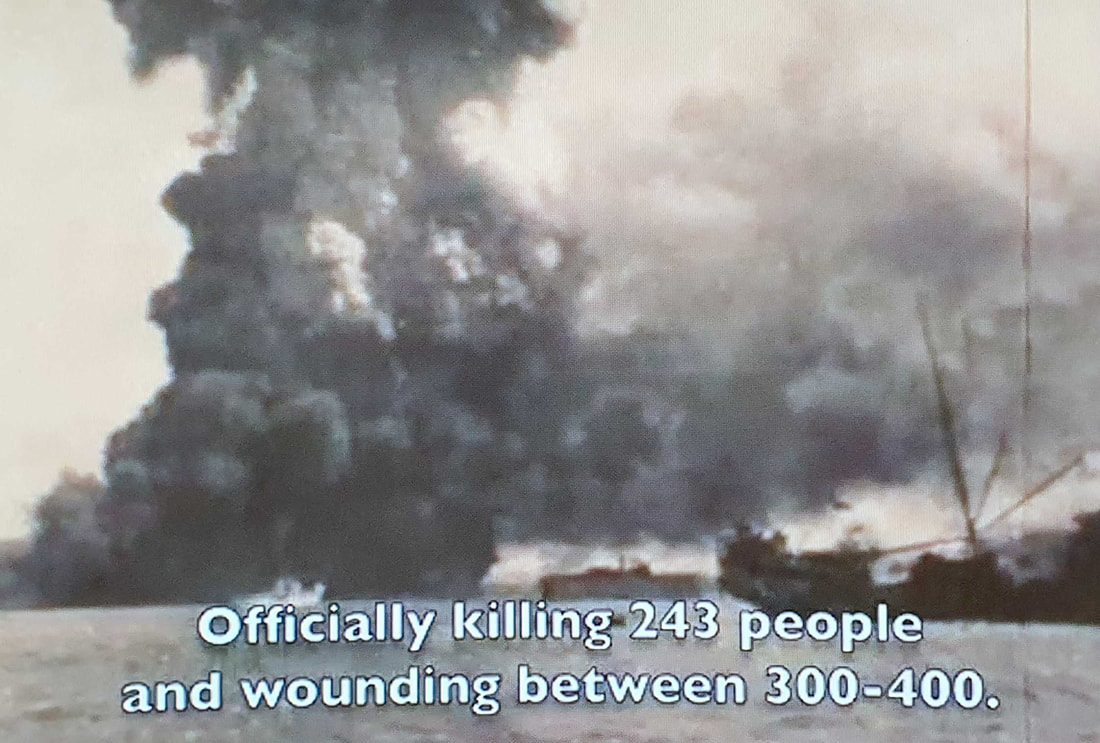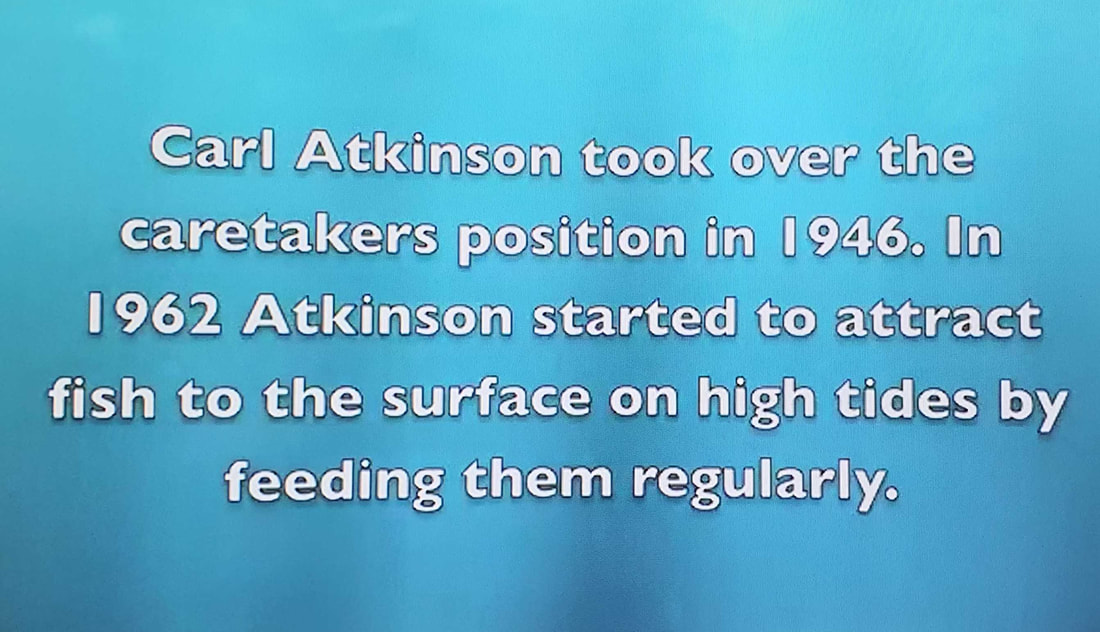RAAF No. 76 Wing Catalina Base ZDG
Doctor's Gully Darwin NT
1944 - 1945
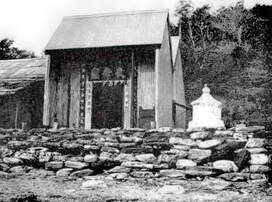 Moo Tai Mue Temple pre 1900
Moo Tai Mue Temple pre 1900
The Moo Tai Mue Chinese Fishermen's Temple and Camp - in the area of the Catalina Ramp in the image below - were razed in 1942 to make way for the RAAF Marine Section to established a maintenance workshop facility at Doctor's Gully for their small craft that supported the few flying boats moored off-shore in pressing need of repairing, re-arming, crew and rescue.
Desperate times:- "During the last two days of February {1942}, Japanese air and naval forces cleared the seas of Allied ships. In the battles of the Java Sea the USS Langley, carrying forty P-40s {Kittyhawks} to Javanese airfields, went down, and the crew of the Sea Witch threw overboard twenty-seven more P-40s to keep them out of enemy hands. Elsewhere in waters off Java, five Allied cruisers and six Allied destroyers fell victim to Japanese air and sea power, and the remnants of the ABDA navy scattered to Ceylon and Australia." (U.S. Army Center of Military History by Charles R. Anderson)
Desperate times:- "During the last two days of February {1942}, Japanese air and naval forces cleared the seas of Allied ships. In the battles of the Java Sea the USS Langley, carrying forty P-40s {Kittyhawks} to Javanese airfields, went down, and the crew of the Sea Witch threw overboard twenty-seven more P-40s to keep them out of enemy hands. Elsewhere in waters off Java, five Allied cruisers and six Allied destroyers fell victim to Japanese air and sea power, and the remnants of the ABDA navy scattered to Ceylon and Australia." (U.S. Army Center of Military History by Charles R. Anderson)
In 1942 the RAAF Marine Vessels Maintenance Facility at Doctor's Gully was under construction and by 8/1/1943 it faced a major expansion with a slipway for vessels up to 3,000 tons. The amount of £200,000 was allocated with works to be completed within 12 months at OTZZU GKLLN BOALN EPPRK GPUMU AHRUY LCUSY HCRUE which decodes as " Site given at Doctors Gully Adjacent to Old Hospital". A visiting geologist put paid to this plan as the ground is unfit for substantial footings which allowed the Flying Boat Base ZDG to develop as Headquarters for RAAF 76 Wing.
On 12th December 1943 Darwin suffered its 64th and final air raid so that by early 1944 the frontline was well to the north and the sheltered cove at Doctor's Gully had become Catalina Flying Boat Base ZDG - Headquarters of RAAF Number 76 Wing - as the epicentre of minelaying operations ranging throughout the Dutch East Indies to the Philippines & as the coast of China, almost within sight of Japan's home islands.
RAAF minelaying and reconnaissance had proven so successful in helping to turn the tide of war against the Japanese that 76 Wing was formed of RAAF 20 Squadron at East Arm in Darwin, 42 Squadron at Melville Bay on the Gove Peninsular and 43 Squadron at Doctor's Gully in Darwin, where 76 Wing had its headquarters. The surgical precision of strategic night-time minelaying by Catalina was performed at such improbable range and by so few aircraft - flying for unrelenting hours over water and at almost zero altitude - that their presence often came as a complete surprise to the Japanese - whose ability to wage war was critically dependent upon the oil, timber and rubber being shipped from their Dutch East Indies conquests through the harbours and inshore seaways to the shipyards and munitions factories in Japan.
Understated, covert and transitory - the Black Cats Squadrons had a profound impact upon the Japanese capacity to wage war. As 'The First & The Furthest' their minelaying activities ended when the mines hit the water, after perhaps a 10 hour flight, but this often signalled the start of bombing, reconnaissance and rescue activities to entertain them on the long flight home to Darwin, as detailed in the Squadron Day Sheets below. These remarkable operations at extreme range were made possible by a close relationship with the US Seventh Fleet's and their flying-boat support ships.
Understated, covert and transitory - the Black Cats Squadrons had a profound impact upon the Japanese capacity to wage war. As 'The First & The Furthest' their minelaying activities ended when the mines hit the water, after perhaps a 10 hour flight, but this often signalled the start of bombing, reconnaissance and rescue activities to entertain them on the long flight home to Darwin, as detailed in the Squadron Day Sheets below. These remarkable operations at extreme range were made possible by a close relationship with the US Seventh Fleet's and their flying-boat support ships.
The photographs above were taken taken from what is now Aquascene looking south. L>R The Catalina is drawn up a ramp on detachable wheels for maintenance. There is a small RAAF vessel moored at the end of the jetty. A wooden boat, without a propeller, is on the maintenance ramp having been drawn up on a bogey frame - one of which is seen at centre of image being assembled from prefabricated parts stacked at right of image. The shadow line is from the roof of the maintenance shed in early afternoon.
RAAF Catalina Squadrons of 76 Wing
HEADQUARTERS 76 WING - DOCTOR'S GULLY DZG - DARWIN NT
|
43 Squadron - Doctor's Gully Darwin
1 May 1943 – Formed at Bowen, Qld 9 April 1944 – HQ moved to ZDG Darwin 3 Dec. 1945 – Move to Rathmines complete 11 March 1946 – Disbanded |
20 Squadron - East Arm Darwin
1 August 1941 - Formed at Port Moresby November 1942 - Moved to Cairns September 1944 - Moved to Darwin November 1945 - Moved to Rathmines NSW 20 March 1946 - Disbanded |
42 Squadron - Melville Bay Gove Peninsular
1 June 1944 - Formed at Darwin NT 11 July 1944 - Established at Melville Bay NT August 1944 - Got Catalinas & did 1st patrols Sept. 1944 - Began minelaying operations. November 1945 - Disbanded |
RAAF 20, 42 & 43 Squadrons were amalgamated in September 1944 as Number 76 Wing with headquarters at Doctor’s Gully to co-ordinate minelaying operations in the North Western Area which included Borneo, the Celebes, Philippines and the coast of China as well as the Northern Territory, part of Queensland and western New Guinea. The long range, night-time operations arguably constituted Australia's first, furthest, longest and most penetrating contribution to the war against Japan. The secret classification of these missions and the seamless collaboration with the United States Seventh Fleet, has shrouded their achievements which are necessarily opaque.
Minelaying sought to deny the enemy's oil tankers access to harbours and inshore sea lanes. This action caused delays whilst mine clearance work was undertaken and it drove the tankers out from shallow inshore waters into the deeper off-shore channels where the US submarines hunted.
During the 1943/45 minelaying campaign, 11 Catalinas were destroyed and eighty-four crew lost their lives - thirty-seven from 20 Squadron - eighteen from 43 Squadron and nine lost by 42 Squadron. Twenty men were lost by 11 Squadron on minelaying missions and though based at Rathmines on Lake Macquarie in NSW they augmented major missions of 76 wing out of Darwin - such as the Manila Raid and some of their aircraft engaged in other roles including pamphleteering - others, such as A24-47 FJ*K, seem to have been permanently based at Doctors Gully in various guises.
The Catalina was the only RAAF aircraft that was on the frontline throughout the Pacific War. Out of a total RAAF fleet of 168 Catalinas - 64 were lost and a total of 320 airmen lost their lives. "The First and the Furthest" indeed.
Minelaying sought to deny the enemy's oil tankers access to harbours and inshore sea lanes. This action caused delays whilst mine clearance work was undertaken and it drove the tankers out from shallow inshore waters into the deeper off-shore channels where the US submarines hunted.
During the 1943/45 minelaying campaign, 11 Catalinas were destroyed and eighty-four crew lost their lives - thirty-seven from 20 Squadron - eighteen from 43 Squadron and nine lost by 42 Squadron. Twenty men were lost by 11 Squadron on minelaying missions and though based at Rathmines on Lake Macquarie in NSW they augmented major missions of 76 wing out of Darwin - such as the Manila Raid and some of their aircraft engaged in other roles including pamphleteering - others, such as A24-47 FJ*K, seem to have been permanently based at Doctors Gully in various guises.
The Catalina was the only RAAF aircraft that was on the frontline throughout the Pacific War. Out of a total RAAF fleet of 168 Catalinas - 64 were lost and a total of 320 airmen lost their lives. "The First and the Furthest" indeed.
The number of US personnel attests to the close collaboration with the US Seventh Fleet. Tom Moorer (later Admiral & Head JCS ) was the pilot of a US Navy Catalina inspecting the Don Isidro on the morning of the 19th February 1942 when shot down by Japanese planes coming in to blitz Darwin. He & his crew were rescued by the Florence D which was promptly sunk by returning Japanese aircraft. Washed up on Bathurst Island, they were spotted by the locals, rescued and returned to Darwin by the Missionary.
Returning PoWs
AWM NWA0980/81 & 83 - Darwin, NT. c. September 1945. Survivors disembarking from a Consolidated Catalina aircraft, code RK-0, serial no. A24-95, of No. 42 Squadron RAAF, into a RAAF launch, no. 011-12, on arrival at Darwin after they had been picked up from a Japanese hospital. The survivors were from the United States Army Air Force flying in a Douglas C47 transport aircraft which crashed into the sea. The survivors, washed ashore on Jamdena Island in the Tanimbar Group, were Captain Otto Leipske of Waukesha, Wisconsin, pilot; Lieutenant Howie Crothers of Little Rock, Arkansas, 2nd pilot; Captain John Rodof of Tulsex, Oklahoma, a passenger; Sergeant Frank Termin of Borger, Texas, radio operator; and Corporal Eugene Janicker of Cameron, Texas, an engineer."
AWM 119127 -'Manila, Philippines 1945-10-07. After a medical examination, debriefing and a new issue of kit, ex-prisoners were evacuated from the 3rd Australian prisoner of war reception group to Darwin by Catalina. 3 Catalinas left Sangley Point each day carrying 20 men and flew to Darwin with an overnight stay at Morotai. From Darwin they were flown to Sydney by Liberators. On the return trip the Catalinas flew direct from Darwin to Manila. At first-light the roll being called by vx112422 Lt N. J. Orr, 3 Aust prisoner of war reception group, air movements officer'. (photographer Lt N. B. Stuckey)
Catalina Overhaul 43 Squadron 1944
The images below are of the same aircraft being worked on in 1944 at Doctor's Gully - one image is from the State Library of WA with the location unknown and the second is courtesy of the late Reg Marr DFC - it appears at the end of the attached Pdf 'The Catalina Flying Memorial'. The middle image is from the Australian War Memorial. Engineers, Painters and Armourers are present.
It is apparent that these images were taken of the same aircraft on the same day - two have only the starboard cowlings raised, the position of ladders etc is the same and the port propeller does not match the 12 o'clock position. The port side underwing antenna. Individual ground crew are identifiable - e.g. the officers & the blonde lad. These factors are also evident in the raw crop of the Catalina below.
AWM description of central image (NWA0879) indicates that armourers installed the 'eye-ball turret' at this time.
"Darwin, NT. 1944-06-24. Repairs being carried out to the hull of a Catalina aircraft of No. 43 Squadron RAAF by fitters, armourers and riggers. Left to right: Leading Aircraftman (LAC) G. R. Clark of Benalla, Vic; LAC H. J. Rynhart of Hawthorne, NSW; Sergeant L. E. Mason of Narrandera, NSW (head showing in cockpit); Sergeant R. H. Baker of Brisbane, Qld; LAC C. F. Anderson of Mount Larcom, Qld, and person behind prop at right unknown."
"Darwin, NT. 1944-06-24. Repairs being carried out to the hull of a Catalina aircraft of No. 43 Squadron RAAF by fitters, armourers and riggers. Left to right: Leading Aircraftman (LAC) G. R. Clark of Benalla, Vic; LAC H. J. Rynhart of Hawthorne, NSW; Sergeant L. E. Mason of Narrandera, NSW (head showing in cockpit); Sergeant R. H. Baker of Brisbane, Qld; LAC C. F. Anderson of Mount Larcom, Qld, and person behind prop at right unknown."
The serial number is not clear but A24-47 and the code OX-Q seem most likely - the use of codes OX-O, OX-Q & OX-D makes identification difficult. The presence of senior ranks inspecting the paintwork matches with concerns raised in the images from ADF Serials Telegraph Newsletter (Volume 10 Issue 1. Autumn of 2020). Also noted is the standard top of the wing camouflage markings in the correct location over the leading edge. The nomenclature 'The Dabster' for A24-64 OX-D was reportedly added at Bowen during a major refit - as 'The Dabster' is photographed off Doctor's Gully on the same day.
The standard RAF red roundel was removed after a US Navy Grumman F4F Wildcat shot down a RAAF Catalina injuring the pilot Mike Seymour. Soon thereafter in March 1942 RAA gunners at Port Moresby's Seven Mile Strip mistook new 4 RAAF Kittyhawks of 75 Sqn for Japanese Zeros damaging three and destroying the other one but without loss of life. The replacement roundel was the white on blue within a gold ring. These were muted for Black Cats.
The numbering of PBY Catalinas is as problematic as the colour scheme and concerns over the quality of the paint job may be a result of painting anything during the build-up. Painting metal in direct sunlight in the middle of the day without masking suggests it was a necessity.
The 3 letter 'Squadron Code' code consisted of 2 letters for the squadron (e.g. OX for 43 Sqn) a dash to represent the roundel & a single letter for the aircraft e.g. OX-D. This was completed during the 1st half of 1943. The roundels returned in late 1943 & the eye-ball turret was introduced from mid 1944.
The 3 letter 'Squadron Code' code consisted of 2 letters for the squadron (e.g. OX for 43 Sqn) a dash to represent the roundel & a single letter for the aircraft e.g. OX-D. This was completed during the 1st half of 1943. The roundels returned in late 1943 & the eye-ball turret was introduced from mid 1944.
Doctors Gully RAAF Marine Support facility became a Flying Boat Base in 1943
RAAF 43 Sqn moved to Doctors Gully in April 1944.
A24-4 was reassigned to 20 Sqdn & re-coded RB-X on 3/4/1942 before codes were painted on aircraft and before Doctors Gully became operational.
Therefore A24-4, which survived the war, could not have been at Doctor's Gully whilst coded OX-D
A24-64 'The Dabster' (viz a Dab Hand) was a PBY 5, was coded XO-D - she was located at Doctor's Gully and had a highly successful career until 14th December 1944 when lost in action with all hands near Cape Calavite on Mindoro island in the Philippines.
RAAF 43 Sqn moved to Doctors Gully in April 1944.
A24-4 was reassigned to 20 Sqdn & re-coded RB-X on 3/4/1942 before codes were painted on aircraft and before Doctors Gully became operational.
Therefore A24-4, which survived the war, could not have been at Doctor's Gully whilst coded OX-D
A24-64 'The Dabster' (viz a Dab Hand) was a PBY 5, was coded XO-D - she was located at Doctor's Gully and had a highly successful career until 14th December 1944 when lost in action with all hands near Cape Calavite on Mindoro island in the Philippines.
|
FL Herbert Cunningham ROBERTS (406368) Aged 32
FL Frank William SILVESTER (411054) Aged 24 FO Robert Carlisle BARBOUR (419949) Aged 20 FL James Henry COX (411867) Aged 25 FO Raymond Harold BRADSTREET (406824) Aged 23 Sgnt James Robert ROBINSON (37766) Aged 34 FSDavid John ALBERT (37077) Aged 32 Sgnt John Charles MacDONALD (15882) Aged 29 Sgnt Harold Stanley GOODCHILD (82777) Aged 19 Average age at death - 26 years. |
"The Catalina A24-64 was handed over to Flying Officer I. O. Righetti's crew who had arrived at the squadron in the first week of October 1941. By the end of month, Righetti's crew had completed their first anti-submarine patrols and bombing missions to Ambon (Indonesia) and Kavieng (Papua New Guinea). Although she was used intermittently by other crews on patrols and bombing missions, Righetti's crew remained the regular crew and it was Righetti who named her “The Dabster” because of her special talents. The name was subsequently painted on her nose.
Twenty-four Catalinas were required to lay mines at a very low altitude to prevent the Japanese leaving Manila Bay and interfering with the Mindoro landing. “The Dabster” was number six in a sortie of 15 aircraft that took off from Jinamoc.
Tragically, “the Dabster” never returned to Jinamoc on completion of the mission. It most likely came down somewhere over Manila Bay not far from here.
The crew would not have known about the Japanese anti-aircraft gun emplacement located here at Barangay Alas-asin and it is highly likely that the aircraft was shot down from this location...........They were the first of 56 Australians killed over the next 23 days during the Mindoro and Lingayen Gulf landing phase of the Liberation of the Philippines that continued until 5 July 1945." Ambassador Bill Tweddell’s Address - RAAF Catalina A24-64 Dedication - Maritime Academy of the Philippines and the Pacific - Bataan, 23 April 2015
Twenty-four Catalinas were required to lay mines at a very low altitude to prevent the Japanese leaving Manila Bay and interfering with the Mindoro landing. “The Dabster” was number six in a sortie of 15 aircraft that took off from Jinamoc.
Tragically, “the Dabster” never returned to Jinamoc on completion of the mission. It most likely came down somewhere over Manila Bay not far from here.
The crew would not have known about the Japanese anti-aircraft gun emplacement located here at Barangay Alas-asin and it is highly likely that the aircraft was shot down from this location...........They were the first of 56 Australians killed over the next 23 days during the Mindoro and Lingayen Gulf landing phase of the Liberation of the Philippines that continued until 5 July 1945." Ambassador Bill Tweddell’s Address - RAAF Catalina A24-64 Dedication - Maritime Academy of the Philippines and the Pacific - Bataan, 23 April 2015
RAAF Black Cats by Cleworth and Linton devotes a chapter to 'The Manila Raid' pp95 -115
"In March 2019, an RAAF reconnaissance mission in the Philippines discovered the wreckage of A24-64 in bushland, south-east of Cape Calavite on the north-west of Mindoro Island. The site is along the route A24-64 was flying to its target to mine shipping lanes in Manila Harbour when it crashed into the mountain. The RAAF has accepted that the evidence found at the crash site is of A24-64 and a full investigation is planned for 2020. Until then, an official reason why A24-64 FTR (failed to return) is still unknown."p114. Presumably SBC (stuffed by covid).
"In March 2019, an RAAF reconnaissance mission in the Philippines discovered the wreckage of A24-64 in bushland, south-east of Cape Calavite on the north-west of Mindoro Island. The site is along the route A24-64 was flying to its target to mine shipping lanes in Manila Harbour when it crashed into the mountain. The RAAF has accepted that the evidence found at the crash site is of A24-64 and a full investigation is planned for 2020. Until then, an official reason why A24-64 FTR (failed to return) is still unknown."p114. Presumably SBC (stuffed by covid).
| ||||||||
‘Wings beneath the sea: identification of Darwin Harbour Catalina flying boat wreck sites’. Jung, S. 2001. Unpublished Master of Arts thesis, NTU, Darwin
References
Eather, Steve (1995). Flying Squadrons of the Australian Defence Force. Weston Creek: Aerospace Publications. ISBN 1-875671-15-3.
Cleworth R & Linton JS (2019) RAAF Black Cats
Odgers, George (1968) [1957]. Air War Against Japan 1943–1945. Australia in the War of 1939–1945. Series 3 – Air. Volume 2 (reprint ed.). Canberra: Australian War Memorial. OCLC 246580191.
RAAF Historical Section (1995). Units of the Royal Australian Air Force. A Concise History. Volume 4 Maritime and Transport Units. Canberra: Australian Government Publishing Service. ISBN 0-644-42796-5.
No. 42 Squadron. "Operations Record Book – Forms A50 and A51 Number 42 Squadron Jun 44 – Oct 45". Record Search. National Archives of Australia.
Eather, Steve (1995). Flying Squadrons of the Australian Defence Force. Weston Creek: Aerospace Publications. ISBN 1-875671-15-3.
Cleworth R & Linton JS (2019) RAAF Black Cats
Odgers, George (1968) [1957]. Air War Against Japan 1943–1945. Australia in the War of 1939–1945. Series 3 – Air. Volume 2 (reprint ed.). Canberra: Australian War Memorial. OCLC 246580191.
RAAF Historical Section (1995). Units of the Royal Australian Air Force. A Concise History. Volume 4 Maritime and Transport Units. Canberra: Australian Government Publishing Service. ISBN 0-644-42796-5.
No. 42 Squadron. "Operations Record Book – Forms A50 and A51 Number 42 Squadron Jun 44 – Oct 45". Record Search. National Archives of Australia.
|
Roslyn Jan of Sydney is the daughter of Gilbert Jann who was born in Darwin in 1924 and evacuated to Sydney after the Bombing of Darwin. On 2nd Sept. 1942 he enlisted at Hurstville to serve as a Leading Aircraftsman (69640). His daughter, Roslyn recalls that he served on minelaying Catalinas with RAAF 43 Squadron at Doctor's Gully. He is now 97 and frail but the story of his rescue and reunion after nearly 70 years with Tom Fogg RN {The Fogg of War} is a classic.
JANN GILBERT : Service No. - 69640 : DoB - 07 Sep 1924 : Place of birth - DARWIN NT : Place of enlistment - SYDNEY : Next of Kin - JANN PHILIP Citation NAA: A9301, 69640 Location Canberra Access status Not yet examined Date of decision 01 Jan 1970 |
Fuel Tank Doctor's Gully
Orientation
RAAF 76 Wing Squadrons
RAAF 20 Squadron
"Formed on 1 August 1941 at Port Moresby with six Consolidated Catalina Flying Boats under the command of Squadron Leader WN Gibson DFC, No 20 Squadron's operations comprised coast-watching & reconnaissance, with patrols covering New Guinea , New Britain , New Ireland , the Solomon Islands and New Caledonia.
In association with No 11 Squadron, an aircraft from each unit was sent to Western Australia in November 1941 to assist in the search for survivors from HMAS Sydney.
The first anti-submarine patrol was carried out on 17 December 1941, without success.
In May 1942, No 20 Squadron moved to Bowen, Queensland, with its main role seaward reconnaissance for the entire New Guinea to Solomon Islands to New Caledonia area.
The squadron changed its operations to mine-laying in Japanese-held ports in the Dutch East Indies from June 1943 until October 1945, when it assisted with the repatriation of prisoners-of-war until its move to Rathmines, New South Wales.
During its short history, the squadron had many moves. From Port Moresby to Cairns in November 1942, then to Darwin in September 1944, and finally to Rathmines in November 1945. The squadron was finally disbanded on 27 March 1946." RAAF Museum
In association with No 11 Squadron, an aircraft from each unit was sent to Western Australia in November 1941 to assist in the search for survivors from HMAS Sydney.
The first anti-submarine patrol was carried out on 17 December 1941, without success.
In May 1942, No 20 Squadron moved to Bowen, Queensland, with its main role seaward reconnaissance for the entire New Guinea to Solomon Islands to New Caledonia area.
The squadron changed its operations to mine-laying in Japanese-held ports in the Dutch East Indies from June 1943 until October 1945, when it assisted with the repatriation of prisoners-of-war until its move to Rathmines, New South Wales.
During its short history, the squadron had many moves. From Port Moresby to Cairns in November 1942, then to Darwin in September 1944, and finally to Rathmines in November 1945. The squadron was finally disbanded on 27 March 1946." RAAF Museum
RAAF 42 Squadron (ZMB ?)
|
"Formed in the Northern Territory in June 1944, No 42 Squadron was soon deployed to New Guinea. Operating from Melville Bay, the unit's Catalinas flew reconnaissance and escort missions. However, by the end of the year, the squadron's role was concentrated on mine-laying operations. The squadron's highly successful mine-laying campaign soon sealed off most of the Celebes from coast-hugging Japanese vessels.
In October 1944, a No 42 Squadron Catalina damaged by anti-aircraft fire made a forced landing south of Japanese-occupied Celebes. Flying through enemy-held territory, a No 41 Squadron Catalina, accompanied by a B-24 Liberator, rescued the crew before destroying the downed Catalina to prevent its capture. A journey of nearly 2,500 kilometres through enemy airspace, this mission ranks as one of the epic sea rescues of the Pacific theatre. No 42 Squadron's mine-laying operations continued until the end of hostilities. Following the war, the Catalinas assisted in the repatriation of POWs and other personnel until November 1945, when the squadron was disbanded." RAAF Museum Point Cook - Is that it - do they think Melville Bay is in New Guinea???? |
RAAF 43 Squadron
'Early in April 1944, Wing Commander Thompson lead Flight Lieutenants Gray, Righetti & Marr, Flight Sergeant Abbey & Pilot Officer Longmuir, on the first of many 'special missions ' – the night time laying of mines in enemy waters & harbours. Abbey did not return from this mission. Gray's aircraft was hit by anti-aircraft fire - he & his second pilot were injured. The crew crash-landed on a beach upon return.
Aircraft staged through 'Shecat' and as far afield as Morotai to complete their missions. The Catalinas flew up to 25 hours on individual mining tasks & blockaded areas such as the Hainan, Surabaja and Laoet Straits & harbours at Hong Kong, Amoy, Seroea and Pascadores Islands. The last mining mission undertaken by 43 Squadron was on the night of 29 July 1945, when mines were dropped in Bangka Strait.
43 Squadron flew air-sea rescue sorties in support of long range bomber strikes on targets in the Dutch East Indies (now Indonesia), as well as harassing Japanese facilities at Mandac, Lomboeng, Boeloedoang, Kendari and Ambesia. Flying Officer Temperley & crew were reported missing on 21 July 1944.
The Squadron flew anti-shipping strikes - notably on 26 June 1944. Squadron Leader L.M. Hurt & crew made a torpedo attack on an enemy merchant ship anchored in Bima Bay. Although the Catalina faced intense anti-aircraft fire, Hurt successfully dropped his torpedo, but was seriously injured in the process. The second pilot, Flying Officer B.A. Titshall, flew the aircraft back to base under difficult conditions.
The War ended in August 1945 but 43 Squadron continued patrols over the Dutch East Indies & the approaches to Darwin until notified of the move to Rathmines, NSW, at the end of the month. The advance party, under the command of Flight Lieutenant O.K. Crewes, departed on the 15th, and the move of the Squadron from Doctor's Gully had been completed by 3 December 1945.
Notification was received from Headquarters Eastern Area that the Squadron would cease operations on 1 February 1946 and the unit was disbanded on 11 March 1946.' RAAF Museum Point Cook - Compiled by Steve Larkins April 2016 - Bibliography Vincent, D., Catalina Chronicle, Highbury, SA, 1981.
Aircraft staged through 'Shecat' and as far afield as Morotai to complete their missions. The Catalinas flew up to 25 hours on individual mining tasks & blockaded areas such as the Hainan, Surabaja and Laoet Straits & harbours at Hong Kong, Amoy, Seroea and Pascadores Islands. The last mining mission undertaken by 43 Squadron was on the night of 29 July 1945, when mines were dropped in Bangka Strait.
43 Squadron flew air-sea rescue sorties in support of long range bomber strikes on targets in the Dutch East Indies (now Indonesia), as well as harassing Japanese facilities at Mandac, Lomboeng, Boeloedoang, Kendari and Ambesia. Flying Officer Temperley & crew were reported missing on 21 July 1944.
The Squadron flew anti-shipping strikes - notably on 26 June 1944. Squadron Leader L.M. Hurt & crew made a torpedo attack on an enemy merchant ship anchored in Bima Bay. Although the Catalina faced intense anti-aircraft fire, Hurt successfully dropped his torpedo, but was seriously injured in the process. The second pilot, Flying Officer B.A. Titshall, flew the aircraft back to base under difficult conditions.
The War ended in August 1945 but 43 Squadron continued patrols over the Dutch East Indies & the approaches to Darwin until notified of the move to Rathmines, NSW, at the end of the month. The advance party, under the command of Flight Lieutenant O.K. Crewes, departed on the 15th, and the move of the Squadron from Doctor's Gully had been completed by 3 December 1945.
Notification was received from Headquarters Eastern Area that the Squadron would cease operations on 1 February 1946 and the unit was disbanded on 11 March 1946.' RAAF Museum Point Cook - Compiled by Steve Larkins April 2016 - Bibliography Vincent, D., Catalina Chronicle, Highbury, SA, 1981.
43 Squadron Codes from 1943 - ADF Serials Vol. 10 - Issue 1 p89
The following from ADF Serials Vol. 10.1 gives a clear explanation for aircraft appearing to have OXO on one side and POX on the other.
Identity of Black Cat
Additional Material
AWM NWA0878A -
"Darwin, NT. 1944-06-24. Maintenance workers check the engines of a Catalina aircraft of No. 43 Squadron RAAF prior to a mission. Left to right: Leading Aircraftman (LAC) J. C. Howarth, Peelwood, NSW; LAC J. A. Britt of Kangaroo Point, Qld (flight Mechanic); Flight Lieutenant J. F. Arnott of Pymble, NSW; LAC L. J. Hardcastle of Tamworth, NSW; LAC E. A. Robinson of Newcastle, NSW, (sitting on engine stand) LAC C. J. Whalan of Clarence River, NSW.
"Darwin, NT. 1944-06-24. Maintenance workers check the engines of a Catalina aircraft of No. 43 Squadron RAAF prior to a mission. Left to right: Leading Aircraftman (LAC) J. C. Howarth, Peelwood, NSW; LAC J. A. Britt of Kangaroo Point, Qld (flight Mechanic); Flight Lieutenant J. F. Arnott of Pymble, NSW; LAC L. J. Hardcastle of Tamworth, NSW; LAC E. A. Robinson of Newcastle, NSW, (sitting on engine stand) LAC C. J. Whalan of Clarence River, NSW.
|
P01630.011 Description
Darwin, NT. 1944-08-20. Crew of no. 20 squadron RAAF consolidated Catalina A24-95 viewing the damage caused by an explosive bullet that passed through a fuel tank missing fuel and oil lines on their first mission. Left to right: back row: 19805 sergeant Donald Kelway (Don) Storrie (1st engineer); flight sergeant Ron Black (2nd pilot); 419457 flight sergeant James Reginald (reg) Cleworth (navigator); 417318 flight sergeant Ross Schulz (captain and pilot); middle row: 65674 sergeant Bill Rowe (2nd engineer); 410296 wireless operator 'Snow' Bates, wireless/air gunner; flight sergeant Fred Robins, a passenger pilot on the trip for experience; front row: 67895 sergeant Alfred Russell (Rus) Jones; warrant officer William Voss (snow) bates (1st crew); 73252 sergeant Walter (Scottie)S (2nd crew). All the above were killed in action 7 March 1945 except black and robins who survived the war. (Donor: JR Cleworth) |
The Australian PBY5's were modified for night minelaying work and carried the designation (M) after the serial number. Apart from the black livery the craft was deprived of the latest additions to reduce weight and so increase range/load. As they typically operated below 150ft over water and at night, the removal of protective armour plating was not an issue but the removal of the leakproof baffles from the fuel tanks meant that any stray round could be catastrophic which is why this seemingly minor damage deserved a group photo.
AWM NWA0702 - Darwin, NT. c. 1944. 15882 Sergeant J. C. MacDonald of Manly, NSW and 37077 Sergeant David John Albert of Auburn, NSW, both members of a Consolidated Catalina Squadron RAAF, carrying their equipment and gear that is required on long flights north of Australia. Sgt Albert was lost on operations over the Philippines on 14 December 1944
Catalina was the name given to the PBY by the RAF after a small island off San Diego.
Minelaying Catalinas in Australia e.g. A24-64(M) were mostly painted black for night ops and called Black Cats.
Main defensive characteristics were extreme range & lack of speed - retaining good handling characteristics at very low altitude, to which they would descend when attacked, ensuring the opponent rapidly overflew them.
Minelaying Catalinas in Australia e.g. A24-64(M) were mostly painted black for night ops and called Black Cats.
Main defensive characteristics were extreme range & lack of speed - retaining good handling characteristics at very low altitude, to which they would descend when attacked, ensuring the opponent rapidly overflew them.
Aviation fuel & boat fuel came in 44 gallon drums - US ones were galvanised. The large concrete tanks at ZDG held naval fuel oil - these were installed along the Esplanade from the Stokes Hill Tank Farm after two were lost in the 'Darwin Blitz'. The tanks were connected by a pipeline to the pumping station which survives beside Indo-Pacific Marine & pumping gear survives at Doctor's Gully.
Long Range - longest flight 31hrs? maybe double sunrise - longest mission just over 24hrs?? Motto "The First and the Furthest"
AWM images NWA0897 & 0898 - Darwin, NT. 1945-05-28. 22986 Flight Sergeant J. W. N. Stretton of Hawthorne, Qld, with other members of the RAAF, adjust the racks during the loading of a mine under a Consolidated Catalina aircraft of No. 43 Sqn RAAF. Left image background shows naval fuel oil pipeline.
Fatal accident with mine falling out of racks through boat to depth and detonating - was it at ZDG or ZEA ?
USN Flying-boat & submarine support vessels - was it Preston ?? Houston had 4 of her own & at Pt Darwin - brass light etc brassed up Sunda Strait.
USN Flying-boat & submarine support vessels - was it Preston ?? Houston had 4 of her own & at Pt Darwin - brass light etc brassed up Sunda Strait.
Images 24-6-1944 - what was so important about this day - why was Gore there
D-Day was 6th June - the 24th was a Saturday - 24/6/1571 Manila was founded & mining of Manila Harbour would be the largest & most successful RAAF minelaying mission - A Day in the Life of ZDG - it cannot have been an inspection/VIP visit as the beer bottled would've been cleared away.
Maintenance at Sea

DARWIN, NT. 1942-02. A PBY Catalina taxis across the harbour. Shipping in the background includes (left to right) the transport Zealandia, the hospital ship Manunda and an American transport. The photograph was taken shortly before the Japanese air raid of 1942-02-19. (Naval Historical Collection). Maker: R. R. Babb - AWM 304966

AWM image 304965 'DARWIN, NT. 1942-02. A Catalina on the harbour. Shipping in the background includes (left to right) the hospital ship Manunda, an American transport, the tanker British Motorist and the floating dock. The photograph was taken shortly before the Japanese air raid of 1942-02-19. (Naval Historical Collection).
Doctor's Gully - Aquascene
East Arm Flying Boat Base ZEA - 20 Squadron
Completed 23 September 1943
Presumably an image of East Arm (ZEA?) looking east from the ramp with the end of the island at right - sheltered but shallow.
‘Wings beneath the sea: identification of Darwin Harbour Catalina flying boat wreck sites’. Jung, S. 2001. Unpublished Master of Arts thesis, NTU, Darwin
The Wider Catalina Minelaying & Secondary Operations
The following summarise the activity and impact of Catalina operations during 1944 & 1945 with quotations principally drawn from RAAF Black Cats by Robert Cleworth & John Suter Linton.
'The RAAF Catalinas laid 2512 mines during 1210 mine-laying sorties flown over 240 night and of those 1130 were successful. Just 7 per cent of the 80 unsuccessful sorties were due to mechanical or radar breakdowns.' Of the 'unsuccessful sorties' - 90% were subsequently completed. P191
Some difficulties are inherent in quantifying the efficacy of mine-laying as the methodology is disruptive of supply - creating shortages & uncertainty through closing harbours and forcing ships to divert into unprotected deep water. A necessarily clandestine ingredient of victory, it has suffered, like code-breaking, from being considered not quite decent in the public mind and potentially too useful in future wars to be disclosed. Some 80% of Japan's oil passed through one harbour in the old Dutch East Indies which became a favourite courting haunt for 76 Wing - one finger on the jugular.
"The US Navy elected the target and supplied mine experts, while the planning and execution were controlled exclusively by the RAAF........the fact that (Catalina operations) were part of the Fifth Air Force and the US Navy Seventh Fleet strategies, has led to many of their exploits being absorbed into the American history of the war."
It is not surprising therefore that little is known of a USN Catalina crewman, based at Darwin in February 1942, who was an outstanding pilot - was repeatedly decorated for heroic deeds - who rose steadily to the rank of Admiral and Head of the Joint Chiefs of Staff without so much as a corn cob pipe.
Statistics aside - the Squadron Operations Record Books are a way into this history - the suffix Z denotes GMT Greenwich Mean Time – each time-zone had a designation letter for being so many hours +/- GMT and the introduction of national Daylight Saving in 1942 created further complications. Activities are coded such as Courting for Mining and Serenading for harassing the enemy at night and the targets were also coded, Granny, Squaw, Spinster, Trollop & Skirt etc. and not all of these have been unravelled.
'The RAAF Catalinas laid 2512 mines during 1210 mine-laying sorties flown over 240 night and of those 1130 were successful. Just 7 per cent of the 80 unsuccessful sorties were due to mechanical or radar breakdowns.' Of the 'unsuccessful sorties' - 90% were subsequently completed. P191
Some difficulties are inherent in quantifying the efficacy of mine-laying as the methodology is disruptive of supply - creating shortages & uncertainty through closing harbours and forcing ships to divert into unprotected deep water. A necessarily clandestine ingredient of victory, it has suffered, like code-breaking, from being considered not quite decent in the public mind and potentially too useful in future wars to be disclosed. Some 80% of Japan's oil passed through one harbour in the old Dutch East Indies which became a favourite courting haunt for 76 Wing - one finger on the jugular.
"The US Navy elected the target and supplied mine experts, while the planning and execution were controlled exclusively by the RAAF........the fact that (Catalina operations) were part of the Fifth Air Force and the US Navy Seventh Fleet strategies, has led to many of their exploits being absorbed into the American history of the war."
It is not surprising therefore that little is known of a USN Catalina crewman, based at Darwin in February 1942, who was an outstanding pilot - was repeatedly decorated for heroic deeds - who rose steadily to the rank of Admiral and Head of the Joint Chiefs of Staff without so much as a corn cob pipe.
Statistics aside - the Squadron Operations Record Books are a way into this history - the suffix Z denotes GMT Greenwich Mean Time – each time-zone had a designation letter for being so many hours +/- GMT and the introduction of national Daylight Saving in 1942 created further complications. Activities are coded such as Courting for Mining and Serenading for harassing the enemy at night and the targets were also coded, Granny, Squaw, Spinster, Trollop & Skirt etc. and not all of these have been unravelled.
In total, the RAAF received 168 Catalinas - two early PBY-4 flying-boats transferred from the Dutch East Indies - sixty-six PBY-5 Flying-boats - forty-six PBY-5A Amphibians and fifty-four PB2B Flying-boats. A total of twenty-nine PBY-5A Amphibians were modified at Rathmines in a 1500 man/hour conversion that returned the aircraft to pure Flying-boat configuration - including weight reduction by removal of the under-carriage to increase range & payload. These newer, converted PBY-5A (M) {for Mining} aircraft replaced the older PBY-5s in the Black Cat squadrons which would mine harbours and sea-lanes whilst the remaining older aircraft performed routine Air Sea Rescue and Patrol duties.
A.S.R. Air Sea Rescue
|
"A Consolidated Catalina aircraft, serial number A24-100 and squadron code RK-L, of 42 Squadron, RAAF. This aircraft was forced to make an emergency landing on the sea, south of the South Western Celebes Peninsula after completing a mine laying operation over Macassar (Celebes) Harbour on the night of 23/24 October 1944. The aircraft suffered damage in the starboard engine, caused by Japanese anti-aircraft (AA) fire and on the return journey, the Catalina captain, 401846 Pilot Officer (PO), Clifford Dent Hull of Hawthorn, Vic, was able to make a forced landing on the open sea after the second engine also failed. The crew of the aircraft spent the next twelve hours uncomfortably close to Japanese airfields based in Southern Celebes, before another Catalina from 43 Squadron, RAAF, arrived to rescue the downed crew. Some united States aircraft also provided protective cover for the downed aircraft by circling above. An improvised sea anchor can be seen connected to the nose of the aircraft to prevent it from drifting but despite this measure, the downed aircraft still drifted approximately 16 kilometres from its original position before the rescue was completed."
|
“Shortly after being airborne the rescue aircraft was directed to proceed to position 05.57S 120.11E in which position distressed CATALINA was reported to have alighted. This position was reached at 240300Z and while orbiting there the following message was received from one of the search B24 “Found found Cat Cat Radio Radio Out Out” The B24 was immediately asked for a position but no answer received. At 240311Z a square search was commenced from this position and during such search the rescue aircraft sighted three columns of smoke on west coast SALAJAR ISLAND at position 06.10S 120.27E. On investigation the smoke proved to be bushfires. The rescue aircraft then commenced a creeping line ahead search from this position at 240355Z when in position 06.05S 120.00E an unidentified aircraft was sighted several miles distant on the port bow. Battle Stations were manned but the aircraft was subsequently identified as a B24 which approached the rescue aircraft circled and then proceeded on a westerly course. The rescue aircraft followed and at 240430Z the distressed CATALINA was sighted in position 06.06S 119.34E. The rescue aircraft alighted at 240436Z. The sea was fairly calm with an average swell of approximately three feet and a maximum of five feet. A line was thrown to the distressed CATALINA and the rescue aircraft tied up behind it. The crew were transferred by rubber dinghy to the rescue aircraft which took off again at 240504Z. The rescue aircraft and the B24 which had covered the rescue then strafed the distressed CATALINA which caught fire and when the aircraft set course for base at 240510Z it was burning furiously and listing badly. It is considered completely destroyed. 300 x .5 and 300 x .3 were expended in strafing. The rescue aircraft reached base at 241307Z. There were nil enemy sightings in the course of the operation." (43 Sqn October 1944 Unit History Sheet 4)
"The rescue was effected in close proximity to four Japanese operational aerodromes. The distances from these were as follows:- BOELOEDOWANG 32 miles; LIMBOENG 48 miles, MANDAI 61 miles; BINGKALAPA 46 miles. On the first three aerodromes the Japanese had fighter aircraft based at the time of the rescue. Further, the rescue position was only 30 miles from the Japanese Radar station at BOELOEDOWANG. The rescue constitutes the longest daylight Air Sea Rescue operation carried out by CATALINA aircraft in the South West Pacific Area, involving a round trip of 1800 miles.”
(43 Sqn Oct 44 Unit History Sheet 5)
(43 Sqn Oct 44 Unit History Sheet 5)
Flying Officer Armand Andre Etienne (S/N 415632) was born at Odessa in Russia but his home town was Perth WA - where he enlisted on 7th December 1941 - he was a Flying Officer with 43 Squadron based at Doctors Gully Darwin and was discharged as a Flight Lieutenant on 21st Feb. 1946.
|
"Informal group portrait of the crew of a RAAF Catalina of 43 Squadron, RAAF, captained by Flying Officer (FO) Armand Andre Etienne of West Perth, WA, discussing a rescue they carried out on a sister Catalina aircraft, serial number A24-100, code number RK-L of 42 Squadron, RAAF, which had force landed in the open sea south of the South Western Celebes Peninsula after being damaged by anti-aircraft fire on a mine laying operation in Macassar (Celebes) Harbour. The rescue operation entailed a round trip of 1800 miles, mainly through enemy held territory. Identified, but most positions unknown: 415632 FO (later Flight Lieutenant (Flt Lt, DFC)), Armand Andre Etienne (Captain), of West Perth, WA (seated, second from left); 408409 FO (later Flt Lt), Ian McCallister Robson of Sandy Bay, Tas; 428809 Flight Sergeant (Flt Sgt) (later Warrant Officer (WO)), John Joseph Sweeney (Navigator), of Newcastle, NSW, (seated left wearing dark uniform with sergeant's stripes); 428832 Flt Sgt (later WO), Raymond Victor Tumeth of Haberfield, NSW; 428360 Flt Sgt (later WO), Derek Fanshawe Robertson of Camberwell, Vic; 12912 Sergeant (Sgt) (later PO), Robert Richard Tingman of Brighton, Vic; 12223 Sgt (later Flt Sgt), Albert Leslie Warton of Sydney, NSW; A2398 Sgt, Thomas Roy Elphick of Bondi, NSW; 33642 Corporal, James Francis Burgess Oliver of Glen Innes of NSW.
|
Number 11 Squadron
25/9/1939 Established at RAAF Base Richmond
28 Sep 1939 deployed to Port Moresby
1941 Equipped with six Consolidated PBY Catalina flying boats
Transferred some of its aircraft to No. 20 Squadron in late November 1941
7 May 1942, squadron was withdrawn to Bowen QLD
11 Nov 1942 squadron moved to Cairns
March 1943, aircraft from No. 11 Squadron took part in the surveillance of the Japanese convoy which was destroyed in the Battle of the Bismarck Sea.
April 1943 until the end of the war, No. 11 Squadron performed offensive mine-laying operations, including mining Manila harbour in December 1944.
By then based at Rathmines in NSW
Post war air-dropping supplies to Allied personnel in prisoner-of-war camps & repatriating newly liberated POWs to Australia
15 Feb 1946 squadron disbanded
94 Wartime personnel killed
Battle Honours include Darwin 1941-1944
28 Sep 1939 deployed to Port Moresby
1941 Equipped with six Consolidated PBY Catalina flying boats
Transferred some of its aircraft to No. 20 Squadron in late November 1941
7 May 1942, squadron was withdrawn to Bowen QLD
11 Nov 1942 squadron moved to Cairns
March 1943, aircraft from No. 11 Squadron took part in the surveillance of the Japanese convoy which was destroyed in the Battle of the Bismarck Sea.
April 1943 until the end of the war, No. 11 Squadron performed offensive mine-laying operations, including mining Manila harbour in December 1944.
By then based at Rathmines in NSW
Post war air-dropping supplies to Allied personnel in prisoner-of-war camps & repatriating newly liberated POWs to Australia
15 Feb 1946 squadron disbanded
94 Wartime personnel killed
Battle Honours include Darwin 1941-1944
Catalina Memorials
Australian National Aviation Museum
Catalina Restoration - RK*A 42 Squadron
Northern Territory Cat Memorial
A24-106 performed 3 Air Sea Rescue flights between 14/12/45 & 21/6/46. She was damaged beyond repair in a Hangar Collision at Darwin on 26/11/46. She may have been the source of the float which some lads repurposed as a boat which sank in a local dam, where it awaits retrieval.
Layout of ZDG
Given that 42 Sqn at Gove started with 300 personnel - the offices, camps, mess, rec & ablution facilities at Doctors Gully for 43 Sqn & HQ staff plus marine maintenance and reconnaissance/pamphleteering aircraft must have been substantial in what appears to be a small & tightly confined area betrayed by moored Catalinas and dominated two vast fuel oil tanks given some cover by three 40mm Bofors anti-aircraft guns above them on the Esplanade. The high turnover of flight crew was guaranteed by rotation through the tropics so that the strength of 350 would have a rotation of ~50 per month. Trying to sleep in a tent during the build-up & being half-drowned during the Wet season would have been relieved by 20 hour missions in a Catalina with a sit down dunny, a hot cuppa chocolate & Japanese ventilation.
The Sea Fox belonged to Calvert the famous American magician - she was laid on her side and damaged at Elcho Is. in 1959 - Carl Atkinson brought her to Darwin where she broke her moorings and ran ashore. Legal battle over ownership with Calvert - eventually Atkinson sold her & the new owners burned her for the lead in her keel. A notorious affair with lots of images.

